|
CONTENTS
DAME
ADELINE GENÉE, PRIMA BALLERINA
A KING OF
FRANCE IN TRING
A LETTER FROM
FANNY SMITH
MILITARY HOSPITALS IN TRING
during in the
Great War, 1914-1919
THE TRING AND
AYLESBURY TRAMWAY
THE WIRELESS − PRO.
AND CON.
ELECTRIC LIGHTING
A TALK ON TITHE
REMINISCENCES OF TRING
CHURCH
SEVENTY-FOUR YEARS AGO
A NOTE ON THE MUSIC IN
TRING CHURCH
TALK OF THE TOWN — IN
1701
SOCIALLE SECURITIE IN
MERRIE ENGLANDE
REGISTER EXTRACTS —1735
THE EXECUTION OF THOMAS
COLLEY — 1751
THE EXECUTION OF
EDWARD CORBET — 1773
THE TRIAL AND EXECUTION OF JOHN TAWELL ― 1845
BYGONE DAYS IN TRING:
1793
THE ARCHDEACONS’ COURTS
THE LOSS OF CHURCH
RAILINGS:
THE GORE MONUMENT
THE NAME OF TRING
DEATH OF MR. A. W.
VAISEY
TRING ’S
‘OTHER’ CHURCH
THE NORTH-WEST FRONTIER
GRAVELLY
FURLONG
SURRY PLACE IN
1912
JOSEPH CAN HEAR THE VOICES OF
TIME
THE VICTORIA WORKS, AKEMAN
STREET
THE OTHER ALBERT HALL
――――♦――――
DAME ADELINE GENÉE, PRIMA
BALLERINA
Wendy Austin profiles a top Edwardian ballet dancer
‘Fame is fleeting’. This well-worn phrase is shown as so true
when we look at the old postcard of the Empire Theatre, Leicester
Square, and the name highlighted on the frontage of that very centre
of London entertainment. Adeline Genée was at that time the
toast of Edwardian Theatreland, both in the capital and throughout
all the large towns of the provinces, but to-day, except among
ballet enthusiasts, she is almost unknown.
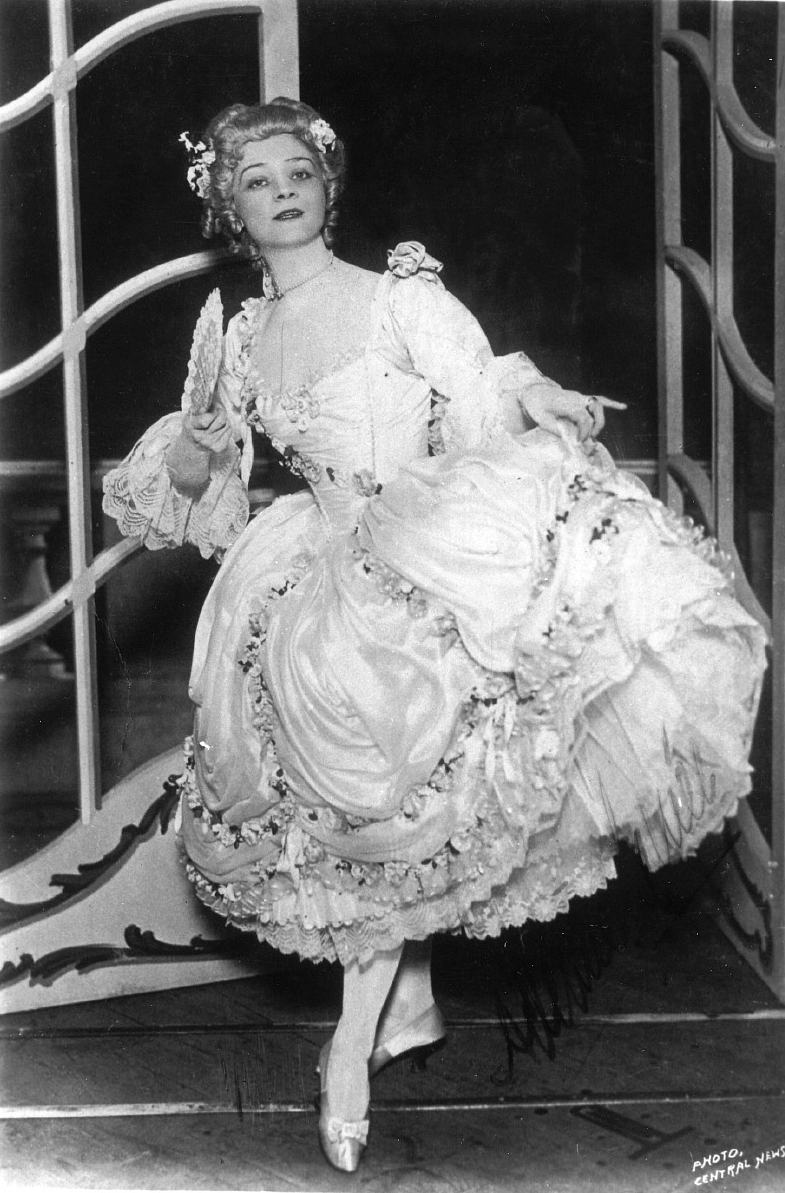
Adeline Genée:
premier of ‘La Camargo’ at the London Coliseum, 20th June 1912.
Genée was one of the very first of that new class of glamorous
artistes responsible for creating an interest in Ballet Dancing, an
art-form greatly appreciated on the continent but at that time
largely neglected in Britain. Although born in Denmark, Genée,
through her flawless technique and natural grace, became an English
institution in the years before the Great War.
All who saw her were immediately captivated by the artistry of her
work. Coming so closely after the burlesque, rough and ready
ladies operating on the boards at that time, Genée must have been a
revelation. It is interesting to note that the press comments
of the time used the same phrase constantly — “Her technical
perfection and sparkling invention” — it seems to say it all.
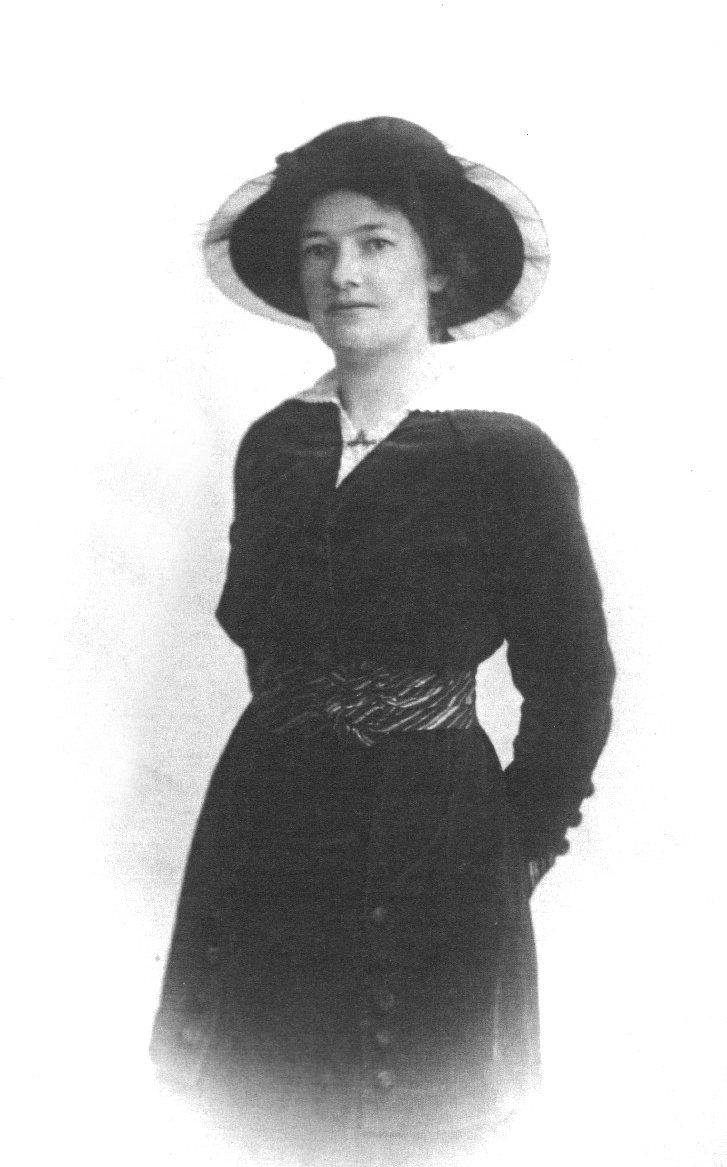 |
|
May
Cherry c. 1916: Adeline’s maid and dresser. |
My interest in Adeline Genée stems from the fact that for some years
my grandmother, May (née) Cherry, was her lady’s maid and dresser,
and she accompanied Adeline on her 1913 world tour. On my
grandmother’s death I acquired her collection of Genée mementos and
this caused me to want to learn more about her. I decided my
forays to Postcard Fairs would be a perfect place to search for
pictures of Genée, and I was not disappointed. These I found
had been published in great variety, and they open up a new window
on the whole period of the Edwardian theatre.
Genée was born in 1878 near Aarhus, Denmark, where her uncle,
Alexander Genée, owned an Academy of Dance. He quickly
recognised her outstanding talent, and in fact remained her ballet
master and impresario throughout her career. She made her
debut at the age of ten, and her first really big success came at
the Berlin Opera House in ‘The Rose of Schiras’ by Eilenbourg.
From there Genée progressed to Munich, London, then back to
Copenhagen in 1902 to dance before the King and Queen in ‘Coppelia’
in the part of Swanhilda — a role she subsequently made her own.
|
Mrs
May Gladys Vince, née Cherry, originally lived in
Williams Place, Tring, later demolished to make way
for Louisa Cottages. She left Adeline’s
service as maid and dresser when the ballerina
retired at the outbreak of the Great War, and
returned to Tring where she married. |
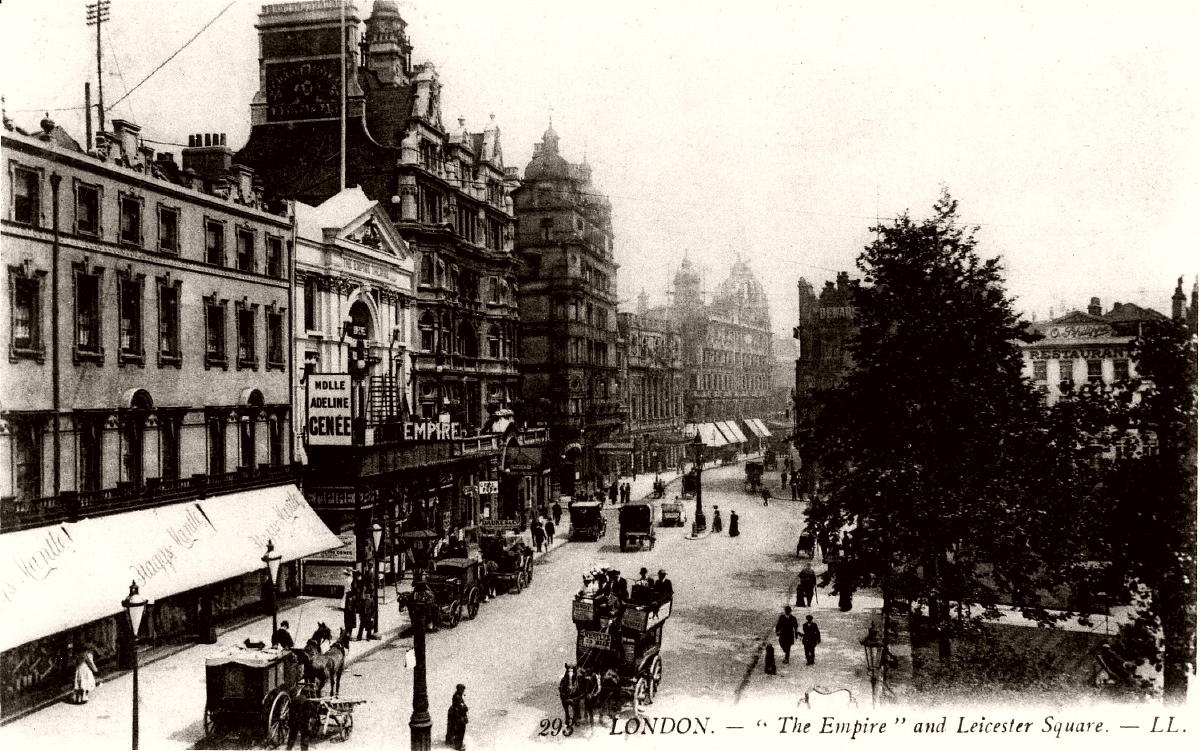
The Empire,
Leicester Square, c.1905. Genée’s name is displayed on the
billboard.
Adeline
danced here as prima ballerina from 1897 to 1907.
She first came to England in 1897 to fulfil a six weeks’ engagement
at The Empire Theatre, Leicester Square. What was intended as
a short period stretched to ten years, as her contract was
constantly renewed and new ballets were created for her. In
this time she achieved enormous popularity for her superb dancing
and expressive mime.
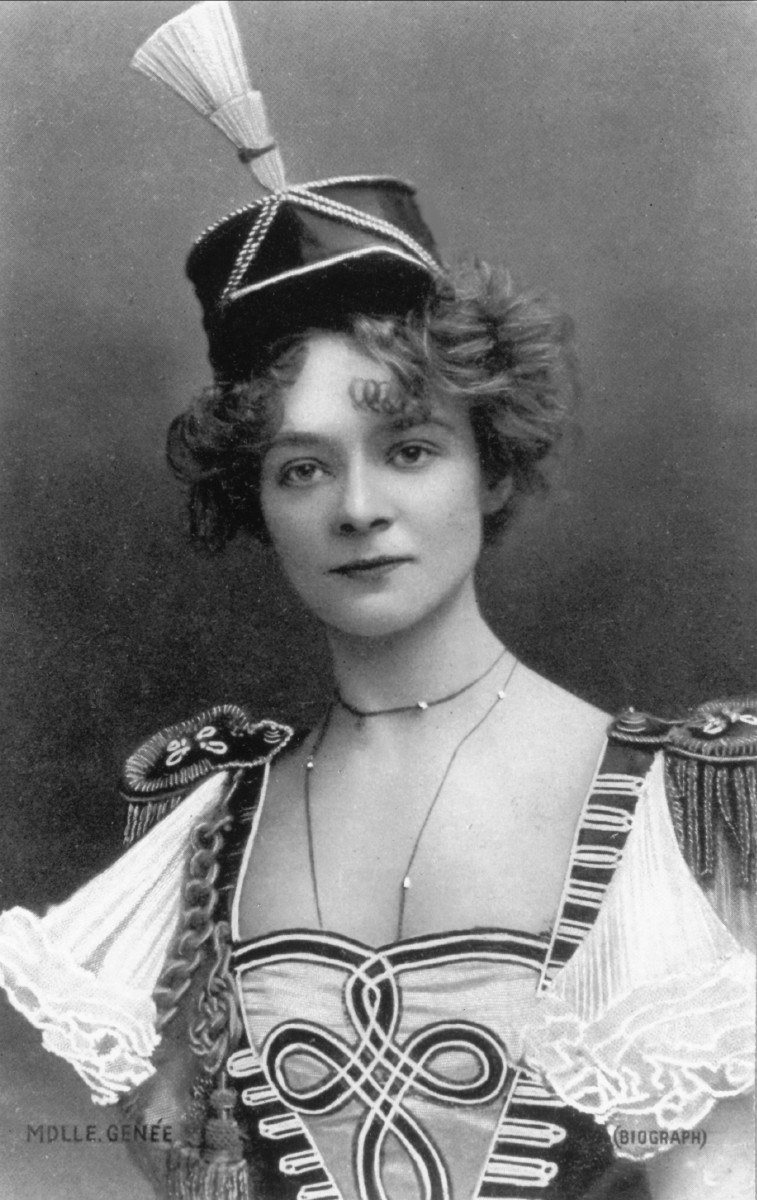
Adeline Genée in
‘The Dancing Doll’, Empire Theatre London, 1905.
The training and environment of Danish Ballet at that time was quite
as skilled as that of the Russian Ballet companies, and this seems
confirmed by the fact that Sergei Diaghilev, who was touring Europe
with his hugely successful Ballet Russe, at once recognised Genée’s
genius, and coveting her for his company, invited her to join him.
Genée, however, declined, and later privately described his
organisation as ‘a circus’, which was intended to glorify an
individual dancer, Nijinsky, rather than the art-form itself.
Like Pavlova ten years’ later, Genée was content to dance with her
own smaller and carefully-chosen company. Her artistry gave
pleasure to countless people — including officers of the ‘Titanic’
who sent a bouquet of red and white (the Danish colours) roses to
her dressing room on the night of embarkation on what was to prove
the fateful voyage.
She was toasted in song and poetry, and I quote one verse from a
poem ‘Lines to Adeline Genée’ published in 1913 (one verse is
enough! The florid Edwardian style is hardly to our taste today):
‘No sylph or faun of fabled dance,
No columbine or sprite,
Had half the power to lure and trance,
You Daughter of Delight.’ |
Genée’s long association with The Empire Theatre ensured her a place
as guest of honour at the final performance (a production of George
& Ira Gershwin’s ‘Lady, Be Good’), before it was demolished to be
rebuilt as a cinema in 1927. The star of that show, Fred
Astaire, in his curtain speech acknowledged her as the early
inspiration of his own career. When younger, he and his sister
were taken by their mother to a Ziegfeld production of ‘The Soul
Kiss’ in New York, which starred Adeline Genée. He tells that
they were brought by their mother night after night in the hope that
some of the artistry would rub off on them. Obviously in this
she succeeded.
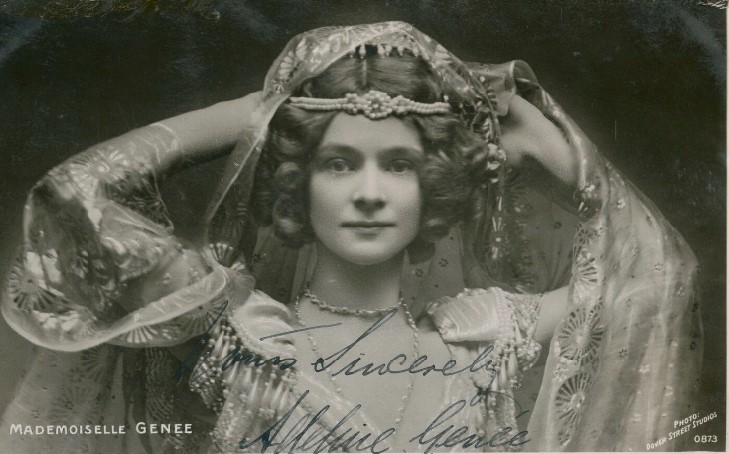
Genée in fact toured the United States six times, the first being in
1908. As in Britain, her dancing was revelation to American
audiences and she received a rapturous reception wherever she
appeared. In 1913 she took her own company to Australia and
New Zealand, the first dancer to bring the classical style to those
countries.
Genée enjoyed many triumphant seasons at London’s ‘Coliseum’, where
she presented ‘La Danse’, an authentic record of Dancing and Dancers
from 1710 to 1845. She recreated roles made famous by great
dancers of the past, including Camargo, Taglioni and Provost.
Contemporary accounts of her appearance constantly refer to Genée as
“doll-like”, “elfin”, “light as thistledown”.

Adeline c. 1916.
All this was not, however, maintained without an effort of will.
Genée was a rigid teetotaller who dined frugally at three in the
afternoon, and allowed herself only a cup of coffee at six.
After that nothing until beyond midnight. She practised for at
least five hours every day in a room walled with mirrors, so that
she could see every movement, and how it appeared to the onlooker.
Genée did not make the mistake of carrying on too long, and at the
height of her fame and popularity she retired from the stage. In
1910 she had married a wealthy English lawyer, Frank S. N. Isitt,
and at the time of her marriage had promised him she would dance for
only a few more seasons. She kept her promise, retiring in May 1914.
However, the outbreak of war brought fresh demands for her to
continue, as it was thought her great popularity would be a, morale
booster to both servicemen and the general public.
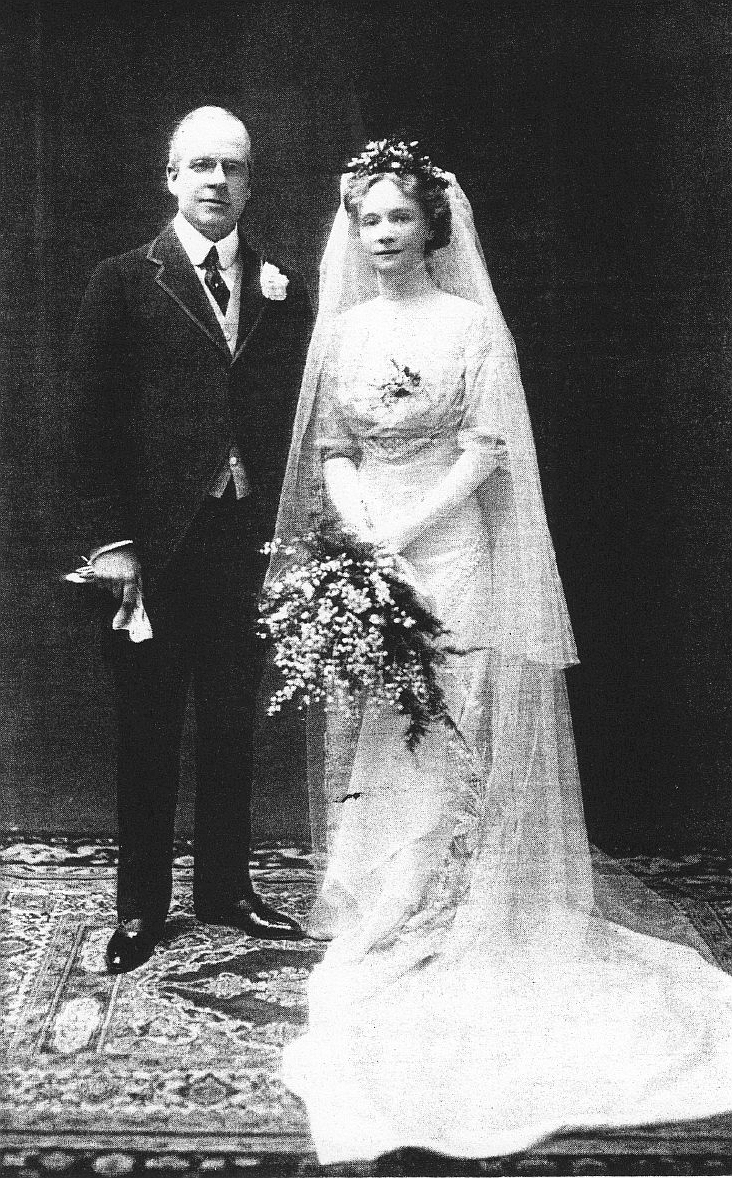
Adeline Genée and
Frank S. N. Isitt on their wedding day in 1910.
“Don’t remember me only as a dancer” she once said. Only a
third of her long life was devoted to appearing on the stage.
In retirement, she worked hard to help create the Royal Academy of
Dancing in this country, and as the first President she travelled
widely, adjudicating, teaching and helping to select good teachers
throughout the country.
Even in retirement, Genée continued to receive honours. She
was appointed a Dame of the British Empire in 1950, and in 1967 a
theatre named after her was opened in East Grinstead. Also in
that year a yellow cluster rose bred by Harkness was named after
her. She died at the great age of 92, having admitted that she
had been lucky in never having had to fight her way to stardom.
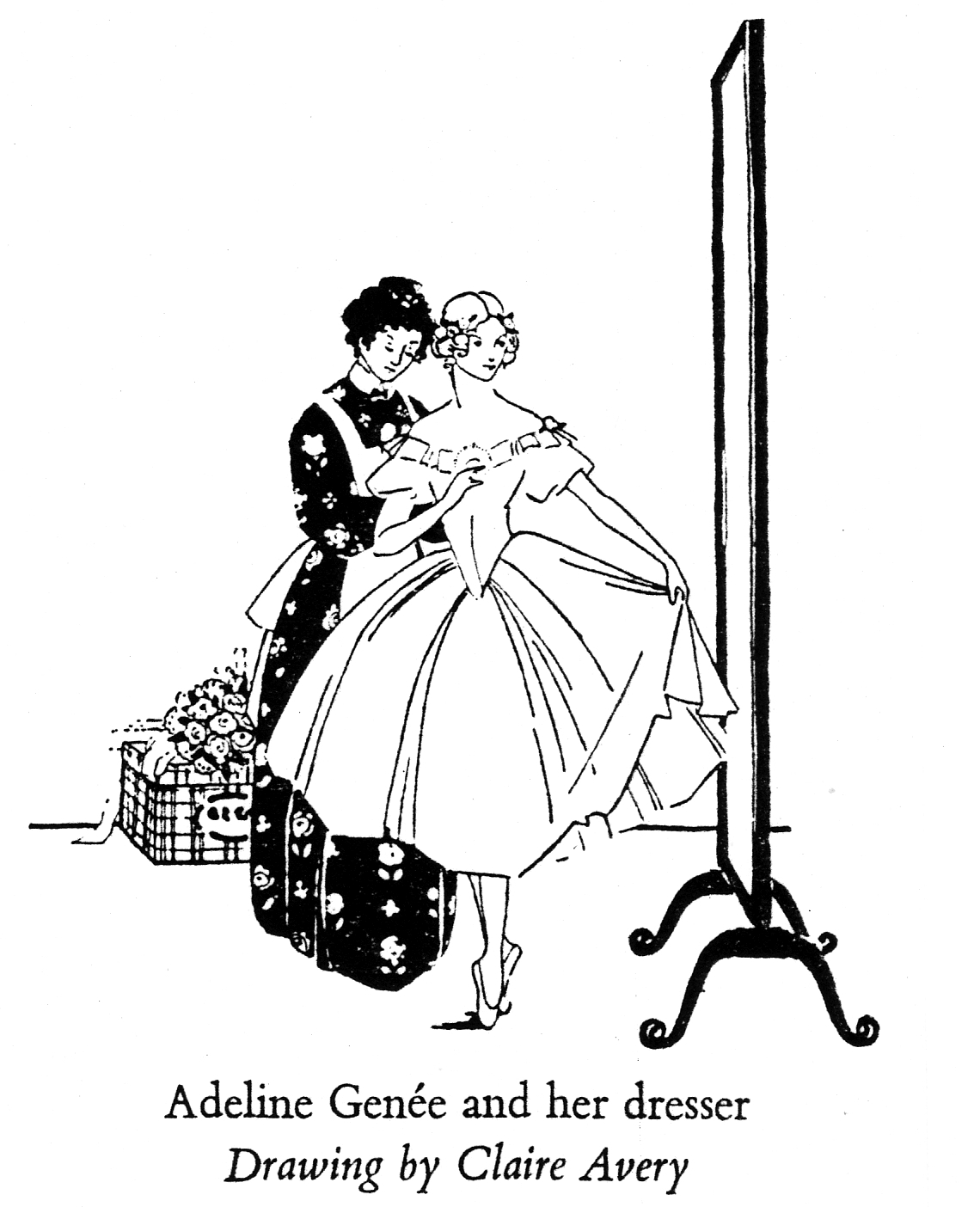
I’m sure she would have been pleased to know that at least one
person is keeping her memory alive by collecting postcards of the
time, which depict her in the graceful poses for which she was so
famous, and in beautiful costumes (which my grandmother so proudly
helped to sew and care for). If any postcard dealers read this
article, perhaps in future when I ask “Adeline Genée, please?” I
will be met with recognition of the name. So far I usually
have to add “She was a dancer, but you may have her filed under
Actresses.”
Wendy Austin
November 1994.
――――♦――――
A KING OF FRANCE IN TRING
by Wendy Austin
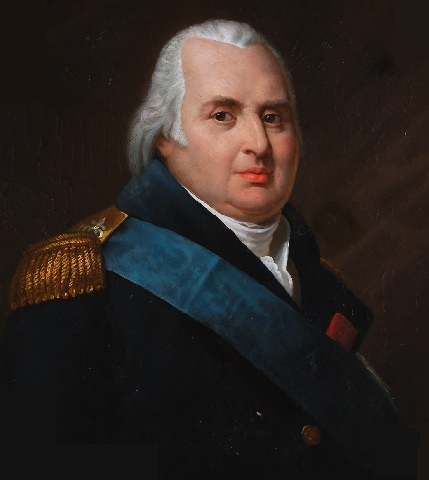
Louis XVIII of France by Antoine-Jean Gros.
Seldom has a king found reason to pass through Tring publicly, let
alone a foreign king, so when it happened it made a newsworthy item.
Thus, on 20th April 1814 the Clerk to Tring Vestry recorded the
following:
“Louis XVIII, with his
retinue, passed through Tring on his return to France to take
possession of the throne. A detachment of Bucks Yeomanry with
trumpeters, formed the escort. Aylesbury gave him a great send
off, but there was no demonstration in Tring, although a great
number of people lined the street. During the King’s residence
at Hartwell House, the British Government have allowed him £20,000
per annum.”
Hartwell House, a Jacobean mansion, lies just west of Aylesbury, and
it might be that the town accorded Louis a great send off as either
many were relieved that his departure would mean a large saving to
the British public purse, or that the businessmen of the area would
genuinely miss Louis, due to the revenue brought in by the spending
of his courtiers, numbering over one hundred. Our Prince
Regent, the future George IV, had been generous to a fellow monarch
in trouble, granting him indefinite asylum in England, and Sir
George Lee, owner of Hartwell, had no doubt welcomed the kudos and
income (£500 p.a.) afforded by renting his house to an exiled king.

Hartwell House.
Louis had been fortunate, fleeing France in 1791 and thus escaping
the fate of his beheaded brother, Louis XVI, and many of his
relations. After some years spent in the Low Countries and
Sweden, he arrived at Hartwell in 1807: it must have been rather a
squash for such a large retinue, and life in rural Buckinghamshire
not doubt proved unexciting for one accustomed to the splendours and
intrigues of court life at Versailles. The story goes that he
took to his coach as frequently as possible to rumble his way to
London along the Sparrows Herne turnpike road to seek the
entertainments that the capital provided. Tring’s Vestry
minutes inform us that he passed through the town many times during
those years, but there is no record that he stopped at the Rose &
Crown. Louis’s first port of call was the main coaching inn at
Berkhamsted where he tarried a while, having become a close friend
of the comely daughter of the landlord of the King’s Arms. (It
should be mentioned that his wife, Marie Josephine of Savoy, had
died in 1810, and again the helpful Vestry minutes record that the
cortège passed through Tring on its way to Westminster Abbey.)
Following the fall of Napoleon, restoration of the French monarchy
came in 1814 when Louis returned to Paris to be greeted with a
boisterous reception. His subsequent ten-year reign was not
especially successful, although he did attempt to heal the wounds
caused by the Revolution. Queen Victoria’s mentor, her uncle
Leopold of the Belgians, admittedly always subjective, was no
admirer of Louis and in a letter to his niece wrote “Louis XVIII was
a clever, hard-hearted man, shackled by no principle, very proud and
false.”
By the spring of 1824 Louis was suffering from obesity, gout and
gangrene in his legs and spine. He died on 16th September 1824
surrounded by the extended Royal Family and some government
officials, in the process achieving the distinction of being the
last French monarch to die while on the throne.
――――♦――――
A LETTER FROM FANNY SMITH
with thanks to Mike
Hutchinson, Tring Park Archivist
The first Smith to live at Tring Park Mansion was Sir Drummond
Smith, the first Baronet of Tring Park and the only holder of the
title ever to live there (from 1786 to 1816) [Note].
It is unclear how Sir Drummond made his money - some was probably
inherited - but he was wealthy and was looking for a country estate
to move to from his existing home in Newmarket (Chippenham House).
When Sir Drummond died without issue in 1816, the estate was sold by
his executers to William Kay, a Manchester textile magnate who later
built and operated Tring’s well-known
silk
mill. But Kay never lived in the Mansion preferring
instead his London address at York Terrace, Regent’s Park, and over
the years he and his family rented the Park to a variety of tenants
until eventually it was bought by
Rothschilds in 1872.
One of the Mansion’s first tenants were Sir Drummond Smith’s niece
Augusta and her children. The letter below, written by Frances
(Fanny), one of Augusta’s daughters, gives an interesting insight
into the life of a well-to-do family in Tring in the 1820’s:
2nd October 1828 — We
continue to like Tring exceedingly and I do hope nothing will occur
to make us leave it. I like every thing about it, house, park,
country and neighbourhood; the latter, tho’ not numerous here, have
been very civil to us and among them there are some very nice
people. The poor here are very numerous and in a wretched
state, and Sunday School is constantly increasing; Eliza and I teach
the boys, the others manage the girls. The silk mill and straw
plaiting do not, I am sorry to say, tend towards improving their
morals or manners.
Our clergyman here is a very pleasant man and has a wonderful talent
both for music and painting, it is delightful to have him play upon
the pianoforte, and if he did but happen to be married we might see
him oftener then we can venture to do now in this evil speaking
world.
Our landlord Mr. Kay has treated us with rather more visits than we
wish for. He is offensively civil, but there is an easy
vulgarity in his manner, which is almost intolerable, and yet we
want to keep on good terms with him to remain here.
We had a very agreeable visit from the Protheroes who are very nice
people indeed, and very civil to us. Their son was an old
friend of ours and introduced us to his father and mother, they have
a most charming library; it is one that requires one to recollect
the 10th commandment not to wish for it, book and bindings. I
do not know what are the best.
Miss Gerinstons two of Lord Davulan’s sisters are some very
agreeable neighbours of ours, pleasing ladylike manners and people
of a certain air without being old maidish.
From this letter Fanny gives the impression that she is thoroughly
enjoying life at Tring Park. The silk mill and straw plaiting
industries of the area seem to give her cause for concern about the
morals of the young of Tring, who have no option but to work in
them. It is nice to see the sisters helping with the education
of the young of the town.
The town gossips of the time also play on her mind. Single man
visiting the young girls, even if he was a reverend was obviously a
no, no (Mr. Lacy did go on to marry a Miss Prickett, by all accounts
with a little help from Augusta). From Fanny’s description Mr.
Kay was not a well thought of gentleman. I imagine a
self-made man who didn’t worry a fig what the gentry thought of him.
All in all life seems to be rosy for Fanny and the Smith family.
Note: Augusta’s husband would have been the 2nd
Baronet of Tring Park but he died before Drummond. Following
Sir Drummond’s death the title passed to Augusta’s son Charles as
the 2nd Baronet; he married before Augusta moved into Tring Park and
never lived there. The title Baronet of Tring Park is extant,
the sixth and present baronet being Sir John Hamilton Spencer-Smith,
born 1947 (the heir presumptive to the baronetcy is Michael Philip
Hamilton-Spencer-Smith, born 1952).
――――♦――――
MILITARY HOSPITALS IN TRING
during in the
Great War, 1914-1919
by Ian Petticrew
THE NEED FOR TEMPORARY HOSPITALS
Following the commencement of hostilities many men too badly wounded
to make a recovery abroad were returned to Britain for medical
treatment. On arrival at British ports they were
assessed in Red Cross temporary hospitals before being dispersed to
military hospitals throughout the land.
Before the
outbreak of war the British Red Cross earmarked suitable buildings
for use as temporary hospitals. What they selected varied
widely, ranging from town halls and schools to large and small
private houses. The most suitable became “auxiliary general
hospitals”, which operated as annexes to central military hospitals.
Although under military control they were administered by the Red
Cross. Each could accommodate several hundred patients in the
bedridden
category, while convalescent and ambulant patients were sent
to smaller establishments. Some specialised units were also
set up, for example to treat shell-shocked and neurasthenic
patients; in this category Craiglockhart War Hospital near Edinburgh
dealt with shell-shocked officers, among them being the war poets
Siegfried Sassoon and Wilfred Owen.
Gadebridge
Military Hospital at Hemel Hempstead, a facility for 800 men,
specialised in treating soldiers with venereal disease (in 1918
there were 60,099 hospital admissions for VD in France and Flanders
alone. By contrast, only 74,711 cases of ‘Trench Foot’ were
treated by hospitals in France and Flanders during the entire war,
a total that also includes those suffering from Frost Bite.
While rarely fatal, on average VD cases required a month of
intensive hospital treatment).
These temporary hospitals and convalescent homes were to prove vital
for easing the pressure on the main military hospitals in treating
the rapidly increasing numbers of repatriated wounded servicemen
(well over 1 million in total).

Frodsham Auxiliary Military Hospital,
Cheshire.
During the period of the hostilities over 3,000 patients were
treated there.
THE TRING MILITARY HOSPITAL
Where soldiers ended up depended largely on the
severity of their wounds. The patients at the smaller military
hospitals such as Tring did not, as a rule, have life-threatening
injuries but needed time to convalesce. That said, among his
recollections of Tring in past times, local historian Bob Grace
records that by 1915 Tring was receiving patients from the
disastrous Dardanelles Campaign.
During the war, at least three military hospitals –
probably physically separate elements of a single establishment –
are known to have existed at Tring. Very little information
about them survives; much of what there is appears in contemporary
editions of the Bucks Herald, in which the earliest reference
is to the Victoria Hall in Akeman Street:
“TO
THE EDITOR OF THE BUCKS HERALD:−DEAR SIR, In your last week’s
issue the following paragraph appeared − ‘A suggestion that the
Victoria Hall, Tring, should be equipped as a hospital for the
wounded is regarded in many quarters as somewhat premature.’ I
wish to state that it is the duty of Voluntary Aid Detachments who
work in connection with the British Red Cross Society to select
suitable buildings for temporary hospitals should they be required.
Guarantees are got from local residents for equipping these
hospitals, so that should the necessity arise they could be fitted
up at very short notice.
At present no hospital exists in Tring but should the War Office
require such, arrangements are being made by the local detachment
whereby a fully equipped hospital could be set up in a few days.
Yours truly,
WINNIFRED BOYSON,
Hon. Secretary and Commandant,
Tring Voluntary Aid Detachment.
Grove Lodge, Tring
August 20th, 1914.”
Bucks Herald, 22nd August 1914
This facility was set up initially to deal with the
large number of new recruits from the 21st
Division (part of Kitchener’s Third New Army, ‘K3’)
who were billeted in Tring while undergoing training, for this news
article refers to “illness” rather than “wounds”:
“The Victoria
Hall has been equipped as a hospital by the local Voluntary Aid
Detachment. It is furnished with six beds, and any cases of illness
amongst the recruits will be treated there.”
Bucks Herald 19th Sept. 1914

The Victoria Hall military hospital
(note sign to left of doorway).
Shortly after the military announced their intention
to extend their medical capacity in Tring:
“The military authorities are looking about for
further hospital accommodation, and in addition to utilising the
isolation hospitals of the district
[at Little Tring and Aldbury],
are contemplating taking over the High-street Schools.”
Bucks Herald, 17th Oct. 1914
. . . . and they
then moved quickly:
“Last week the military took over the High-street and
Gravelly
[at the top of
Henry Street]
Schools,
and they are now being fitted up for the
reception of cases of ordinary sickness occurring amongst the
troops. The authorities also expressed their desire to use the
Tring and Aldbury Hospitals for the reception of infectious diseases
amongst the soldiers . . . . The military patients at the
[isolation]
hospitals will be attended by Army Doctors, but beyond this the
administration of the hospitals (including the appointment of extra
nurses) will continue as at present . . . . The fee to be paid in
respect of military patients received into either hospital will be
27s. 6d. a week for each patient.”
Bucks Herald 24th Oct. 1914

Tring School (on the left).
It stood on the High Street site now occupied by the Library
and car park.
The schools’
pupils had then to be moved to temporary accommodation for the
duration:
THE
SCHOOLS:–
The children reassembled on Tuesday morning at their new quarters in
various parts of the town. All the town schools are now in the
hands of the military authorities, and are being prepared for
hospital purposes.
Buck Herald, 14th Nov. 1914
“The playgrounds at the High-street
Schools have been shut in by a high closely-boarded fence, which
makes it impossible for anyone to overlook the grounds from the
High-street. It is understood that the schools will be used as
a military hospital for the
[21st]
Division, and will take the place of the Victoria Hall, which is to
be vacated shortly.”
Bucks Herald, 19th Dec. 1914
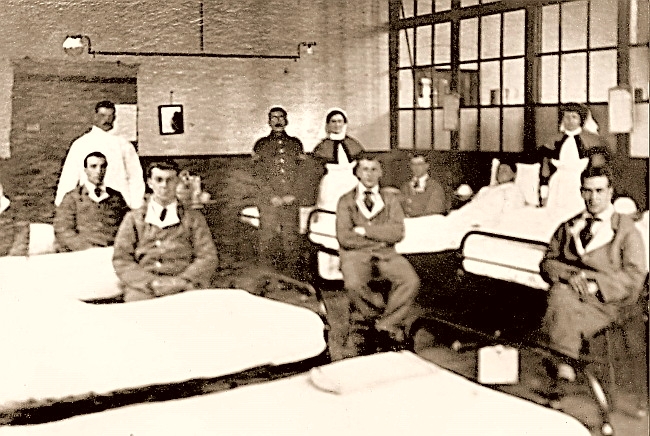
This poor quality image is all that is
known to have survived from
Tring School’s
days as a military hospital. Note the hospital uniforms.

Meanwhile the military also commandeered Tring Market
House:
“It
was reported that the military authorities had applied for the use
of the Market House as a depot for hospital stores. The
Chairman, after consultation with the Chairman of the Market House
Committee, had granted the use of the building, and his action was
confirmed. It was left to the Market House Committee to fix a
charge to cover the cost of light and firing should these be
required.”
Bucks Herald, 17th Oct. 1914
Following the requisition of the schools their pupils
were moved to various locations in the Town. Boys went to the
Church House and Market House, girls to the Lecture Hall in the High
Street Free Church and to the Western Hall (now the site of Stanley
Gardens), while infants were sent to the Sunday School room in the
Akeman Street Baptist Chapel, while the YMCA building in Tabernacle
Yard (off Akeman Street) was opened as a writing and reading room
for soldiers, for whom bathing facilities were installed in the
Museum outbuildings. Although used for social purposes, it
seems that the Victoria Hall continued to serve as a medical
facility until at least 1916:
“On Wednesday evening a soldier of the Herts
Territorials, while cycling near Ivinghoe, came into collision with
a motor car. He was thrown from his machine, and his collar
bone dislocated. He was put into a car and driven to the
military hospital, Victoria Hall, Tring, where his injuries were
attended to, and he was afterwards moved to the military hospital at
Aylesbury.”
Bucks Herald, 27th May 1916
In 1916 a Zeppelin is believed to have passed over Tring on its way
to bomb London. The military hospital was made ready to
receive the expected casualties from an air raid on the town:
“ZEP
SCARE:–Soon after midnight on Saturday a warning to prepare for an
air raid came through. Specials and firemen were at once
called out, and at the military hospital preparations were made for
the reception of casualties. How near the Zeppelin came to
Tring is uncertain, but the light from the one that was set on fire
and which fell at Cuffley was distinctly visible in the town
illuminating a wide area, and the noise made by the engines was
plainly heard. It was 4.30 on Sunday morning before the danger
was reported over, and the tired specials and others were permitted
to return to their beds.”
Bucks Herald,
Sept. 9th 1916
ORGANISATION AND NURSING
No information exists on how the Tring Military
Hospital was organised, but the pattern followed was probably the
same as that applying to similar establishments elsewhere:–
-
a Commandant in charge of the hospital;
-
a Matron (or equivalent) who directed the nursing
staff;
-
a Quartermaster responsible for the receipt,
custody and issue of articles from the
provisions store;
-
members of the local Voluntary Aid Detachment
(VAD) who were trained in first aid and home nursing.
Local GPs sometimes helped, while women and those too old to work in
a main military hospital often volunteered for part-time work.
There were also some paid roles, such as cooks. The Bucks
Herald makes a couple of references to those who worked at
Tring:
“A VETERAN
HOSPITAL
ORDERLY:– ‘Bob’ Matthews, one of the best known and most esteemed of
the R.A.M.C.
[Royal Army
Medical Corps]
orderlies at the
Tring Military Hospital, has a record of service of which he may
well be proud, and it is creditable to him that he is still able and
willing to carry on such splendid work, although much of it may be
of a menial character. Residing at Maidenhead, he assisted in
the formation of the local Red Cross detachment, and was one of the
first to answer the call for volunteers at the beginning of the war.
He has to his credit some 30 years’
service in the Berks Volunteers, and held the Long Service Medal,
retiring with the rank of sergeant. Keenly interested in the
friendly society movement, his work for his local Court of Foresters
was of a most useful character, and his interest in sport made him a
keen supporter of the local football clubs, whilst with the patients
and staff at the hospital ‘Bob’ is most popular, and most energetic
in carrying out his duties.”
Bucks Herald, 19th May 1917
“THE
HOSPITAL:–
Much regret is felt at the removal of Captain A. Holland Wade, who
has been transferred to another military hospital in the eastern
Counties. During the ten months he has had charge of the Tring
Military Hospital, Captain Wade has made many friends in the town,
and his loss will be felt, especially in the organisation of
concerts, for several of which he has been responsible during the
spring and summer, greatly to the benefit of a number of deserving
war charities. Possessing a fine baritone voice, Captain Wade
was always a welcome addition to any programme, and made frequent
appearance at the Y.M.C.A. concerts. The good wishes of all go
with him to his new sphere of labour.”
Bucks Herald, 27th Oct. 1917
Among those undertaking pastoral duties was the Rev.
Charles Pearce, a local non-conformist clergyman. Later in the
war, in addition to his already considerable duties, the Rev. Pearce
received the distinction of being appointed Officiating Chaplain in
local military hospitals to the Wesleyans, Presbyterians,
Congregationalists, Primitive and United Methodists, and Baptists,
thus filling the unique position of representing all of the Free
Churches.
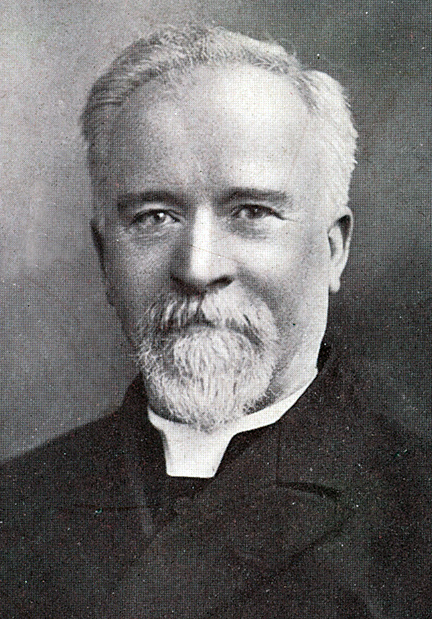
The Rev. Charles Pearce.
In 1915, Rev. Pearce wrote to the Editor of the
Bucks Herald
acknowledging the efforts of the medical staff at the three military
hospitals (presumably the High Street School, Gravelly School and
the Victoria Hall):
Fernlea, High Street, Tring.
10th November
1915.
Dear Sir,
Much, but not too much, has been
written about the officers and men of Halton Camp and at the Front.
I believe you will think a line or two about our Hospitals worthy a
place in your valuable paper. Neither rose nor rainbow gain
anything from painter or poet, and deeds of mercy require no
flourish of the pen. A simple statement will be enough to show
the skill, sympathy, and success of the doctors, their staff, and
assistants. We have had three Military Hospitals in Tring for
considerably over 12 months (a number of the wounded from the Front
are now here); but, as far as I remember, we have had only three
deaths. Surely this must form a record. Some of these
were very seriously ill before admittance. I have been deeply
touched by the tears in the tone: “We did our very best, but could
not save him”. The men seem to have undoubted confidence in
the medical staff and their helpers. The monotony of indoor
life is just now largely increased by the darkened windows.
But all are hopeful of brighter days.
Yours etc.,
Charles Pearce, Army Chaplain
County branches of the Red Cross had their own groups of volunteers
called Voluntary Aid Detachments, whose members came to be known
simply as ‘VADs’. Made up of men and women who had to pass
exams to receive their first aid and home nursing certificates, the
VADs carried out a range of voluntary work including nursing and
transport duties:
“The military hospital at the Victoria Hall is in
charge of the R.A.M.C.,
who are working in conjunction with the Voluntary Aid Detachment . .
. . The result of the recent examination for first-aid certificates
was not satisfactory, only three men being successful. As the War
Office will only recognise a Voluntary Aid Detachment in which there
are at least twelve certified men, it is felt desirable that
opportunities should be afforded to enable others to qualify. A
second course of instruction will be arranged, should a sufficient
numb er of men signify their intention to join. There would be two
meetings a week – one for instruction and one for practice. The
Sergt-Major in charge of the R.A.M.C. Detachment at the Victoria
Hall has promised his help . . . .”
Buck Herald, 17th October 1914
Although the Buck Herald report placed an
emphasis on the need for men, by the summer of 1914, of the 74,000
VAD members, at least two-thirds were women.
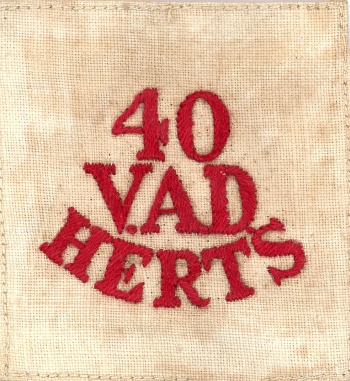
Ada Jordan’s VAD
arm-band.
Ada Jordan (aged 17), daughter of Karl Jordan, a
Curator at Tring Museum, when serving as a V.A.D. found that some of
the soldiers in the hospital where she worked refused to be nursed
by her when they discovered that her father was German by birth,
even though a naturalised British citizen.
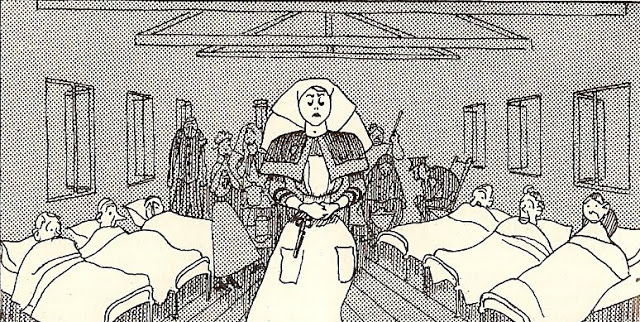
|
Cartoon of Wandsworth
Military Hospital.
Following the commencement of hostilities,
Fanny Girardet,
Tring’s
long-serving indefatigable district nurse, offered
her services to the Red Cross. She was posted to
the military hospital on Wandsworth Common. In
1916, her name appeared in the Birthday Honours List
when she was awarded the Royal Red Cross Medal, a
military decoration awarded in the United Kingdom and
Commonwealth for exceptional services in military
nursing. |
THE LITTLE TRING ISOLATION HOSPITAL
“The
[Town] Clerk reported
that Major Prynne, the principal medical officer of the 21st
Division, had called on him and explained that the Military
authorities desired to use the [Isolation] Hospital at Tring for
scarlet fever and diphtheria, and the Aldbury
[Isolation] Hospital for enteric
[typhoid]. At Aldbury they
were willing to allow use of the hospital for enteric on the same
terms as they charged patients from Tring, viz., 27s. a week; and
were prepared to erect tents or other accommodation if necessary.
Dr. Brown said that Major Prynne stated at Aldbury that the military
authorities did not wish their men to go into tents. In reply
to several Councillors, who pointed out the inconvenience of the
proposed arrangement, the Chairman said he was afraid they could not
help themselves. They would have to do whatever the military
authorities decided.”
Bucks Herald, 17th October 1914
This was an age in which serious infectious diseases such a
diphtheria, scarlet fever and smallpox were at large. Thus,
while continuing to serve the needs of the civilian population, the
Little Tring Isolation Hospital received patients from among the
soldiers billeted in Tring or based at the Halton military camp, and
temporary accommodation (military huts) was erected in the hospital
grounds to house them.
The military were given powers that permitted them to dictate how
the hospitals were to be used with regard to the civilian
population. Following a further meeting with the military the
Tring Urban District Council received a memorandum on the subject:
“The military
authorities desire to use the Tring Hospital for enteric fever
[typhoid], and the Aldbury Hospital for
scarlet fever and diphtheria, and this will necessitate the local
authorities [Tring and Berkhamstead]
using the hospitals in the same way. The only exception to
this will be that if one of the hospitals is standing empty the
military authorities will raise no objection to is being used
temporarily for any kind of infectious disease from its own
district, provided that reasonable accommodation is always kept
available at each hospital for the disease which the military
authorities have arranged should be dealt with there. The
cases at the two hospitals are to remain until discharged in the
ordinary way.”
Bucks Herald, 24th October
1914
A
later press report suggests that the military section of the
Isolation Hospital had its own commandant and did not form a part of
the Tring Military Hospital:
“CAPTAIN
SHAW,
R.A.M.C.:–Eulogistic reference was made in the House of Commons on
Tuesday to the services of this medical officer in the epidemic of
cerebro-spinal fever
[meningitis]
which has occurred among young naval officers at Cambridge. Captain
Shaw is in charge of the Isolation Hospital, Tring, where he has
done splendid work in combating this dread disease, and for the past
six weeks has been lent to the Admiralty for special service at
Cambridge.”
Bucks Herald, 22nd March 1919
Overcrowding appears to have been a problem at times:
“THE
HOSPITAL:–The
[Town] Clerk
reported that complaints had been made as to overcrowding at the
[Tring]
Isolation Hospital. Beds for 40 patients were provided, and 70
men had been taken in. He had written to the Military
Authorities, and told them that the Council could not accept
responsibility for any consequences of overcrowding,–The Matron
reported that 62 patients had been admitted: 22 with measles, 29
scarlet fever and 12 diphtheria cases. Fifty-three patients
had been discharged, and 3 died.”
Bucks Herald, 20th May 1916
The article does
not distinguish the split between military and civilian in the
statistics, but some deaths were reported in the press, such
as that of Private Arthur Baxter, son of Mr. H. E. Baxter, of
Walsoken, Wisbech, Cambs. Arthur is buried in Tring Cemetery
(grave ref. F18):
MILITARY FUNERAL:–A young private
of the Cambs. Territorials was buried with full military honours on
Monday afternoon. He died in the Tring Isolation Hospital, to which
he had been removed from Halton Camp, suffering with scarlet fever.
Bucks Herald, 10th June 1916
|
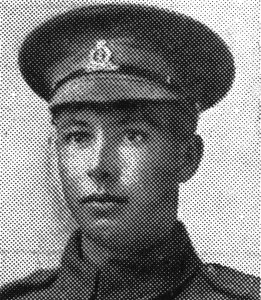 |
|
Private Heaton Bailey, R.A.M.C. |
Rather more is known about Private Heaton Bailey,
R.A.M.C., son of Mr. and Mrs. J. Bailey, Bolton Road, Silsden,
Yorkshire, who is reported to have died of pneumonia at Tring on the
6th March 1918, aged 19 years. On 25th August 1917 Private
Bailey was transferred to 1st Training Battalion, R.A.M.C. at
Blackpool. Between 14th November 1917 and 19th December 1917
he was admitted to the Military Hospital, Kirkham near Preston with
Influenza. On 10th January 1918 he was posted to No 9
Company at Colchester, then transferred to Aylesbury for
hospital training. After working for some time at the Military
Hospital, he acted as orderly in the isolation ward of a
neighbouring hospital. Whilst there, he contracted scarlet
fever, and after being removed to hospital in Tring (probably the
Isolation Hospital), he had another attack of pneumonia in addition
to the fever. His condition became worse, and his parents were
only able to reach the hospital shortly before he died, although he
was unconscious when they arrived (obituary in the Keighley Boys
Grammar School magazine, edition Nov. 1918).
It appears that the Forces Chaplain (Rev. Pearce)
held the Isolation Hospital’s
long-suffering Matron in high esteem, for he wrote to the Editor of
the Bucks Herald heaping his praise on her:
“We cannot but admire and feel grateful to the Matron
at our Isolation Hospital. She has done well under the most
trying circumstances. She came to a comparatively quiet
resting place, but since the military occupation, and all the new
[in fact temporary]
buildings, the work has been enough to tax the skill and strength of
the most devoted; her ability and love have enabled her to bear the
burden and discharge her duties so splendidly. We have nothing
but praise for all responsible for our hospitals in the town, and we
have never heard a complaint from one of the sufferers under their
charge, but many have expressed their surprise at the patience and
tenderness with which they have been treated.”
Bucks Herald, 3rd June 1916
At an Urban District Council meeting in February
1917, the Matron reported:
“17 patients admitted during the month; 4 discharged;
17 remaining in the hospital. She applied for an honorarium
for extra work since the Hospital had been used for the military.
From 1914 to the beginning of 1917, 266 military patients had been
admitted, and much extra work thereby entailed.”
Bucks Herald, 17th Feb. 1917
Both the
Matron and her nurse later received their honorarium, but in
reporting this the Editor of the Bucks Herald failed (discreetly)
to disclose the amount.
ENTERTAINMENT AND LEISURE
As for the relaxation of patients during their recuperation, there
are numerous reports in the local press of visits and of concerts
organised in the town, often by the military and with a military
input to the entertainment. For example:
“GIFTS
TO SICK SOLDIERS.–On Christmas afternoon Councillors the Rev. C.
Pearce and Messrs. R. W. Allison. Bentley Asquith, and T. H. Hedges
visited the two military hospitals and distributed cigarettes to the
inmates, and also gave the nurses boxes of chocolates. These
gifts had been subscribed for by the townspeople as a Christmas gift
for the strangers within the gate. The recipients were
surprised and delighted with the present, and the generous and
kindly feeling which prompted it, and several grateful letters of
acknowledgment have been received. About 15,000 cigarettes
were distributed, and these, as well as the chocolates, were all
obtained through local tradesmen.”
Bucks Herald,
2nd Jan. 1915
“GRAND
ENTERTAINMENT:–
In aid of the Officer Prisoners of War Fund, an excellent programme
was submitted at the Victoria Hall on Wednesday evening. The
arrangements were in the capable hands of Lieut. A. Holland Wade,
R.A.M.C., medical officer at the local Military Hospital, and it is
not too much to say that in every detail they were perfect, and the
concert in every way a complete success . . . . Lieut. Holland Wade,
whose vocal powers are well known to local audiences, made two
appearances, and was deservedly encored.”
Bucks Herald, 28th April 1917
Added to the entertainments at the Victoria Hall were
occasional outings (note the American contingent):
“HOSPITAL
PATIENTS:–
The patients at the hospital enjoyed a pleasant drive on Wednesday
to Berkhamsted, returning via Ashridge and Aldbury. The men
are grateful to Lady Rothschild for her kindness in making possible
such enjoyable outings. Amongst the party were several
American soldiers, who were much impressed by the beauties of the
surrounding country.”
Bucks Herald, 20th Oct 1917
“HOSPITAL
PATIENTS:–
On Wednesday afternoon the patients at the local military hospitals
had a most pleasant drive in brakes to Aylesbury and home via
Wendover and the Camps. They were accompanied by the Rev.
Charles Pearce, O.C.”
Bucks Herald, 1st June 1918
|
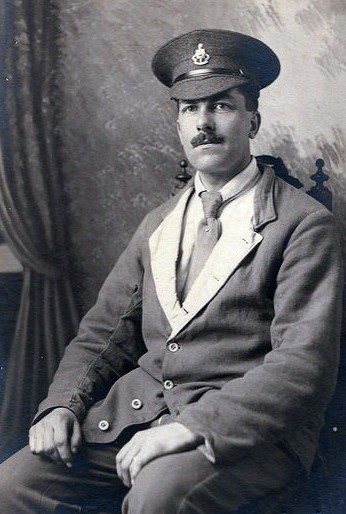 |
|
A soldier
wearing hospital blues. |
During the period that the soldiers of the 21st
Division were billeted in Tring, William Mead, wealthy owner of the
Tring Flour Mill, fitted an annexe to the mill containing two
enormous baths for their use. He also invited wounded soldiers
for drives around the countryside in his steam lorry, finishing with
refreshments and games at the mill; those too ill to attend he
visited in the various local military hospitals.
“HOSPITAL PATIENTS ENTERTAINED:−Through the
kindness of Mr. W. N. Mead, the patients and staff of the Military
Hospital spent a happy time at Gamnel Wharf on Wednesday afternoon.
They were met on arrival by Mr. and Mrs. Mead, who has made every
arrangement for the pleasure of the men. Not the least
interesting item was a tour through the extensive flour mills, where
the work of many machines aroused great interest, which was enhanced
by the explicit explanation of the process by Mr. Mead. A
feature of the outing was a trip on the canal in a decorated barge,
the voyage to the Cow Roast and back, under the direction of Mr.
Mead as skipper, being most enjoyable. Bowls and other games
were provided in the delightful gardens and grounds, in which the
men and the staff took part.”
Bucks Herald,
14th July 1917
The photographs below are an example of the hospitality and
entertainment arranged by William Mead for wounded servicemen.
The soldiers embarking in the bow of one of Mead’s
barges (the Victoria) for a leisure trip on the Grand
Junction Canal are wearing
“hospital blues.”
This form of uniform was intended to ensure that convalescing
soldiers had a uniform they could wear in public, thereby avoiding
the risk of attracting white feathers from zealous armchair patriots
and accusations that they were not doing their bit for King and
Country.
|
|
|
.jpg)
.JPG)
.jpg)
A band of military musicians are seated
under the tarpaulin.
|
THE RETURN OF PEACE
When peace returned, the town gradually regained something
approaching normality, given that the Spanish influenza pandemic and
the coal and rail strikes had first to be endured. In those of
Tring’s buildings that had formed the military hospital, medical
supplies were packed up and sent back to Government stores.
During 1919, children returned to their pre-war
schoolrooms having spent four and a half years in unsuitable and
sometimes cold makeshift conditions. Collections were made in
the cinema (The Empire, Akeman Street) for the King’s Fund for the
Disabled, and books for the wounded were gathered and sent to the
Library Branch of the British Red Cross. A Victory Ball had
been held at the Victoria Hall, the
Bucks Herald reporting that the Hall was “profusely
decorated”; nearly 200 attended, most wearing fancy dress or
uniform, proceeds from the event being donated to the Local Hospital
Supply Depot.
――――♦――――
THE TRING AND AYLESBURY TRAMWAY
that might have been.
by Ian Petticrew
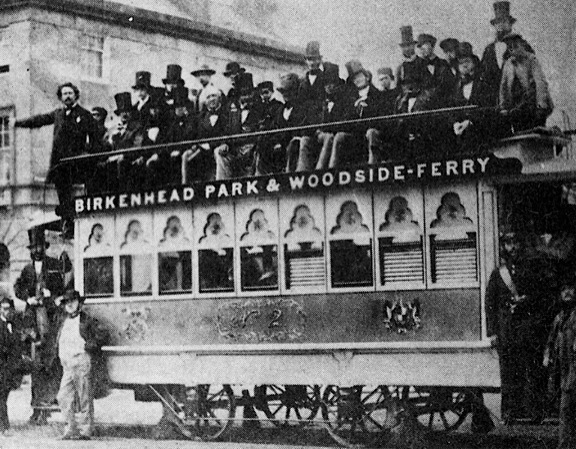
The opening of the Birkenhead Street
Railway Company, 30th August 1860.
George Train is pictured on the top deck with arm outstretched.
The street tramway arrived in Britain in 1860 when American
entrepreneur George Train opened a short line at Birkenhead.
Although his trams proved popular with their passengers, the tramway
suffered the drawback of using rails that protruded above the road
surface, thereby obstructing other road users. These were
later replaced with grooved rails and before
long most of Britain’s cities and towns of any size had trams, which
not only gave passengers a more comfortable ride than horse buses,
but the low rolling resistance of metal wheels on steel rails
allowed a greater load to be hauled for a given effort.
As for Train’s line, it eventually grew into a fairly extensive
street tramway system run by Birkenhead Corporation, which survived
until motor buses eventually took over in 1937.

Grooved tramlines.
Motive power was at first provided by horses, but in the age of
steam it was not long before attempts were made to replace teams of
horses with small steam locomotives, or ‘tram engines’. But
due to their restricted size, steam tram engines were usually
underpowered added to which their heavy maintenance requirement –
lighting the fire, removing ash and soot, periodically replenishing
water and coke (coke because they had to be smoke-free) and
lubricating – added to operational expense. One commentator
writing in 1889 gave the passenger’s perspective: “passengers
are choked with sulphurous vapour and buried in smuts if they
attempt a long journey on a steam-tram.” It is therefore
unsurprising that when electric traction became feasible in
the 1890s (the current being distributed by overhead cables), the
steam tram engine quickly faded from the scene.
However, one steam system did survive and in this area. Opened
in 1887, the 2½-mile Wolverton and Stony Stratford Tramway
brought workers from outlying districts into the London & North
Western Railway’s large carriage works at Wolverton. This
steam tramway ran until 1926, by which time it had earned the dual
distinctions of having the largest trailer cars to run in Britain
(seating 100 passengers) and being our last steam-worked street
tramway.
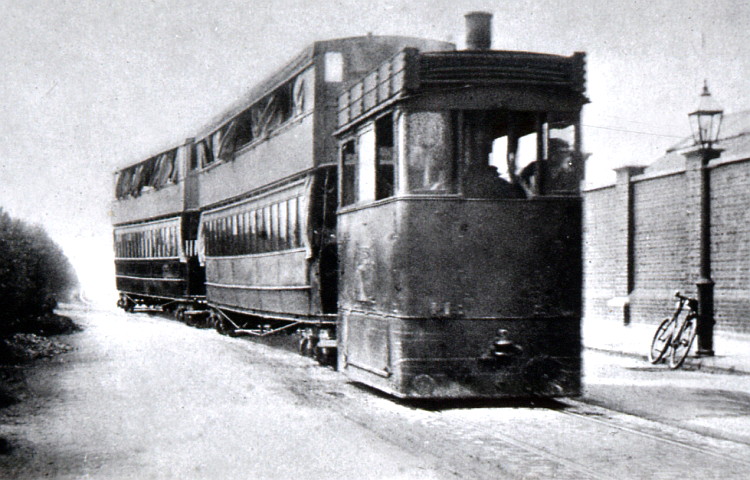
A Wolverton steam tram and trailers.
THE TRING AND AYLESBURY TRAMWAY PLAN: in 1887, reports and
notices appeared in the local press of a plan to build a tramway
linking Tring Station, via the town, with Aylesbury; the notices do
not mention whether that system was to be steam or horse powered,
but taking account of the length of the line and its gradients,
steam seems more likely. At the same time a grander scheme was
announced for a steam tramway linking Hemel Hempstead,
Boxmoor, Chesham, Berkhamstead and Northchurch:
A NEW TRAMWAY. ― A tramway is contemplated from Aldbury and
Tring in the county of Hertford: and Drayton Beauchamp, Buckland,
Aston Clinton, Weston Turville, and Aylesbury, in the county of
Buckingham. A system is also contemplated to connect the towns of
Berkhamstead, Northchurch, Chesham, Hemel Hempstead, and Boxmoor.
Bucks Herald, 22nd November 1887.
Descriptions of the route and its gradients survive in the
Hertfordshire Archive, which show that detailed surveying must have
been carried out before the announcements were made. To
protect the road surface, where practicable the trams were to run on
waste land at the side of the road. The tramway was to
commence opposite the goods entrance to Tring Station, cross the
Grand Junction Canal over the existing bridge and proceed up Station
Road (gradient 1:65) to Tring Lodge, after which there would then be
a short descent (1:20) to Brook Street. The line would climb
steeply at Frogmore Street (1:18) followed by a gradual ascent to
the summit of Tring Hill (1:48) before descending (1:20) to the Vale
of Aylesbury after which the route to the Aylesbury terminus was to
be comparatively level (1:100).
|
Miles |
Halting places |
Miles |
Halting places |
|
0 |
Tring Station |
4.63 |
White Lion PH |
|
1.25 |
Beechgrove House |
5.13 |
Rose & Crown PH |
|
1.50 |
Brook St. |
5.75 |
Vatche Farm |
|
1.75 |
Frogmore St. |
6.13 |
Aston Clinton Village |
|
2.25 |
Britannia Inn |
6.75 |
Broughton Farm |
|
3.38 |
Tring Hall |
7.50 |
Broughton House |
|
3.75 |
Gasworks |
8.25 |
Condensed Milk Works |
|
4.38 |
The
Junipers |
8.50 |
Park St. |
The press reports do not mention to what extent the scheme was
supported by the general public, but there were objectors:
THE TRAMWAY SCHEME. ― A Tring correspondent writes: We
understand that Lord Rothschild, Mr. Williams, and other owners of
property in the narrow part of the High-street have objected on
public grounds to the laying of the Tramway there. Even with
the present traffic the street is narrow and insufficient, and
accidents, especially on market days, are not infrequent. The
promoters will, it is thought, abandon the scheme, without incurring
the expense which opposition at a later stage of the order would
entail upon them.
Bucks Herald, 17th November 1887.
When the Tring Local Board (predecessor of the Tring Urban District
Council) met to discuss the scheme, their main concern was that part
of the High Street was too narrow to meet statutory
requirements:
LOCAL BOARD.― At the meeting of this Board on Thursday there
were present Mr. Butcher (chairman), Dr. Pope, and Messrs. Smith,
Chappell, Humphrey, Grange, Crouch, and Elliman; The Clerk (Mr. A.
W. Vaisey), and the Inspector (Mr. Baines).― The Clerk read a letter
from Mr. Battams, the solicitor to the Promoters of the proposed
tramway between Tring and Aylesbury, with reference to the posting
of the notices; and he also laid on the table the plans and sections
of the proposed line.
A discussion followed on the Board’s position on the matter.
The Clerk read several sections of the Tramways’ Act, 1870, which
referred to the position of the Board with regard to the persons
interested in that portion of the High-street which was too narrow
to allow the required width on each side of the rails.― Mr. Elliman
thought they should not forget that the tramways would give
facilities for getting about, and that they were generally
advantageous to a town. It might be the wish of the
townspeople to have the tramway.― After some discussion, the Clerks
was directed to issue a circular, drawing the attention of the
inhabitants to section 9 of the Act of 1870, which provides for the
case in which the street is too narrow to admit a width of “9 feet 6
inches between the outside of the footpath on either side of the
roadway and the nearest rail of the tramway.”
Bucks Herald, 3rd December 1887.
The Tring and Aylesbury Tramway scheme was finally laid to rest when
its promoters met with Lord Rothschild – Lord of the Manor of Tring
and a substantial and wealthy landowner in the town – whose main
objection to the tramway was that it would not be a financial
success. If true, how this would affect anyone other than the
scheme’s promoters and shareholders is unclear, for they would
probably have been required to arrange a bond to cover the cost of
road clearance should the scheme fail. The following newspaper
report refers to
“other objections”, which presumably included the narrowness of
the High Street (folklore has it that he also objected to trams
running past his residence):
THE PROPOSED TRAMWAYS SCHEME.―
It is stated that Mr. Wilkinson, the promoter of these schemes,
accompanied by the solicitor and the engineer, had an interview with
Lord Rothschild, Messrs. Leopold and Alfred de Rothschild being also
present, at New Court, St. Swithin’s-lane, on Wednesday, as to the
proposed line from Tring to Aylesbury, and that his Lordship having
intimated that the line would not received his support because,
among other objections to the scheme, he considered it was a line
which would not be a financial success, it was decided to abandon
the project. But as his Lordship at the same time intimated
that he felt certain that the line from Chesham to Hempstead would
be supplying a long-felt want to the district, and also prove a
certain commercial success, it has been decided to press forward the
project with the upmost vigour.
Bucks Herald, 24th December 1887.
What is surprising is that the tramway promoters appear not to have
foreseen such predictable obstacles before incurring surveying,
planning, legal and parliamentary costs. To modern eyes it
might also appear surprising that the word of Lord Rothschild should
carry such weight in the matter, but this was an age when the
peerage had considerably more influence than today, as was evidenced
when Robert Stephenson brought the London & Birmingham Railway Bill
to Parliament in 1832, only to have it thrown out – at great
cost to the Company – by Lord Brownlow of Ashridge and a coterie of
peers who objected to railways in general.
As for the Hemel Hempstead steam tramway scheme, it too sank without
trace. Newspaper reports of the time suggest that although it
met with widespread approval among the general public, there were
influential objectors among whom was Sir A. P. Paston-Cooper,
a land owner in the Hemel area (whose ancestor’s objections had
caused the London & Birmingham Railway to be diverted from the Gade
into the Bulbourne Valley). The press reports that Cooper “thought
the tramway horrid. People in London liked to come into the
country to enjoy the peace and quiet there, but would they come if a
beastly tramway were introduced?”
On the 11th August, 1888, a short notice appeared in the Bucks
Herald to the effect that the Hemel Steam Tramways Bill had
received the Royal assent, thereby becoming an Act of Parliament.
But despite having overcome all the legal obstacles to its
construction nothing further is heard of the scheme, which was
probably abandoned owing to lack of finance.
THE STATUTORY NOTICE
Bucks Herald, 26th November 1887.
BOARD OF TRADE ― SESSION
1888.
TRING AND AYLESBURY TRAMWAYS
―――――――――
(Construction of Tramways; Gauge; Motive Power; Tolls; Agreement
with Local and Road Authorities; Amendment of Act.)
―――――――――
NOTICE IS HEREBY GIVEN,
That application is intended to be made to the Board of Trade in the
ensuing Session for a Provisional Order under the Tramways Act,
1870, for the purpose or some of the purposes following, that is to
say:
To authorise a company to be incorporated in accordance with the
rules and regulations of the Board of Trade, or any other Company or
Corporation, Person or Persons, to be named in the Draft Provisional
Order (hereinafter called the Promoters), to construct and maintain
the following Tramways or some part or parts thereof, that is to
say:
Tramway No. 1, commencing in the parish of Aldbury, in the County of
Hertford, at a point opposite the Goods Entrance of the Tring
Station of the London and North-Western railway, thence passing in a
south-westerly direction over the Grand Junction Canal, and thence
along the road leading to Tring and along the High Street, Tring,
passing Brook Street and Frogmore Street, along the Western Road
leading to Aylesbury, passing Miswell Lane and Chapel Street, and
terminating at a point opposite the Britannia Inn, in the parish of
Tring in the same County.
Tramway No. 1 will be a single line, except at the following places,
where it will be a double line:― From a point 4 chains measured in a
south-westerly direction from the commencement of the Tramway for a
distance of 3 chains measured in a south-westerly direction.
From a point opposite the road leading to Tring Grove, for a
distance of 3 chains measured in a south-westerly direction.
From a point 4 chains measured in a north-easterly direction from
the termination of the Tramway for a distance of 3 chains measured
in a south-westerly direction.
Tramway No. 1 is proposed to be laid that for a distance of 30 feet
and upwards a less space than 9 feet 6 inches will intervene between
the nearest rail of the tramway and the outside of the footpath on
both sides of the road, from a point 1 chain measured in a
south-westerly direction, along the High Street, Tring, from
opposite the entrance to the Parish Church, to a point 3 chains
measured in a north-easterly direction, from opposite the entrance
gate to Elm House, Tring.
Tramway No. 2, commencing at the termination of Tramway No. 1, and
passing thereby in a westerly direction along the road to Aylesbury,
down the Tring Hill, over the Grand Junction Canal, through the
village of Aston Clinton, along the street known as Akeman Street,
past the village of Broughton, over the Grand Junction Canal, and
thence into the town of Aylesbury, passing Exchange Street and
Station Street, along the New Road, and terminating in the town of
Aylesbury, in the County of Buckingham, at a point 3 chains measured
in a north westerly direction from opposite Britannia Street,
Aylesbury.
Tramway No. 2 will be single line, except at the following places,
where it will be a double line:― From a point 2 chains measured in a
north-westerly direction from the centre of the Grand Junction Canal
Bridge, Buckland Wharf, for a distance of 3 chains measured in a
north-westerly direction. From a point opposite the Rose and
Crown Public House, in the village of Aston Clinton, for a distance
of 3 chains measured in a north-westerly direction. From a
point opposite the road leading to Broughton village, for a distance
of 3 chains, measured in a north-easterly direction. From a
point 4 chains, measured in a south-easterly direction, from the
termination of the Tramway for a distance of 3 chains measured in a
north-westerly direction.
The Tramways are proposed to be laid, where practicable, on the
waste at the side of the roads.
The Tramways will pass from, through, or into the parishes or places
of Aldbury and Tring, in the county of Hertford; and Drayton
Beauchamp, Buckland, Aston Clinton, Western Turville, and Aylesbury,
in the County of Buckingham.
To authorise the promoters to construct the Tramways on a gauge of 3
feet 6 inches, and to employ animal, steam, or other mechanical or
motive power for moving carriages or trucks upon the Tramways, but
not to use on the Tramways carriages of trucks adapted for use upon
railways.
To empower the promoters from time to time to make such crossings,
passing places, sidings, junctions, and other works, in addition to
those particularly specified in this Notice, as may be necessary or
convenient for the efficient working of the proposed Tramways, or
any of them, or for providing access to any stables or carriage
sheds or works of the promoters.
To enable the promoters when by reason of the execution of any work
affecting the surface or soil of any street, road, or thoroughfare,
or otherwise it is necessary or expedient to remove or discontinue
the use of any Tramway as aforesaid, or any part thereof, to make in
the same or any adjacent street, road or thoroughfare in any parish
or place mentioned in this notice, and maintain, so long as occasion
may require, a temporary Tramway, or temporary Tramways, in lieu of
the Tramway or part of a Tramway so removed or discontinued to be
used, or intended so to be.
To enable the promoters for the purposes of the proposed Tramways to
purchase by agreement, or to take easements over lands and houses,
and to erect offices, buildings, and other conveniences on any such
lands.
To enable the promoters to levy tolls, rates, and charges for the
use of the proposed Tramways by carriages passing along the same,
and for the conveyance of passengers or other traffic of whatever
kind upon the same.
To empower the promoters to hold and acquire patent rights in
relation to Tramways.
To enable the Local Boards, Town Councils, Vestries, or other bodies
corporate, or persons having respectively the duty of directing the
repairs or the control and management of the said streets, roads and
places respectively, to enter into contracts and agreements with
respect to the laying down, maintaining, renewing, repairing,
working and using of the proposed Tramways, and the rails, plates,
sleepers, and works connected therewith, and for facilitating the
passage of carriages and traffic over and along the same.
To vary and extinguish all rights and privileges which would
interfere with the objects of the Provisional Order, and to confer
other rights and privileges.
The proposed Order will incorporate all or some of the provisions of
the Tramways Act, 1870, subject to such alterations and
modifications as may be deemed expedient.
On or before the 30th day of November instant, plans and sections of
the proposed Tramways and Works, and a copy of this advertisement,
as published in the London Gazette, will be deposited at the office
of the Board of Trade, London, and for public inspection with the
Clerk of the Peace for the county of Hertford, at his office at St.
Alban’s, and with the Clerk of the Peace for the County of
Buckingham, at his office at Aylesbury, and on or before the same
day a copy of so much of the said plans and sections as relates to
each of the parishes and extra-parochial places in or through which
the Tramways are proposed to be laid with a copy of this
advertisement as published as aforesaid, will be deposited in the
case of each such parish with the Parish Clerk thereof, at his
residence, and in the case of each such extra-parochial place with
the Parish Clerk of some parish immediately adjoining thereto, at
his residence.
Printed copies of the draft Provisional Order will be deposited at
the Board of Trade on or before the 23rd December next, and printed
copies of the draft Provisional Order when made, may be obtained on
application at the Office of Messrs. Sherwood and Co., No. 7, Great
George Street, Westminster, at the price of one shilling for each
copy.
Every Company, Corporation or Person desirous of making any
representation to the Board of Trade, or bringing before them any
objection respecting this application, may do so by letter addressed
to the Assistant Secretary of the Railway Department of the Board of
Trade on or before the 15th of January next, and copies of such
representations or objections must at the same time be sent to the
Promoters, and in forwarding to the Board of Trade such objections,
the Objectors or their Agents should state that a copy of the same
has been sent to the Promoters or their Agents.
Dated this 18th
day of November, 1887.
JOHN BATTAMS,
71, Eastcheap, London, E.C.,
Solicitors for the Promoters.
SHERWOOD and CO.,
7, Great George Street, Westminster,
Parliamentary Agents. |
――――♦――――
THE WIRELESS − PRO. AND CON.
We can only consider in a short paragraph the results of “wireless”
from a religious point of view. In favour of it are the facts
that it has enabled thousands of invalid and agèd people to hear a
religious service from which perhaps they have been cut off for
years and the remainder of their life. Many others, also, who
never attend a place of worship have heard a good sermon each week
and a religious service. In the near future, too, probably it
will be possible to broadcast a service to those thousands of our
own country men and women who are living in isolated parts of our
Empire, and who hardly ever see a clergyman.
We are also told by parents that the “wireless” keeps their young
people at home on weekday evenings when without it they have sought
amusement outside the home. Anything which strengthens home
life is valuable. On the other hand, the wireless keeps people
at home on a Sunday evening also when they would have gone to
Church.
Now, listening in an arm chair to a service at your ease, however
much you try to enter into the service, is not the same as going to
Church. No doubt you can hear a better sermon on the wireless
than you get at your own Church, but that is not the point.
Such an arm chair religion is of little value. We ought to go
personally to God’s House regularly not merely to hear a sermon, but
to maintain the public witness to God before the world, but above
all “to render thanks for the great benefits that we have received
at his hands, to set forth his most worthy praise, to hear his most
holy Word, and to ask those things which are requisite and
necessary, as well for the body as the soul.” We have lately
missed some of our regular worshippers. Will they think this
over?
Is such an easy kind of religion as listening to a “service” at home
worth much to you? And is that all you are prepared to give
Almighty God once a week? Religion has got to cost us a great
deal if it is to be worth anything to us at all. The great
insidious danger is that this vicarious kind of worship will act as
a soothing syrup to the conscience and finally put it to sleep.
Above all, no one can plead the sacrifice of the death of Christ and
receive His Body and Blood on the wireless. And that is
“generally necessary to salvation.”
――――♦――――
Ed. − On the 31st December 1926, the British
Broadcasting Company was dissolved and its business taken over by
the non-commercial British Broadcasting Corporation, ‘The BBC’.
Thus began radio broadcasting as we know it today. The
following article from the
Parish Magazine expresses fear about the detrimental impact on
churchgoers of broadcast or ‘arm chair religion’ religion.
Tring Parish Magazine August 1927
Ed. − In addition to BBC broadcasting (previous
article), 1926 also saw the arrival in Tring of mains electricity.
The next article from the Parish Magazine reports on the
replacement of the old electric generating set with mains
electricity. The generator, installed in the Vicarage
gatehouse in 1909, comprised a 4½ h.p gas engine running on coal gas
supplied by the mains (fed by the Tring Gas Light & Coke Company’s
works in Brook Street). The engine drove a dynamo that charged
a bank of lead acid accumulators. Once charged, these could
run the Church lighting system for up to 5 hours.
Tring Parish Magazine, September 1927
――――♦――――
ELECTRIC LIGHTING.
The difficulty about the electric Lighting of the Church has been
most happily solved, as it has been found possible to modify the
current of the public supply to suit our present wiring. By
means of a “transformer” we shall be able to use the system we now
have for 2 or 3 years longer, which will give us time to collect the
money for the wiring which will be required by the full power of the
public supply.
This is a great convenience as the present year has been a heavy
one, and to have found £150 or so before its end would have been a
considerable difficulty. Will people kindly remember the
“Church Electric Wiring Fund” as I believe that it is the intention
of the churchwardens to start such a fund at once? Sometimes when it
is desired to make an “offering” there is doubt as to what it should
be given, and here is something which is a real necessity for our
public religious life and to which it might be suitably devoted.
The Church authorities are most grateful to Mr. and Mrs. Kemp for
the long suffering way in which they have endured our present
private plant upon their premises, until such time as we could
mature plans for being connected with the public supply.
Tring Parish Magazine, November 1927
The faulty condition of the old cable and of other sections of the
apparatus in the Parish Church are the cause of the very poor
lighting, recently, of the main portion of the Church, and it has
become urgently necessary that the substitution of a new cable for
the old one, as well as other necessary work, be taken in hand.
The work to be done now will happily form part of the whole scheme
of re-wiring which must shortly be proceeded with, at an estimated
cost of £150. A fund has been opened and subscriptions are
appealed for without delay that the work may be put in hand as soon
possible. These may be paid into the National Provincial and
Barclay’s Banks, or to the Churchwardens.
The old apparatus has served us for eighteen years, and so it is
apparent that the present state of affairs is by no means
extraordinary.
Tring Parish Magazine, January 1928
The first part of the re-wiring and renewals made necessary by the
connecting up with the public electricity supply has been completed
in an entirely satisfactory manner by Mr. Gilbert Grace, at a cost
of £42, which amount will absorb all the present subscriptions to
the Electric Light Fund, together with the amounts realised by the
sale of the old engine and batteries now no longer required.
The transformer and its fitting have yet to be paid for, and the
greater portion of the work, to complete the rewiring scheme, has
yet to be done. Probably more than an additional £100 will be
required, and an urgent appeal is made to all member’s of the
congregation, and to others who may be interested, to subscribe
without delay to the fund now open at the National Provincial and
Barclay’s Banks. The transformer has a life of 2 years; it has
now been in use for 4 months; it is not paid for; and 4 months so
soon becomes 2 years!
――――♦――――
Tring Parish Magazine,
December 1935
A TALK ON TITHE.
The opening meeting of the new session of the the Men’s Society was
held in the Church House on Monday evening the 4th November, and we
were very fortunate in getting Mr. MacDonald to come and speak to us
on “Tithe,” a subject which in some districts has caused disturbing
incidents, and in general has given rise to a great deal of
controversy.
Mr. MacDonald began by saying that he hoped he would not send us all
to sleep (he evidently was not accustomed to the Church House
Chairs) and then made his audience sit up by stating that there is
now no such thing as Tithe.
He explained that from early times “tithes” or “tenths” of the
produce of the land had been given to the parson, but owing to the
difficulty and inconvenience of collecting the tithes in kind, Tithe
owner and Tithe payer in many cases agreed to a modus or money
payment in lieu of tithe, and that by the Tithe Act 1836 the payment
of tithe in kind was abolished, and land was assessed to tithe
rentcharge according to its then fertility or bearing capacity, the
amount payable varying with the price of corn.
The present Tithe Rentcharge thus became a charge on the land and in
1891 it was made illegal for the Landowner to make his tenant
responsible for its payment.
It could be said on behalf of those who objected to pay “tithe,”
especially in the Eastern Counties where “tithe” is heavy, that when
the tithe rentcharge was assessed in 1835 the land there was good
corn land but that now in many cases it had fallen down to grass,
and the tithe rentcharge perhaps represented more than the present
value of one-tenth of the value of the produce, but it seemed that a
great many of the objectors had bought their land recently with full
knowledge of the charge thereon, and did take, or should have taken,
this into account in arriving at the price paid for the land; so
that in these cases the objection was hardly logical.
Mr. MacDonald explained the difference between small and great
tithes and how the latter were often taken by the absent Rector
leaving only the small tithes for the Vicar of the Parish.
He also gave instances of parishes where there is no tithe, where
there is only Rectorial Tithe, and where there are both Rectorial
and Vicarial Tithes.
Mr. MacDonald’s personal stories and anecdotes in connection with
the buying and selling and collecting of tithe (we did not know
before that Shakespeare was a Tithe Owner) were much appreciated, as
was also his reading of Cowper’s poem [Ed. see below] on tithe, and
those present described the meeting, as to the numbers present, the
subject, and the lecturer, as one at the best we ever had.
Ed. Following the 1836 Tithe Act, a number of later Acts changed the
law on Tithe payments, which were finally abolished in the 1977
Finance Act.
THE
YEARLY DISTRESS;
OR
TITHING TIME AT STOCK IN ESSEX.
VERSES ADDRESSED TO A COUNTRY CLERGYMAN COMPLAINING THE
DISAGREEABLENESS OF THE DAY ANNUALLY APPOINTED FOR RECEIVING THE
DUES AT THE PARSONAGE.
Come, ponder
well, for ’tis no jest,
To laugh it would be wrong;
The troubles of a worthy priest
The burden of my song.
The priest he merry is and blithe
Three quarters of the year,
But oh! it cuts him like a scythe
When tithing time draws near.
He is then full of frights and fears,
As one at point to die,
And long before the day appears
He heaves up many to sigh.
For then the farmers come, jog, jog,
Along the miry road,
Each heart as heavy as a log,
To make their payments good.
In sooth the sorrow of such days
Is there to be express’d,
When he that takes and he pays
Are both alike distress.
Now all unwelcome at his gates
The clumsy swains alight,
With rueful faces and bald pates −
He trembles at the sight.
And well he may, for well he knows
Each bumpkin of the clan,
Instead of paying what he owes,
Will cheat him if he can.
So in they come − each makes his leg,
And flings his head before,
And looks as if he came to beg,
And not to quit a score. |
‘And how does
miss and madam do,
The little boy and all?’
‘All tight and well. And how do you,
Good Mr. What-d’ye-call?’
The dinner comes, and down they sit:
Were e’er such hungry folk?
There’s little talking, and no wit;
It is no time to joke.
One wipes his nose on his sleeve,
One spits on the floor,
Yet not to give offense or grieve,
Holds up the cloth before.
The punch goes round, and they are dull
And the lumpish still as ever;
Like barrels with their bellies full,
They only weigh the heavier.
At length the busy time begins,
‘Come neighbours, we must wag.’
The money chinks, down their chins,
Each lugging out his bag.
One talks of mildew and of frost,
And one of storms and hail,
And one of pigs that he has lost,
By maggots at the tail.
Quoth one, ‘A rarer man than you
In pulpit none shall hear;
But yet, methinks, to tell you true,
You sell it plaguy dear.’
O, why are farmers made so coarse,
Or clergy made so fine?
A kick that scarce would move to horse,
May kill a sound divine. |
|
Then let the boobies stay at home;
‘Twould cost him, I dare say,
Less trouble taking twice the sum,
Without the clowns that pay. |
|
――――♦――――
Tring Parish Magazine,
December 1941
REMINISCENCES OF TRING CHURCH
SEVENTY-FOUR YEARS AGO.
In 1867, our beautiful Church presented a very different aspect from
that of to-day. The altar was bare, the only ornamentation
being the newly-erected reredos, with three panels, the centre one
containing a cross in white marble, and the sacred monograms on
either side. The Altar Cross, candlesticks and vases were
given at a much later date. The family from the Park occupied
seats in the chancel, and they entered through a doorway in the
south wall, a scene of awe to my childish eyes!
The singing was led by a choir of girls, apprentices at the Silk
Mill, who sat near the small organ in the north aisle of the nave,
and the responses were made by the Parish Clerk. Over the
chancel arch the Ten Commandments were inscribed, and above them the
text: “The Law was our Schoolmaster to bring us unto Christ,” on
either side, a picture of Moses and of Aaron, these being afterwards
removed to the end of the north aisle. There was no chancel
screen until a much later date. The seats were nearly all
appropriated, although my father, who was Vicar’s Churchwarden,
wished them to be entirely free and open. The incumbent
preached in the Genevan black gown, and said that he intended doing
so until he was ordered by his Bishop to preach in the surplice;
once I remember seeing a preacher wearing black kid gloves!
|
|
|
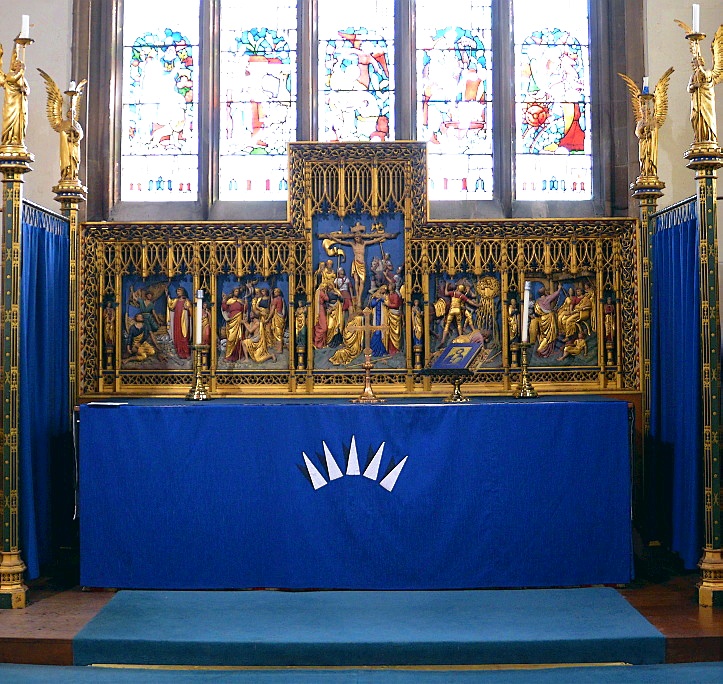
Tring Church Reredos today.
Designed by W. F. Howard in 1928, the
Reredos depicts New Testament scenes.
|
Children’s services were unknown, and families came together to
Church, the younger members patiently attending the long morning
service, consisting of morning prayer, Litany, and the
Ante-Communion service. All the same, there was a large
congregation, and the children never dreamed of not wanting to go to
Church; habits of reverence and self-discipline were being formed,
and God’s House was in later years indeed our spiritual home.
KATHARINE ELLIMAN.
――――♦――――
Tring Parish Magazine, January 1944.
A NOTE ON THE MUSIC IN TRING CHURCH
From “The Fiddle’s Father” to the Electric Organ,
by Arthur MacDonald.
|
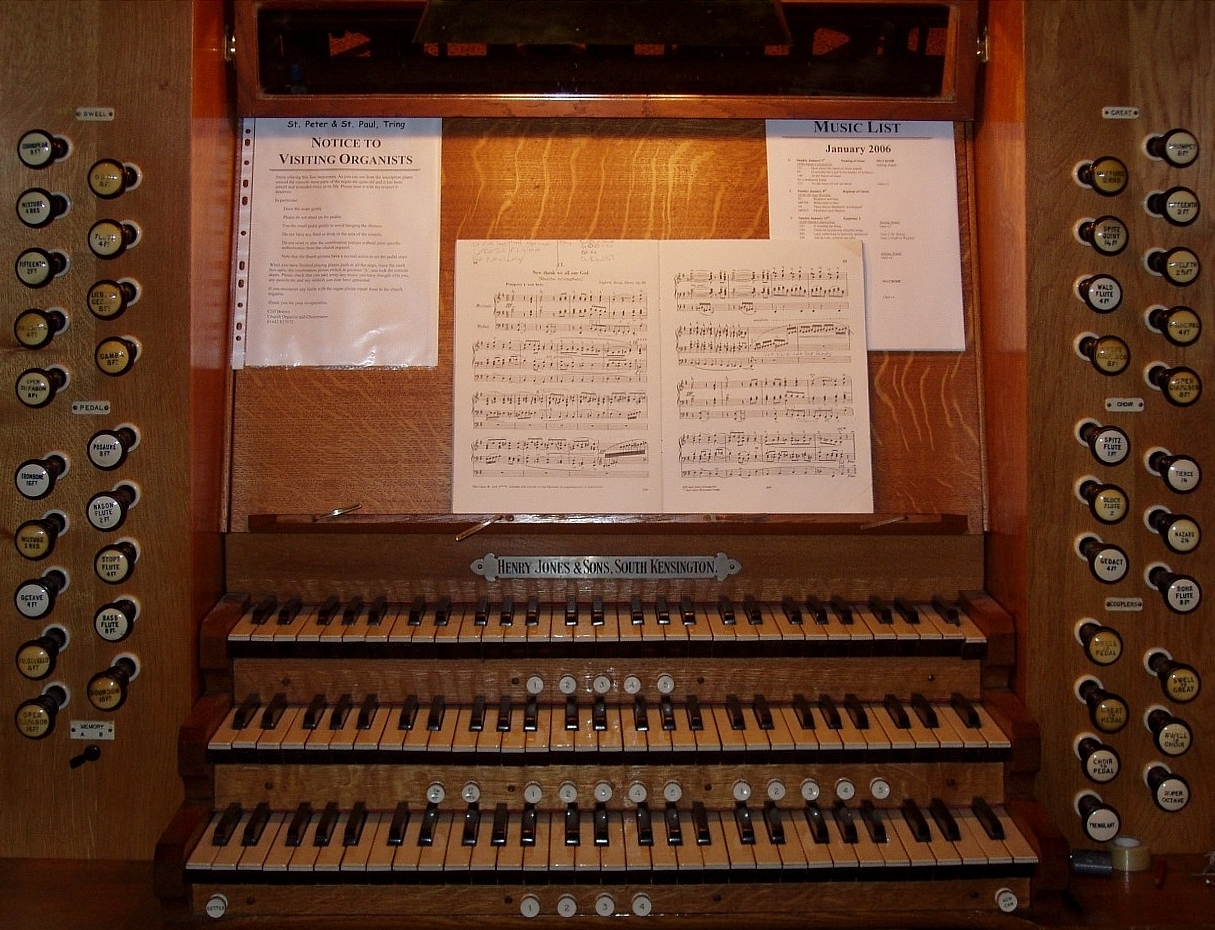
|
The organ console, Tring
Parish Church.
The instrument we have today
was originally built in 1890 by Henry Jones & Sons of
South Kensington. It has twice been rebuilt and
extended, first by N. P. Mander & Co. and secondly by
Saxon Aldred of Redbourn.
Photos and
information courtesy of Cliff Brown,
Organist and Choirmaster,
St. Peter and St. Paul, Tring. |
At the beginning of the nineteenth century the music in Tring Church
was supplied by a small orchestra housed with the choir in a gallery
fixed to the East wall of the tower, the instruments being a Double
Bass or “Fiddle’s Father,” one or two violins, and some quaint wind
instruments. The School Master led the band, and the
congregation in their horse-box pews were accustomed to turn West
towards the choir when singing.
In course of time a barrel organ replaced the orchestra in the
Western gallery, causing a moral as well as a mechanical revolution.
The choir struck, and refused to sing, stung to this drastic step
not only by the presence of the hurdy-gurdy but by derogatory
remarks as to their performance being “like a parcel of bulls.”
The Vicar was equal to the occasion, and refused to preach — “No
singing, no preaching.“ This outbreak of hostilities was
eventually got over, and peace again reigned.
After the commencement of the restoration of 1861-1881, the Western
Gallery was removed, and a “little organ was hung on to the North
wall, surrounded by a red curtain, above which the Vicar’s gardener
rose to blow the organ by pulling a rope, as for a knell. The
choir boys saw to it that the Christmas decorations included a trail
of the prickliest Holly round the blower’s rope.
It was well towards the end of the great restoration before a new
(or rather second-hand) organ by Gray and Davidson was subscribed
for by the ladies of Tring, and placed in a new organ-chamber, and
the choir, instead of the reigning family, occupied the chancel.
Half way through its life of 60 years, this organ was rebuilt under
the careful supervision of a friend of Tring Church, a blind amateur
organist. Now, in 1943, it remains to fill the organ chamber
in an honourable retirement, and a modern miracle of sound, of
American invention, a Hammond Electric Organ, has been installed and
was dedicated on the 22nd of September, 1943, being provided by a
fund readily subscribed by the parishioners and by friends and
relatives of the late Miss Helen E. Brown, a life-long worshipper in
Tring Church, as a memorial to her.
Some short description of this wonderful instrument may serve to
explain to the majority of us who daily use but do not understand
the telephone and radio, how the sound is produced by the electric
current from the mains, without any of the old concomitants of
pipes, bellows or blower.
A plain but handsome console like a large harmonium, with two
manuals and radiating pedals, is placed inconspicuously below and at
right angles to the chancel steps near the lectern, fed by two small
cables, at a cost of one penny an hour. Invisible wires carry
the impulses from the keys to four concealed sound cabinets from
which the music actually comes, high up in the aisles and chancel.
In place of the terrifying vertical columns of stops to be pulled
out by acrobatic arm action, is a bunch of little white-lettered
black stops occupying a space of about nine inches by six under the
organist’s left hand, pressed down with one finger and reproducing
the tones of every instrument of the orchestra, while a horizontal
row of small white knobs gives every possible combination at will.
The range of tone is far larger than that of a pipe organ, and
varies from a whisper to a volume which makes the roof rattle.
“No words can express its sweetness and versatility of tone,” as was
said by a friend who had heard the auxiliary organ in Canterbury
Cathedral.
Many organs of this type have been fixed in this country.
Those of the Guards’ Chapel in Knightsbridge and Princes Risborough
Church in this neighbourhood are in buildings comparable in size to
Tring Church.
Now, how are the multitudes of varied sounds made?
The ordinary amateur feels like the dog hearing his master‘s voice
through a gramophone; “Where is he? What’s at the back of this?”
When the undergraduate in for a viva voce was asked, “What is
Electricity?” and said he knew quite well when he came into the
room, but was nervous and had quite forgotten, the Examiner
remarked, “This is nothing less than a catastrophe! There are
only two Beings who know what Electricity is, — the Almighty and
yourself, and you’ve forgotten!”
It is doubtful whether the details of the organ supplied by the
builders will make us any the wiser. This is what they say
about it:
“The sound-waves produced by the Hammond organ
differ in no way from those created by any other means. The
vibrations which cause sound to be heard are the same, whether made
by a reed a pipe, a voice, or by an electric current. Research
has enabled the scientist to produce the vibrations which are the
basic foundation of all sound, to mix these vibrations at their
source into the intricate sound-wave forms of which every musical
tone is constituted and to amplify them to the required degree of
audibility.”
The actual mechanism in the sound cabinet by which the electric
current is converted into sound by means of magnets, coils, and 91
rotating metal discs the shape of a three-penny bit and the size of
half-a-crown, is such that no layman can understand or attempt to
describe, so we must be content to enjoy the result of the miracle
without knowing how it is done.
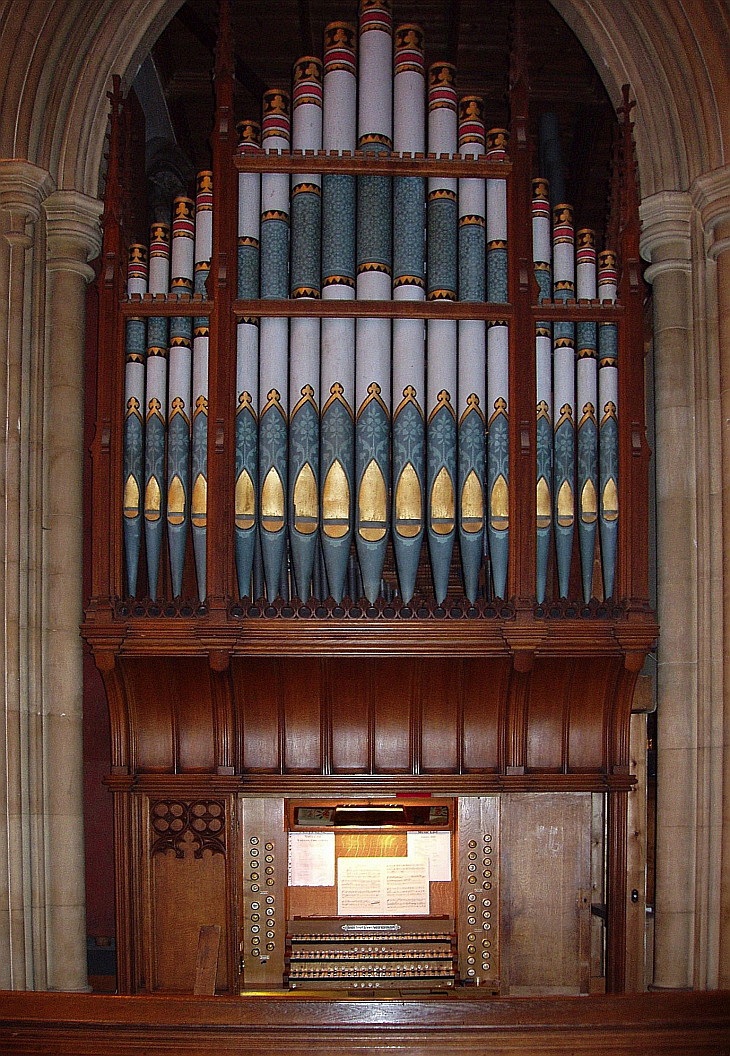
――――♦――――
Tring Parish Magazine, February 1946.
TALK OF THE TOWN — IN 1701.
Now that Pendley Manor is so much in the news, it is interesting to
discover that the Pendley estate was at one the the cause of some
considerable friction between the neighbouring parishes of Tring and
Aldbury. Reference to the few existing records of the parish
reveals that about 245 years ago a dispute between the
above-mentioned parishes over their respective boundaries resulted
in a lawsuit, and this is borne out by the following extract from
the Vestry Order Book of that time :—
Novemb. 23rd, 1701.
Whereas there is a suite dependinge both in law and equity between
ye parishioners of Albury and the parishioners of Tringe in the name
of the Churchwardens and Overseers of the Poore of the sd. parishes
for and concerninge threescore acres of land beinge the land of
Symon Harecourt, Esq., at Pendley whether the same lyes within the
parish of Albury or the parish of Tringe. It is now ordered
and agreed to at a public Vestry for the sd. parish of Tring.
That the said parishioners will stande by and assist the sd.
Churchwardens and Overseers in the defence of the sd. suite And any
costs and charges shalbe expended in and about the same shalbe
equally and apporconably borne and paid by the said parish.
The order is signed by Dan Clarke, John Rolfe, Thomas Grace, Robert
Harding, and 15 others.
The boundary at the present time divides Pendley into two parts.
The Manor is in Tring, but the farm in Aldbury. I don’t know
myself whether or not the area now in the latter parish was the
disputed land, but it appears quite probable, Aldbury having won the
day.
Pendley was one of the five original manors of Tring, and no doubt
this is but one of many thrilling chapters which it has experienced.
The townsfolk probably found the Pendley steeplechase, mentioned by
Mr. Arthur Macdonald in “That Tring Air,” far more exciting.
Fortunately, Tring can still count the fine present-day institution,
which Pendley has become, one of its most valuable assets.
“TREUNG.”
――――♦――――
From the Tring Parish Magazine, March 1946
SOCIALLE SECURITIE IN MERRIE ENGLANDE.
Tring decided as long ago as 1718 that better provision should be
made for the less fortunate members of the community, and resolving
not to wait until 1946 for the Government to act, set about the
problem with typical Tring initiative. I leave the following
extracts from the Vestry Order Book to tell the tale :—
“Whereas the Charge of the poor of the parish of Tring in the said
County is become soe great a Burden . . . the Poores Rate being very
much encreased to what it was in former times, the parishioners have
had severall meetings and came to severall resolutions which are now
confirmed by a Publick Vestry . . . . this 2nd day of November,
1718.”
There then follows several resolutions, of which I quote a few :—
“that a House of Maintenance be provided for the poor . . . . in
order to prevent the giving or paying of weekely allowances and
Collections or House Rents to or for the said poor to any person or
persons whatsoever.” — “resolved and agreed to take the Parsonage
House . . . . and also the Inclosed Courts and Gardens belonging to
the said House at Eight pounds per annum” — “resolved and thought
convenient that 3 Cowes be bought and kept for the use of the said
House” — “that All Parishioners whatsoever that Aske reliefe . .. .
. shall he lodged, fed, clothed and maintained” — “that A man be
sent to at Once who is thought Experienced in A worke of this nature
. . . .. to treat with the parishioners on this undertaking” —
“whereas it is thought necessary that A Sume not exceeding £200 be
raised . . . . and William Gore, Esqre., haveing been pleased to
offer to lend the money . . . it is agreed to take up such a sume
and pay Interest” — “resolved that the Master . . . . shall have
power and liberty to hire out any of the poor people . . . . to any
. . . . that shall have occasion for their service He receiving what
they shall severally earn and be accountable to the parishioners for
it.”
The townsmen wasted no time in their project, and a week later met
again, when they decided to appoint “Mr. Matthew Marriott to
undertake the Care of the poor” and “in consideration of the great
pains and trouble the said Matthew Marriott shall be att ” agreed to
pay him £25 “for the first yeare,” £20 the second, and £18 the third
year.
They also ordered, “for the better regulation of the House,” that
nobody should be admitted “without the Licence under the hands of
five of the chiefest Freeholders and Parishioners and the hands of
the Overseers of the Poor.” Anybody entering the House, or
taking in any Children, to be lodged, without this Licence were to
“be sent to Bridewell and farther punished” (Bridewell — gaol).
An inmate who refused “to worke orderly and soe many hours as the
Master commanded” was to “be sent to the House of Correction.”
Any person who would not work “pretending sicknesse” which might be
“discovered by their Stomachs or otherways ” merited severe
punishment. Anyone found “O Begging or Chaseing” was to be
sent to the House of Correction. Everybody in the House “of
Healthfull Bodyes and able” were to “fix by five or before and goe
to Bedd at nine.” Finally, it was stipulated that “at six of
the Clocke in the afternoon“ each Saturday, all townsmen who were
willing should meet the Overseers of the Poor to adjust the week’s
accounts, and that the Master should, at the end of his weekly
accounts, “sett down in writing all the disorders committed . . .
that the offenders may be examined by the Freeholders and
Inhabitants and punished as deserve.”
Thus did Tring tackle its social problems over 200 years ago.
――――♦――――
Tring Parish Magazine,
August 1940
REGISTER EXTRACTS.
June 15th, 1735.
“At a public Vestry of the Parishioners of the parish of Tring this
day assembled upon public notice it aprazing that Richd. Gluttor of
Barkhampstead Surgeon hath commenced an action against Jno. Baldwin
late Oversear of the said parish of Tring in order to charge him as
officer of the said parish with a bill for attending and curing
Daniel Jugg a certificate man of our parish of Tring, of a soar
legg, and we the parishioners aforesaid being willing that the
aforesaid Jno. Baldwin should not bear the whole expense of
defending the action and being satisfied the same is brought without
good cause we do agree to joyne in an equal expense of defending the
action.
M. Randolph (Curate), John Harding, Sam Holmes, Edward Browne, John
Kingham, John Pegsworth, Matthew Evans, Daniell Barton, John Lake,
John Howton, Tho Josephs, Tho Kingham.”
This was followed by a decision a year later to permit the
“Overseers John Tompkins and John Lake to borrow of Mr. John Tovey
the sum of Forty-five pounds for the use of the parish in order to
defray the Law Charges in a cause lately determined between Flutter
and Baldwin.”
Tring, March 27, 1744.
“At a Vestry assembled I, M. Randolph, do nominate and appoint Thos.
Humphrey Wheeler to be Church Warden for the ensuing year.
M.
Randolph,
Curate.
It is likewise agreed at the said Vestry that John Rolfe be the
other Church Warden for the same year.
M. Randolph, Thomas Chappell, John Yates (or Gates), Henry Newman,
Thomas Monk, Hugh Goodspeed.”
There is also a legal document included in the book by which the
Bishop of Lincoln instructed the Minister and Church Wardens to
place parishioners in the pews with which the Hon. William Gore had
seated the Parish Church in 1715. So far as possible they were
to place them in the new pews corresponding to their old sittings,
and these parishioners thus placed were not to be molested under
pain of the law by any other parishioners of Tring. A list of
pew holders followed.
――――♦――――
FROM THE MONTHLY CHRONOLOGER:
THE EXECUTION OF THOMAS COLLEY
on the 24th August 1751,
FOR THE MURDER OF RUTH OSBORN, BELIEVED TO BE A
WITCH.
At the assizes at Hertford, Thomas Colley received sentence of
death, for the murder of Ruth Osborne at Tring. It appeared on the
trial, which lasted several hours, that some of the neighbours
thinking the deceased was a witch, and her husband John Osborne a
wizard, had it cried at Winslow, Leighten-Buzzard and Hamel
Hempstead, on their several market days, that they were to be
publickly ducked on Monday, April 22, at Tring: That the overseer of
the poor of Tring having heard of this, and believing both the man
and his wife to be very honest people, in order to prevent the same,
sent them into the workhouse. That the master of the workhouse,
hearing on Sunday, April 21, that a number of people would assemble
next day in order to duck them, he in the middle of the night
removed them into the vestry-room adjoining to the church, believing
the sanctity of the place would have some awe upon the mob: That
about 11 on Monday morning, a great mob, thought to be above 5000,
came to the workhouse, and demanded these poor people, and on his
telling them they were not there, they rushed in and searched the
house, and all the closets, boxes and trunks; and that they were so
infatuated, that they searched the very salt-box for them: That
there being a little hole in the ceiling, where the plaister was
broke, Colley hallowed out, Let’s search the ceiling; which they did
accordingly, and not finding them, declared they would pull the
house down if they were not delivered to them; and accordingly they
pulled down a large wall belonging to the house, and also pulled out
all the windows and window frames, and threatened to burn down not
only the workhouse, but the whole town of Tring, if they were not
delivered up: That the master, fearing the consequences, did at last
inform them where the two unhappy people were: upon this they went
to the vestry-room, broke it open, and took them away in triumph.
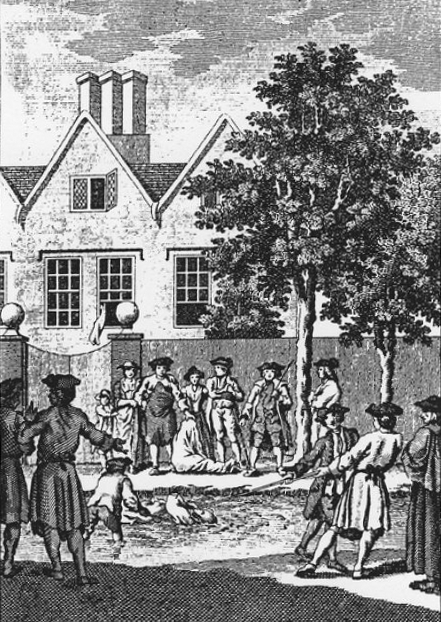
The ducking of the Osbornes.
It further appeared, by the deposition of several witnesses, that
the man and woman were carried to a pond called, called
Marston-Meer, and separately tied up in two several cloths or
sheets: That a rope was tied under the arms of the deceased, and two
men dragged her into the pond: and then standing one on one side the
pond and the other on the other, they dragged her quite cross the
pond several times: That after this they brought her to the pond
side and set her down, and then served the husband in the same
manner, and so on alternately till the woman being brought to the
shore the 3d time, and laid on the ground, soon expired: That each
of the three times Colley went into the pond, which in mud and water
was not quite 2 foot and ½ deep, and with a stick in his hand,
turned the deceased over and over, and pushed her up and down
several times: That when he came out of the pond, he went round
among the people, and collected money of them as a reward for the
great pains he had taken in shewing them sport by ducking the old
witch as he called the deceased: That when he was in the pond, one
called out to him and desired him to come out, and let the woman
alone, for if he did not, he would certainly kill her: but he
refused to come out, and said she was a witch, and he would duck her
again: and that he did, after that, turn her over and push her about
in the pond several times: that the 3d time of ducking her, the last
before she expired, he took hold of the cloth she was wrapt in, and
pulled her up and down the pond, till the same came off and her body
appeared naked: and that then he pushed her on the breast with his
stick, which she endeavoured with her left hand to catch hold of,
but he pulled it away. -- Thus, according to the opinion of the
surgeon at the trial, this poor woman expired by suffocation with
water and mud. She was in the 70th year of her age: but her husband,
aged 56, being a lusty strong man, survived the inhuman treatment of
these barbarous miscreants. Several other persons were indicted with
Colley, two not yet taken, and the rest to the jurors unknown: but
it is hoped they will soon be discovered and receive the just reward
of their crime.
Saturday 24th August 1751
This day Thomas Colley, for the cruel murder of Ruth Osborne, on
supposition of her being a witch, was executed at Gubblecut-cross
near Marlston-green in the parish of Tring in Hertfordshire. About
10 on Friday morning he received the sacrament at Hertford,
administered to him by the Rev. Mr. Edward Bouchier, when he signed
a solemn declaration of his belief relating to witchcraft; which he
desired might be carried to the place of execution, and was there publickly read, at his earnest request, just before he was turned
off, by the Rev. Mr. Randal, minister of Tring, who attended him in
his last moments. He was escorted by 108 men belonging to the
regiment of horse blue, with their officers, and two trumpets; and
the procession was slow, solemn, and moving. Friday night he was
lodged in St Alban’s goal; and at five the next morning was put into
a one-horse chaise with the executioner, and came to the place of
execution, about eleven and after half an hour spent in prayer he
was executed, and immediately after hung up in chains on the same
gibbet he was hanged on. The infatuation of most of the people in
that part of the county was such, that they would not be seen near
the place of execution, insisting that it was a hard case to hang a
man for destroying an old woman that had done so much damage by her
witchcraft. It was said, he was to have been executed a week sooner,
but when the proper officers came to convey him from the goal, a
prodigious mob assembled and would not suffer him to be taken out of
prison.
His Declaration, above mentioned, was as follows.
“Good people:
I BESEECH you all to take warning by an unhappy man’s suffering;
that you be not deluded into so absurd and wicked a conceit, as to
believe that there are any such beings upon earth as witches.
It was that foolish and vain imagination, heightened and inflamed by
the strength of liquor, which prompted me to be instrumental (with
others as mad brained as myself) in the horrid and barbarous murder
of Ruth Osborne, the supposed witch, for which I am now deservedly
to suffer death.
I am fully convinced of my former error, and with the sincerity of a
dying man, declare that I do not believe there is such a thing in
being as a witch; and pray God that none of you, thro’ a contrary
persuasion, may hereafter be induced to think, that you have a right
in any shape to persecute, much less endanger the life of a fellow
creature.
I beg of you all to pray to God to forgive me, and to wash clean my
polluted soul in the blood of Jesus Christ, my Saviour and Redeemer.
So exhorteth you all, the dying Thomas Colley.”
Ed. − Colley was executed at Gubblecote Cross. His body was then
hung from the gibbet in chains, where it is reputed to have remained
for years.
――――♦――――
EXTRACTED FROM THE BRITISH NEWSPAPER ARCHIVE:
THE EXECUTION OF EDWARD CORBET
on the 23rd July 1773,
FOR THE MURDER OF RICHARD HOLT.
A SORDID STORY.
Bierton near Aylesbury formed the stage for the last gibbeting in
Buckinghamshire. The Rev. J. Wharton, who was vicar in 1860,
wrote an account of it, citing as his text the entry in the
Parish Register for 10th June, 1773. Three days previously
“Richard Holt, widower” had died, “he being most
barbarously murdered in his bed-chamber at night.”
It seems that Edward Corbet, a resident of Tring who combined the
honourable but diverse vocations of rat-catcher and chimney-sweep,
had been working in Bierton for some days before being finally
employed by Richard Holt, whose daughter Mary had just died; the
bereaved father was seen by Corbet through a window to be praying
when he reached the house. Corbet waited until Holt went to
bed and using a ladder entered the house down the chimney where he
murdered Holt, his motive being theft ― we are not told what means
he employed, but as there was a lot of gore about Corbet presumably
used a blade.
Collecting what he could see in the way of valuables, Corbet then
left by the more orthodox means of the door, but as he did so his
dog ran into the house; Corbet, not noticing this, shut the dog
inside. The following morning a farm lad found that his master
was not up, and when he opened the door he recognised the dog within
was Corbet’s.
The constable followed the dog to Tring and arrested Corbet who had
some of the stolen property in his possession. Corbet was
later tried for murder and found guilty. The Aylesbury
Parish Register completes the story: July 23rd, 1773,
Edward Corbet was hung in chains at Bierton for the murder of Farmer
Holt.
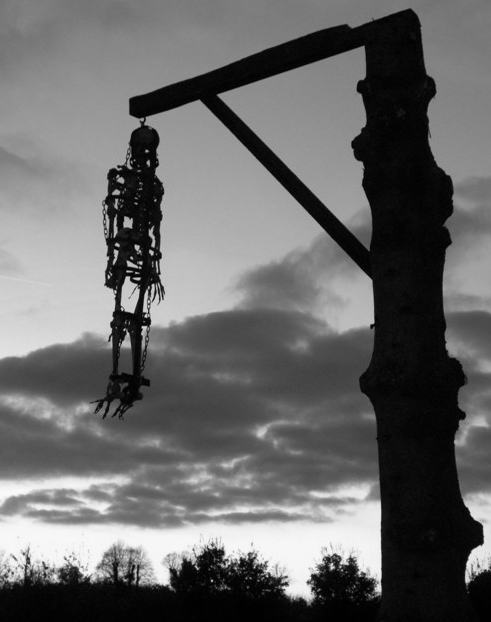
Hanged in irons.
The Rev. Wharton goes on to provide a description of what being
hanged in chains meant. He says that the son of James Durley,
the parish clerk (then 16 years old), said that
“the
post was about 18 feet high, and served both for gallows and gibbet.
I saw the cart drawn up under the gallows, and after he was dead I
saw his body encased in irons and hung up.”
Benjamin Green, who died in 1857 in Amersham Union, said that his
father, who was a blacksmith, made the ironwork for the gibbet.
The place where the gibbet was positioned was in the corner of the
field on the right-hand side of the road leading from Bierton to
Hulcott, and about a quarter of a mile from the house in which the
murder was committed. Since the Inclosure in 1780 the field
has been called Corbet’s Piece, and the lane facing its western
boundary, Gib Lane (a name it retains today).
Another of the Rev. Wharton’s witnesses was Mary Lane, a servant at
a nearby farm-house, who could see Corbet’s body when she sat up in
bed, whilst people living nearby could not open their windows until
after the following harvest, presumably because of the smell of the
decomposing body. The authorities were in no hurry to remove
the ghastly spectacle but allowed the body to remain until it
dropped to pieces. Twenty-two years after the execution the
gibbet was still standing with the grinning skull of the murderer
attached to the irons.
As might be expected, the locality soon gained an unenviable
celebrity on this account, and no end of curious and horrible
stories began to circulate about the ghostly sights and noises that
haunted the place and which so terrified the inhabitants of the
district that they would not pass the spot even in daylight.
The footpath, which led from the Chalk House Arms to the rear of the
houses in Bierton and thence into the main road, was formed at that
time in order to avoid passing the gibbet and its unsightly burden.
However, by the beginning of the 19th century the iron had become
worn through by the constant friction of the swivel in the wind,
that the chains fell and were thrown into a nearby ditch where,
according to local legend, they remain buried.
The last use of the gibbet was by a chair-maker in Bierton, who
bought the post to “work up into fancy articles” for morbid
people.
――――♦――――
The Trial
and Execution of
JOHN TAWELL
In March 1845, John Tawell (1784-1845) was hanged for murder in the
Town Square at Aylesbury.
Transported to Australia
in 1820 for the crime of forgery, Tawell obtained a ticket of leave,
and started as a chemist in Sydney. There he flourished and
after fifteen years left it a rich man. Returning to England,
he married a Quaker lady as his second wife. He later
confessed to the murder of his mistress, Sarah Hart, by prussic acid
(Hydrogen cyanide), his motive being a dread of their relationship
becoming known to his wife.
His case is interesting because he became the first person to be
arrested as the result of telecommunications technology, the
telegraph. The notoriety of the case brought the telegraph
into repute. Its advantages as a rapid means of conveying
intelligence and detecting criminals had been signally demonstrated,
and it was soon adopted on a more extensive scale. It was also
the first known homicide case where the criminal attempted to flee
the scene of the crime by a railway train.
Early life and criminal career
Tawell started out as a shop worker in London and for some years
worked in a number of shops owned by the Quakers, including a
chemist’s. At 22 he married his first wife, Mary, and they had
two children. In 1814 Tawell forged a £10 note from Smith’s
Bank, a capital offence, for which he was sentenced to death.
However, Smith’s was Quaker owned and, being opposed to the death
penalty they had his sentence commuted to transportation.
Tawell prospered in Australia where he opened the colony’s first
pharmacy and conducted numerous property and business ventures.
His family joined him there in 1823, and Tawell became influential,
having set up the first Quaker community in Australia and engaged in
various philanthropic activities.
In 1831 the Tawells returned to London where both children died of
tuberculosis. In 1838 Mary also fell ill and she too died.
Tawell had employed a nurse, Sarah Lawrence to look after Mary, and
despite having remarried he began an affair with her, a relationship
that bore two children. Tawell installed his ‘second family’
in a cottage in Salt Hill, Slough, where he paid £1 per week to
maintain them.
Tawell kept Sarah well away from his second wife, but when she made
their ‘arrangement’ official by taking out a court order for
maintenance for her and the children, she presented Tawell with a
problem that he decided to solve by getting rid of her. On 1
January 1845 he bought two bottles of Steele’s acid, a treatment for
varicose veins containing hydrogen cyanide, and travelled to Salt
Hill where he poisoned Sarah while sharing a beer in her cottage.
Arrest by telegraph
Between six and seven o’clock one morning in 1845, Sarah was found
dead in her home at Salt Hill. A man dressed in Quaker garb
had been observed by a neighbour to leave her house some time
before. The police knew that she was visited from time to time
by a Mr John Tawell, from Berkhamsted, where he was much respected,
and on inquiring and arriving at Slough, they found that a person
answering his description had booked by a slow train for London, and
entered a first-class carriage.

The Electric Policeman.
The police telegraphed at once to Paddington Station, giving the
particulars, and desiring his capture. ‘He is in the garb of a
Quaker,’ ran the message, ‘with a brown coat on, which
reaches nearly to his feet.’ There was no ‘Q’ in the
alphabet of the early two-needle telegraph instrument, and the clerk
at Slough therefore spelt the word ‘Quaker’ with a ’kwa‘.
’Kwaker' was understood, but only after several requests to repeat.
Tawell was followed from the platform at Paddington by a sergeant of
the railway police, William Williams, who had put on a long civilian
overcoat to cover his uniform. Williams followed him into a
New Road omnibus where Tawell mistook him for the conductor and gave
him 6d for the fare. Tawell went to a coffee tavern and then
home, all the while with Williams following. Williams came back the
following morning with Inspector Wiggins of the Metropolitan Police
and they arrested Tawell in the same coffee house.
Trial
Tawell was tried at Aylesbury for the murder of the woman, and
revelations were made as to his character. His defence was handled
by Sir Fitzroy Kelly, who tried to make a plausible case that the
prussic acid that killed Sarah Hart was from eating the pips (pits)
of apples (a large barrel of apples was in the house). The
rather silly nature of this argument led the distinguished barrister
to be known as “Apple-pip” Kelly for the rest of his life.
Execution
Tawell, having been found guilty of murder was hanged in public on
28 March 1845 in front of the County Hall in the Market Square at
Aylesbury. This report is from the Bucks Gazette, 29th
March 1845 . . . .
“At an early hour in the morning persons
were flocking in from the country in all directions, some as
pedestrians and others in various kinds of vehicles, to witness the
execution of this unfortunate man, and the oldest inhabitants of
Aylesbury never saw so many persons assembled on such as occasions.
The large square in front of the County Hall, the front windows of
which house, the balconies, the tops of projecting shop windows, and
every eminence that could be reached, were thronged with spectators,
and there must have been at least 6,000 persons present.
About ten minutes before eight o’clock, the unhappy culprit was
brought up into the balcony in front of the Goal, where the drop was
erected, at which place he was accompanied by the turnkey of the
Goal and the executioner. The centre of the front of the
balcony was covered with black drapery. The culprit was
dressed in the same suit of black which he wore during his trial at
the Assizes, and had a white handkerchief hanging out of the breast
of his coat. He appeared to ascend the platform with a firm
step, and looked round at the populace and at the drop.
The cap was placed over his eyes, and the rope placed round his
neck, when he requested to be allowed to spend a short time in
prayer. He knelt down and remained a few minutes at his
devotions, and after he arose, the executioner fastened the rope to
the beam, and the fatal bolt being drawn he was launched into
eternity! [It seems that the executioner failed to
calculate the drop properly for . . .] the
body convulsed for six minutes, and the hands were raised several
times, as in the attitude of prayer.
The last act of the prisoner was to leave a small amount of money,
with a written request that a shilling or two should be given to
one, and a shilling of two to another of those who had been his
fellow prisoners.”
――――♦――――
Tring Parish Magazine April 1925
BYGONE DAYS IN TRING: 1793
Mr. Vaisey has shown us an old copy of the Star newspaper
dated March 20th, 1793 in which is given a long account of a Meeting
of the principal inhabitants of Tring assembled together to uphold
the government and constitution in Church and State and to pass
certain resolutions.
The document is too long to quote in full but begins as follows:—
“We, the inhabitants of the
Parish of Tring, Herts., assembled in Pursuance of an Advertisement
signed by the Church-wardens, think it our duty to express our
sentiments and resolutions on this and arduous conjuncture of public
affairs.
Then follow Sixteen Statements.
1. We declare that our attachment to the present Constitution of our
Country in Church and State is firm and unchangeable
2. We do not hesitate to assert that no government, either of
antiquity or modern times, has ever consulted so judiciously the
collective and individual happiness of the human race.
8. We proclaim in this public manner our unshaken loyality to his
present Majesty King George III, the father of his people; under
whose mild and equitable reign this nation enjoys an unexampled
stroke of public and private prosperity.
16. We therefore associate for the purpose of resisting the designs
of nefarious men, who have all to gain, and, nothing to lose, by a
change: and are come to the following resolution.”
Here followed certain resolutions.
“Resolved, that we will defend to the utmost of our power, the
British constitution, composed of King, Lords and Commons, etc.
Resolved, that Drummond Smith, Esq., Thomas Harding, Esq., Rev. Dr.
Dupré, Rev. Marmaduke Bannister, Rev. Michael Dupré, William
Cunningham, M.D., Mr. John Rolfe, Mr. Samuel Snelson, Mr.
Bartholomew Rolls, Mr. Richard Mead, Mr. Edward Foster, and Mr.
Samuel Herbert, be a Committee.
Resolved, that these resolutions be inserted once in the Star,
and once in the County Herald.”
John Dupré, Chairman
――――♦――――
Tring Parish Magazine, August 1944
THE ARCHDEACONS’ COURTS.
Our Venerable and revered Archdeacon, in whose County-wide work we
are all keenly interested, is relieved of the invidious duties of
his predecessors of the post-Reformation period of holding Courts of
inquisition into the unorthodox misdeeds of every parishioner in his
Deaneries, and of punishing by fine, imprisonment, or public
confession the smallest deviations from their ecclesiastical or
moral obligations. I believe some of these intolerant old laws
are still in force. Imagine our Archdeacon fining or
imprisoning all the Non-conformists of Tring, and all those
buttresses of the Church who neglect regular attendance at Divine
Worship, and condemning all persons of either sex who make an
occasional lapse from strict morality, to perambulate the streets in
a white sheet and make public confession of their fault!
Yet this is the sort of thing which his predecessors of the 16th and
17th centuries had to do, as recorded in the “Acta” or records of
the Archdeacons’ Courts. These were usually written in such
impossible script and Latin as to be unintelligible to all but the
specially expert. Dr. John Brown, however, in his life of John
Bunyan, has managed to decipher for us some items from the “Acta” of
the Archeacons’ Courts of our neighbouring County of Bedford, which
may give us some idea of the unruly and hilarious doings of our
ancestors, and of the beneficial effects of the removal of
Gestapo-like inquisitions formerly conducted by the Church into the
behaviour of all its members and officials.
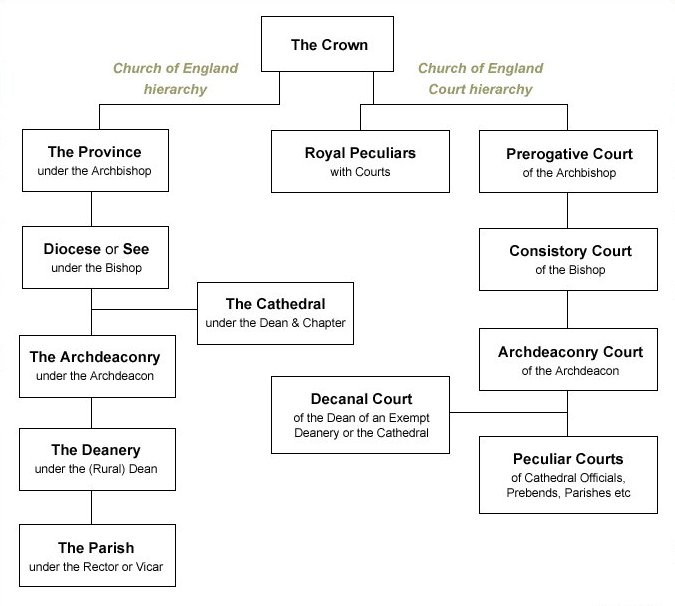
The Church of England Courts.
We find one man bringing judgment upon himself for “marrying his
wife in their Parish Church in her mask”; another “for being married
to his wife under a bush”; and yet a third “for that the day he was
marryed he did blowe out the lightes upon the altar and wolde suffer
no lights to bourne.”
A shoemaker was punished “for that he kepeth his bed upon the
Sundaies and other holy days at time of mattens and mass, as it were
a hownde that shuld kepe his kenell.”
One man came into trouble for “folding some sheep in the church
during a snow-storm”; and another for “living in the church porch
and suffering his wife to travail in childbirth there, and to
continue there her whole moneth.” Women fell under the
judgment of the Court for coming to be churched “not as other honest
women, but comynge in her hatt, and a quarter about her neck”; or
“for not coming in a vaile”; and one brisk housewife, striking out a
bright idea on a rainy day, found to her cost that she had offended
by “hanginge her lynnen in the church to dry.”
The clergy and churchwardens were often in trouble in the Courts.
One rector was cited for refusing to hear confessions “because it
greeves him to heare the confessions made”; another went quite wrong
by “taking upon himself to the scandal of his calling, to be lord of
misrule at Christmas among certain yongelings”; another by leaving
some ecclesiastical ceremony to be present at the more exciting
spectacle of an execution.
The churchwardens incurred penalty “by suffering unrulie persons to
ring and jingle the bells out of due season,” by permitting a
minstrel to play in church at a wedding, and because the white sheet
used for penance was missing.
Finally, that chartered libertine the Parish Clerk was dealt with
summarily “for that he singeth the psalms in the church with such a
jesticulous tone and altitonant voyce, viz. squeaking like a pigg,
which doth not only interrupt the other voyces, but is altogether
dissonant and disagreeing unto any musicall harmonie.”
Sabbath and Saints’ days observance was strictly enforced. Various
parishioners were punished for looking on football players, for
playing at nine-holes, for killing meat, and dressing a calf, on
Sunday. Others for performing agricultural operations, or for
putting up nets and catching larks, on a Saint’s- day, and others
for not frequenting church; Richard Reade, of Keysoe, “sitting with
his hatt on usually at the reading of the Epistle and Gospell,” and
William Shackspeare, of Odell, for not communicating.
Harman Sheppard, the curate of Woburn, was presented in 1612 for
baiting a bear in the church, and some years later the
church-wardens of Knotting were cited because on three successive
Shrove Tuesdays they and their sons and Mr. Alvey, the Rector of the
parish, “permitted and were present at cock fightings in the
chancell of the said church in or about the sacred place where the
communion table stands, many persons being there assembled and
wagers laid.”
In still later years the Rector of Carlton was presented because
“immediately before service he did lead his horse in at the South
doore into the chancell of Carlton church, where he sett him there
and continued all the time of the said service and sermon.”
A Court had to deal with a clergyman who was charged with ensuring
an audience to the end of his discourses by the simple expedient of
locking the church door upon his congregation, and keeping them
there until it was quite dark. The Rector of Stondon was cited
“for reading divine service without a surplice, though it was proved
by witnesses that at that time his surplice was at the washers.”
These sacrilegious practices seem to us so far off as to have been
impossible, but there are the “Acta” for those who can‘ read them.
The Archdeacons’ Courts were abolished in the middle of the 17th
century, and we may congratulate our Archdeacon, and ourselves, that
he no longer has to deal with the modern equivalents of these
naughty doings.
A.M.
――――♦――――
Tring Parish Magazine, June 1942.
THE LOSS OF CHURCH RAILINGS:
THE GORE MONUMENT
The loss of the railings up the centre path, the iron railings
around the 18th century tombs in the Churchyard, the railings round
the St. Martha’s Church, and those round the Church House, are now
all gone. All we are allowed to retain are the War Memorial
gates, the gate and protective railings at the west end of the
Church, the Vestry gate and the old Churchyard gates. Most
people seem to think the Churchyard is improved by the disappearance
of the low railings: but some, I know, feel very much grieved and
hurt. The Parochial Church Council did everything possible in
making their official application for the retention of such railings
as might be considered to be of artistic, historic, or protective
value. The Archdeacon of St. Albans came over and he and I
sent a further joint request to the Government official in London.
Till the very last day we thought we had saved the St. Martha’s
railings, but on that day I had a telephone message from the Office
of Works and Buildings to say that they and everything else must go
with the exceptions above mentioned. This is just one more
reminder that we have consented through our representatives in
Parliament to yield up what is asked of us towards the winning of
the war.
The chief problem is going to be the prevention of the use of the
Churchyard as a playground. The Vicar and and the
Churchwardens would be very grateful if members of the Church would
give a kind of reminder to any children whom they may see running
about within the Church grounds.
This note would not be complete without a word of most grateful
thanks to Mr. Westron for his work and help in watching the
interests of the Church throughout in this matter of the railings.
|
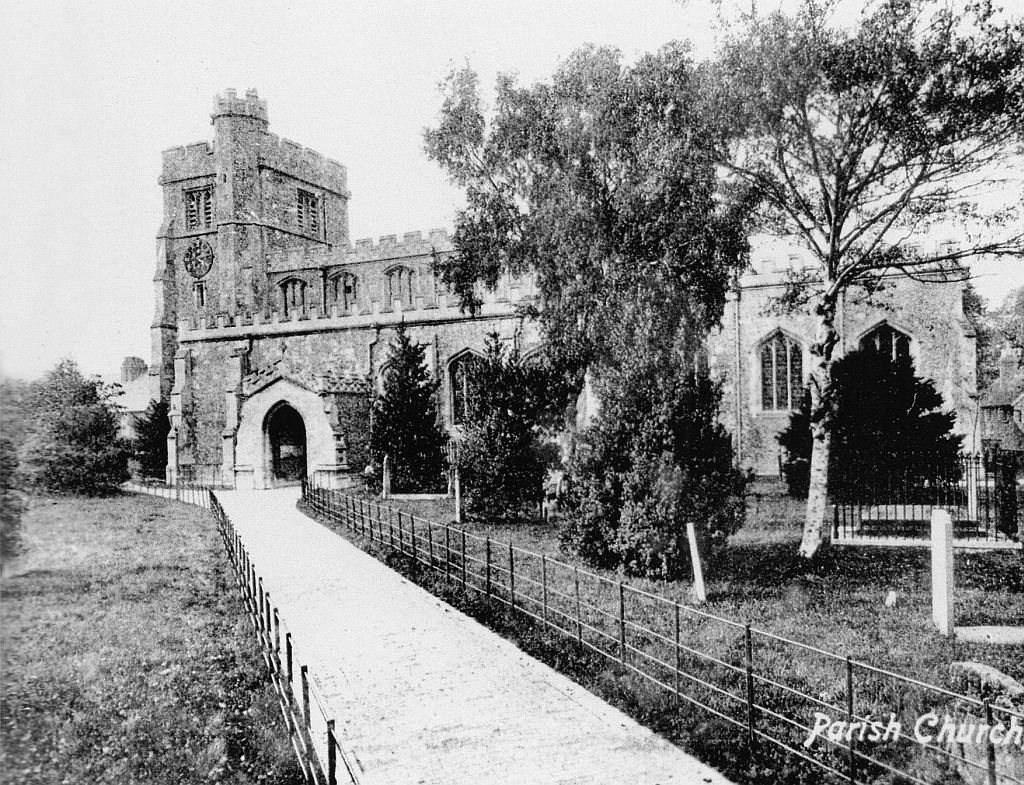
Above: Tring Parish Church before its iron railings
were removed.
Below: Sir William Gore and Dame
Elizabeth Gore Monument (detail),
Tring Parish Church.
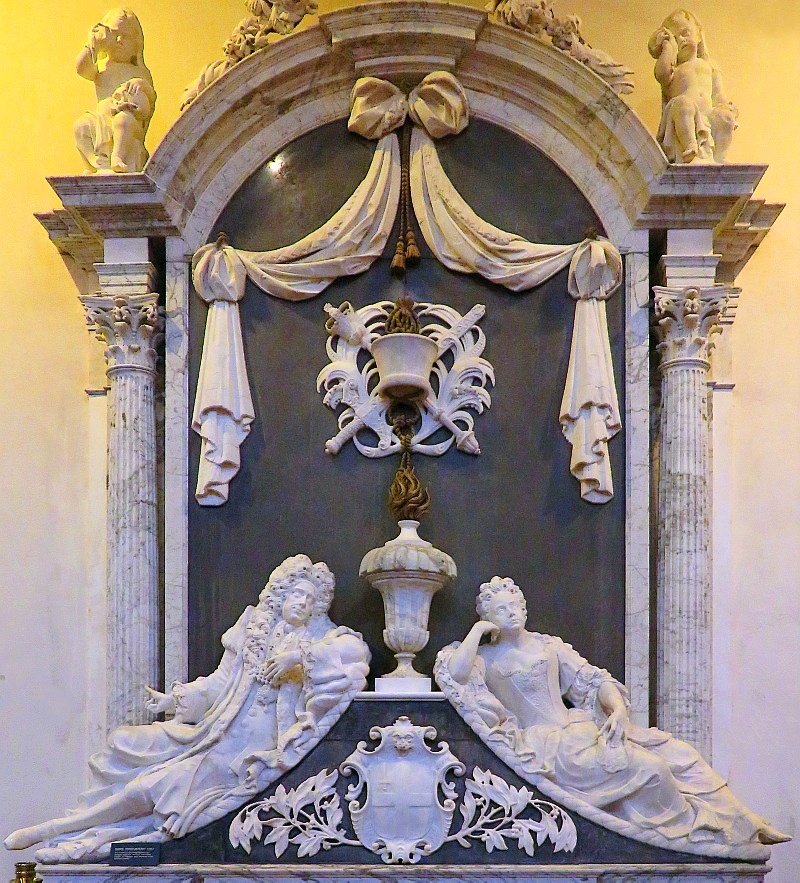
|
The other Church note concerns the Gore monument.
Within the last few weeks a representative of the British Museum has
been down to photograph this monument on the N. wall of the Church.
When asking him if he could confirm the important theory of its
being the work of Grinling Gibbons in the 18th century, he referred
the question to Mrs. Esdaile, the great authority in England on this
kind of work. Space forbids full quotation from her reply, but
she says that in 1936 she thought it was Gibbons’ work. But
now, as a result of close enquiry and research, she says that there
are many points which contradict this, e.g., the cherubs are not
Gibbons’ work; the whole architectural framework is unlike his
architecturing, likewise the outwork, the drapery and the wig. “On
the other hand, all these points occur in the work of John Nost who
came over as assistant to Gibbons’ partner, Arnold Quellin, and
whose monumental work is well known. He uses the internal
frame of that form, is fond of that type of drapery, uses exquisite
marble outwork on the signed monument at Sherborne, and uses this
type of shield, which is not Gibbons. In short, he fills the
bill and explains also the ‘Gibbons’ feeling of the thing combined
with his own particular technique.”
The use of the pea-pod, Gibbons’ signature, on the monument, is to
be explained by the fact that Nost was so closely connected with the
Gibbons’ school. Mrs. Esdaile adds in her letter that this
John Nost was the author of the William III and Mary Memorial, set
up on the Royal Exchange.
C.T.T.W.
――――♦――――
Tring Parish Magazine, January 1944
THE NAME OF TRING
I have noted in “That Tring Air” that this compact little name has
puzzled all the antiquarians, and that no satisfactory derivation
has been arrived at, though there have been many guesses.
There are also very many spellings, adding to the obscurity of its
origin. The earliest recorded appears to be Treing, Treung, in
Domesday Book, 1086. Two very learned local antiquaries have
written me on the subject since the publication of my booklet.
The first says: “What can you or I know about this difficult
question? Let us leave it to the experts. The great
Ekwall has no doubt about it. From one of the 10th century
spellings, Trehangr, he concludes that it is Tree-hanger, i.e.,
a hillside covered with trees.” To this I ventured to reply:
“It is true that Tree or Treow is an old Saxon word, that ‘Hanger’
is still in use in the Chilterns for a wood ‘hanging’ on a hill
side, as the charming name Turlhanger for the triangular wood above
Northfield in our neighbour parish of Aldbury, and that this and the
Tring woods are about the first along the line of the Chilterns from
the North East to clothe the hills, the Ivinghoe and Dunstable Downs
and their continuation into Norfolk being for the most part bare.
But the South Western extension into Dorset is nearly all wooded,
and there are “Hangers” in every parish. Gilbert White
mentions the “Hanger” in his parish of Selborne, Hants. Why
then, was not every parish at the foot of the South Western
Chilterns called Tree-hanger or Tring? Names were given for
something distinctive, not generic.”
The second antiquary wrote; “It is perfectly plain to me. Ing
or Ung (plural) meant ‘the men or inhabitants of.’ For the
first syllable, the only word in any language ever spoken in England
is the Saxon ‘Treow,’ pronounced and meaning ‘Tree,’ so Tring means
‘The men of the Tree,’ referring to the custom of the Hundred-mote
or Court of a division of a County being held at a well-known and
conspicuous, tree.” Tring was the head town of the Hundred of
Tring in Saxon times afterwards merged with Danias Hundred into the
still existing Hundred of Dacorum. The Hundreds, or divisions
of the Counties for legal, military and local government purposes,
into areas perhaps comprising a hundred families, were constituted,
possibly at the same time as the Counties, before King Alfred’s
time.
This derivation seems rather more plausible than Ekwall’s, but is
open to the same objection; — why were not the other Hundreds whose
court was held at a tree (and there were many) not called Treing or
Tring? Also, the place must have had a name before the
Hundreds were formed. There certainly are some names which are
generic and not distinctive. There is a place in Cornwall
called “Rock,” and several rivers called Ouse and Avon, which simply
mean water. So, to my mind, the origin of the name of our town
is still “wrapped in mystery.”
The perpetuation of old field names by giving them to modern houses
is instanced by my own house, “Hazely,” my late lamented neighbour,
Miss Williams’s “Hawkwell,” by “Dunsley” Farm, opposite, and
“Goldfield” Windmill. All these were names of the three or
four hundred acre arable fields before the Inclosure of the Parish
in c1800, cultivated by the communal plough and oxen. Another,
Hounslow has not been appropriated, perhaps because of its
associations with highwaymen and Gunpowder mills.
Arthur MacDonald.
――――♦――――
From the Bucks Herald, 8th December 1939.
DEATH OF MR. A. W. VAISEY
TRING LOSES A VETERAN TOWNSMAN
62 Years a Practising Solicitor
Lifetime’s Work for the Parish Council
FORMER COUNCIL CLERK FOR HALF-A-CENTURY
As announced in last Friday’s issue of the Bucks Herald, the
death of Mr. Arthur William Vaisey, one of Tring’s most prominent
townsmen for over 60 years, and senior member of the firm of Messrs.
Vaisey and Turner, solicitors, Tring, occurred at his residence,
“Holly Field,” The Grove, Tring, on Wednesday of last week, in his
88th year. He had maintained his full professional and public
activities until the week-end before his death, so that despite his
great age and the fact that he was unwell during the early part of
last week, his passing was quite unexpected and is deeply regretted.
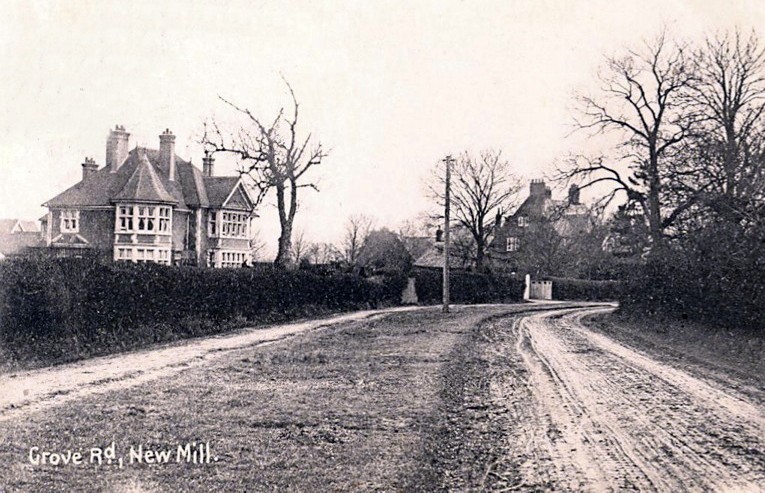
“Netherby ” in Grove Road.
Demolished in the 1970s and the land redeveloped as Hollyfield
Close.
The large house just visible to the right was called “Holly
Field”. It too has gone.
Mrs Vaisey predeceased her husband on September 4th, 1925, at the
age of 71. Mr. Vaisey is now survived by an only son (Mr. H.
B. Vaisey, K.C. and Doctor of Civil Law, Vicar General of the
province of York and Chancellor of the Dioceses of York, Carlisle,
Derby and Wakefield) and seven daughters, together with
grandchildren and a great-grandchild. Miss M. Vaisey, one of
his daughters, is a member of the Tring Urban District Council.
His younger son,
Captain Ronald
M. Vaisey, of the R.F.A., a solicitor, who had practiced in
partnership with his father, was killed in action on September 7th,
1918.
By his death Tring has lost one who, coming to the town while quite
a young man, was destined throughout his long life to take a
noteworthy and highly responsible part in its life and in the
direction of its main affairs. There have been few whose loyal
and devoted service have left so permanent an imprint on the history
and indeed the character of the town in which he spent and devoted
his life. Wide and varied experience, sound judgement, tact
and marked efficiency, combined with his sound legal knowledge,
established his high reputation as a lawyer. All these
qualities he brought to bear on the work of every one of his public
offices. In his social and religious activities his fine
influence and abilities were always sought and used to lasting
advantage, and were always freely given. But reputation,
responsibility and personal importance, thrust upon him by both men
and affairs, never spoilt his nobleness of character and his obvious
innate sense of proportion. His approach to the ordinary
situations of every-day life and his personal relations with all his
fellow townsmen were essentially human, revealing wide sympathies
and a keen understanding. A doyen of the Victorian era, he
found no difficulty in keeping his keen and progressive mind fully
abreast of the times. In him were combined a delightful
old-world courtesy and charm and a keen insight into the outlook and
aims of the youngest generation, which made him a contemporary and a
popular and inevitable figure. To the very last he filled a
place and played a part which could not have been undertaken with
the same effect and grace by anyone else. For a long time
Tring will not be quite the same without his venerable and dignified
presence, without the power and touch of his contributions to
discussion and his suggestions for the solution of a difficult
problem. For the last half-century “Tring” and “Vaisey” have
been synonymous terms in all that was best, highest and true.
Many old Tring memories, already fast becoming beyond recall, go
with him. He leaves the memory of one whose strength of
character and singular purposefulness of life and mind were always
associated with lofty spiritual and secular ideals.
Mr. Vaisey was the eldest son of the late Mr. and Mrs. Thomas
Vaisey, of Stratton, Cirencester. He was born at Cirencester on
February 8th, 1852. He was educated at King’s School, Gloucester,
was articled to Messrs. Millings, Ellett & Co., solicitors, of
Cirencester, and was admitted a solicitor at Michaelmas, 1874.
In June, 1877, he came to Tring, having acquired the legal practice
of Mr. Shugar, in which he continued to be actively engaged till the
last. Now known as Messrs. Vaisey & Turner, he was senior
member of that firm. He was thus one of the oldest practising
solicitors in England.
At 25 years of age, in the year 1877, he was appointed Clerk to the
old Tring Local Board, in which office he continued for 18 years,
until, in 1895, the Board was succeeded by the present Urban
District Council, which he continued to serve in the same capacity
for another 32 years, his retirement, in April, 1927, at the age of
75, thus marking 50 years’ service as Clerk to the two authorities.
During that half-century he had service under seven chairmen, all of
whom died before him. They were Messrs. William Brown, F.
Butcher, Richardson Carr, the Rev. Charles Pearce, Messrs.
Christopher Batchelor, John Bly and John Stenhouse. He was
succeeded as Clerk by Mr. A. Brooke-Turner, his partner in the firm
of Messrs. Vaisey and Turner, who had hitherto been responsible for
much of the work and who has since in turn been succeeded by Mr. H.
J. Gurney, the present Clerk, who had been Finance Officer to the
Council and who had assisted Mr. Brooke-Turner in his Council work.
So long a period of distinguished local government work was worthily
recognised at the Urban District Council meeting at April, 1927,
during the chairmanship of the late Councillor E. Stenhouse and
vice-chairmanship of the late Councillor John Bly, and many tributes
were paid to the devotion, skill and prudence which had
characterised his work as Clerk. Mr. Vaisey was presented with
a framed and enlarged photograph of himself and an illuminated
address as “a recognition of his devoted and valued labours,” these
being the gifts of past and present members. The late Lord
Rothschild was among the former members attended the Council meeting
to honour Mr. Vaisey, and to pay personal tribute and wish him many
years of health and happy retirement.
The photograph has ever since occupied a prominent position in the
Council Chamber.
FREEDOM FROM LITIGATION
In acknowledging these gifts and expressions Mr. Vaisey related that
when he was appointed Clerk the Board had been in litigation for
many years with the [Grand Junction] Canal Company and hundreds of
pounds had been spent in legal expenses. The year after he was
appointed there was a writ issued against the Council to carry out
some work at the reservoir at the Silk Mill, in accordance with an
agreement signed years before. The Master of the Rolls held
that it was quite impossible for the Council to carry out the work
demanded, and ordered each party to pay his own costs; and their
costs came to about £60. Since then (in 1878) they had not one
penny to pay in law costs.
CHURCH PRESENTATIONS
His services to the Parish Church of St Peter and St Paul and to
church work in Tring generally, were equally devoted and had been
continuous during the whole period of over 60 years that he had
lived in Tring. He was the first sidesman to be appointed in
Tring, in 1893, when sidesmen were first appointed. At Easter,
1924, he retired, as Vicar’s Churchwarden, after 17 years’ in the
office, and nearly half-a-century of church work was then marked by
the presentation to him of a silver cup and a silver breakfast disk,
both appropriately inscribed, from his friends, together with an
album containing the names of 500 subscribers. The late Mr. F.
J. Brown was appointed to succeed Mr. Vaisey as Warden to the then
Vicar (the late Rev. T. V. Garnier).
This by no means marked any diminution in Mr. Vaisey’s interest or
enthusiasm for church work, which he continued with unabated vigour
until the last. He continued with great regularity to read the
Lessons at church on Sundays, his last appearance in that capacity
being two Sundays before his death. He had continued as a
member of the Parochial Church Council, of which he was lay
vice-chairman, and as a Tring representative of the Diocesan and
ruri-decanal conferences, a work he had carried out for many years.
For many years he was on the Board of Management of the Tring Church
School, and was a former secretary to the School Managers. He
took a prominent part in the movement for the restoration of the
schools after the Great War of 1914-1918, and had taken the same
absorbing interest in the appeal and preparations for the new Church
Senior School, a scheme for which the necessary initial outlay had
been raised, but which was placed in abeyance by reason of the
present war. The restoration of the Parish Church at different
times claimed his ardent and enthusiastic support.
――――♦――――
Tring ’s ‘ Other ’ Church
Wendy Austin refers to St. Martha ’s
|
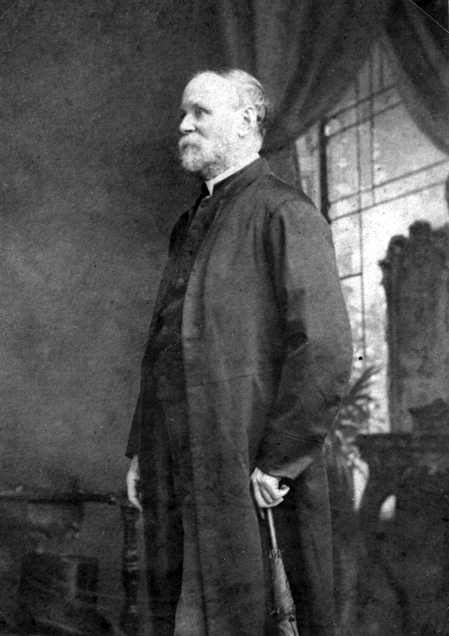 |
|
Arthur Pope, Vicar of Tring 1872-1881. |
Most who have visited Tring will know the Parish
Church of St. Peter and St. Paul, set back from the main road,
dominated by a massive tower at its west end, and topped with a
Hertfordshire spike. This splendid fourteenth century building
in the perpendicular style was constructed using blocks of
Totternhoe stone and rough flints. Far fewer people will be
familiar with the small late-Victorian church tucked away at the top
of Chapel Street. (Some will think the name is misleading, not
knowing that the street took its title from an Ebenezer Chapel which
closed many years ago).
For nearly five-hundred years the old parish church served the
people of Tring and its immediate district, and provided the focal
landmark of the town. It was probably always assumed that no
other church would ever be required for a population that for many
years barely exceeded 4,000.
One man thought differently. The Reverend Arthur Pope, vicar
of Tring from 1872 to 1881, was from a breed of Victorian clergymen
who were not afraid to express ideas forcibly and, in addition, he
most likely considered himself to be far-sighted. He expounded
at length from the pulpit each Sunday, exhorting his listeners,
among other subjects, to pay attention to their hygiene, to settle
their bills promptly, and to abstain from drinking alcohol.
It was reported at the time that many people, perhaps more
interested in entertainment value than their spiritual welfare,
walked for miles each Sunday to hear the Reverend Pope preach.
He seldom disappointed, and it was probably with regret that some
heard that he had resigned his living, to be replaced with a more
conventional parson. Like many clergymen of the period, the
Reverend Pope was a man of private means. This situation
allowed him to spend money on projects that he considered his
‘duty’. Among these was the building of an Infants’ School
with three classrooms, which served the town until the 1970s.
More ambitious was his firm belief that Tring was due for (in modern
parlance) a housing boom. The Reverend was convinced that the
town would expand considerably at its western end and within a
comparatively short time. When this happened, what was
naturally of concern to a conscientious cleric was where the good
townsfolk would worship? He was sufficient of a realist to
know that a walk of well over a mile to the Parish Church every
Sunday would not encourage the attendance of the stragglers from his
flock.
With this worrying thought in mind, Pope decided that another church
must be built and financed from his own resources. Presumably
Mrs. Pope was in agreement, and the project was swiftly put in hand.
It was opportune that around 1880 the famous firm of Carpenter &
Ingelow were carrying out extensive restorations to the Parish
Church, and it is likely that this firm was approached to undertake
some of the work for the projected building. Tottemhoe stone
in the old church was being replaced by harder Ancaster stone, and
some useful saving was made by re-using the old material for the
walls of the new little church.
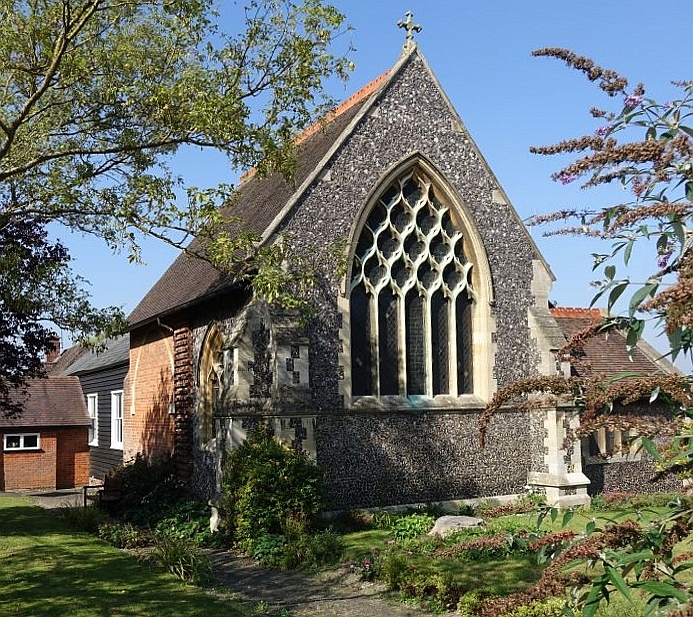
St Martha’s Methodist Church, Tring.
Building work commenced and a fine chancel of uncoursed flint with
stone dressing was constructed. A five-light Gothic window in
the decorated style, with reticulated stone tracery and hoodmould,
was sited in the eastern wall. The whole was topped with a
steep pitched roof of red tiles. A second bay was toothed
ready for a south-side aisle or transept. Sadly, money for the
project was dwindling, and the Reverend decided that for the moment
further work must cease. Accordingly, a stone arch was erected
in this bay and blocked with red brick. The north side,
however, fared better, and a lower-gabled vestry was built of stone
and flint.
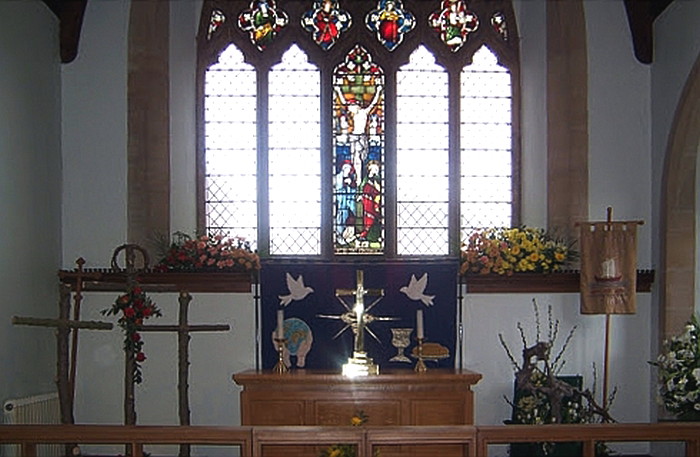
It might also be that the Reverend Pope began to realise that his
predicted expansion of Tring was not happening. At that time
the town did not expand towards its western boundary; in fact, over
a century later this area has hardly changed. About this time
Pope had decided upon the construction of a Clergy House for the use
of the young curates of the Parish. The site was about
two-hundred yards from the new church, and a large Victorian-style
house of totally unremarkable appearance was duly erected. The
Popes were obviously very pleased with the finished result for, when
he resigned his living, they decided to use the house as their own
home. Here the Popes remained until their deaths in the 1920s.
Today, St. Martha’s Church has a strange hybrid appearance, for in
the early 1900s a western arm was built of dark weather-boarding,
with a slate roof topped by a ridge vent. Much later a brick
porch was added. The final result is odd but quaint, and the
church provides a warm and inviting atmosphere within. This is
due in part to the extensive internal renovations of the 1980s when
central heating was installed, the church redecorated, and carpet
laid. A small kitchen was also added. The building was
then better suited to a fuller range of activities, and concerts and
talks are now a regular feature.
In 1975 the Tring’s Methodist community were invited to share the
building with the Anglicans. Money raised from the sale of the
redundant Methodist Church in Langdon Street financed the building
of a new church hall, which now serves both congregations.
During Tring’s festivities to celebrate the Diamond Jubilee of Queen
Victoria in 1897, mention was made of the Reverend Pope’s
benefactions to the town. His rejoinder was typically blunt
and to the point:
“... these things had to be done... the
congregation did not come forward to do them. I was not going
round begging for money, and I did them, to the detriment of my
children’s education. The Parish should be ashamed of
themselves for allowing me to do it ....”
Perhaps this outburst left the assembled worthies on that day
somewhat open-mouthed, but should the Reverend Pope’s ghost read
this article, he can be assured that many generations of Tring folk
have felt gratitude and affection for this gift of little St.
Martha’s Church.
――――♦――――
THE NORTH-WEST FRONTIER
Wendy Austin reports from the Hertfordshire Salient
A glance at a map shows our county is of a fairly compact shape,
except that one finger of land projects on the north-west border.
Over the years proposals that this tongue of land should be included
in Buckinghamshire, which surrounds it, were strongly resisted.
The villages of Puttenham, Long Marston and
Wilstone remained firmly
in Herts. In medieval times this low-lying area, close to the
Vale of Aylesbury, was known by the unattractive name of ‘Blackmire’
or ‘Blackmoor’. The ground was often water-logged, farmland
poor and, even today, one of the longest roads in the salient is
called Watery Lane. The nature of the terrain may be the
reason why Bucks never tried harder to annex it.
When William the Conqueror arrived to claim Harold’s throne, he
chose to make a wide sweep to the west of London, curving north of
the Chiltern Hills. When he turned south towards the capital,
he by-passed Tring, and is believed to have chosen a route through
Puttenham. Whether the poor folk there welcomed their visitor
is doubtful, for William’s army lived off the land and left a swathe
of destruction in its wake. Nevertheless the village’s long
history had adapted it to changing circumstances, and the arrival of
the Normans was just one more chapter. During the medieval era it
was to feel the effects of depopulation; later, during the Civil War,
graffiti evidence suggests that
the church might have been used as a lock-up for prisoners-of-war:
“During the civil war the churches in Hertfordshire, as in other
places, were often used overnight or longer as holds for prisoners.
The graffiti portrait and the signature ‘Anthony’ on the jamb of the
tower door (see below) suggest that Puttenham is yet another
– and the most westerly
– of the Hertfordshire ‘prisoner
churches’ wherein graffiti evidence has survived. After the
defeat of the Royalist garrison at Colchester in Essex by Sir Thomas
Fairfax and the army of the Eastern Association in the summer of
1648 – to take one example
– Royalist prisoners were marched
westwards across Hertfordshire, and this melancholy progress is
still recorded in their graffiti made at stopping places.”
The Church and Manor of Puttenham, by M. C. Vincent (1987)
In the early 19th century (c.1814), the Aylesbury Arm of the
Grand Junction Canal was dug just to the south of the village, where
today there is a canal boatyard.
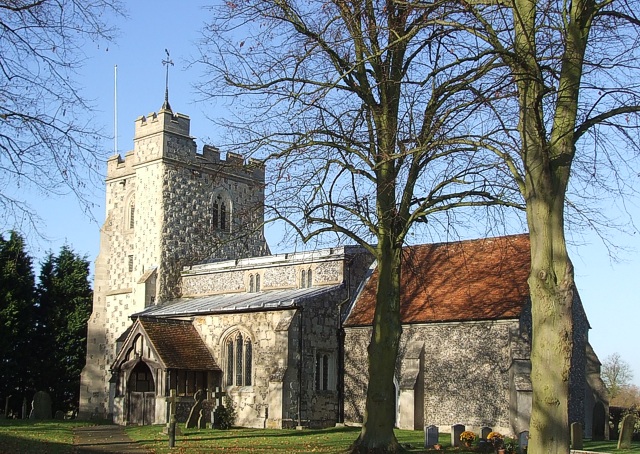
St. Mary’s Church, Puttenham.
Puttenham is still tiny, but boasts a 14th century church set in a
beautiful churchyard. The flint and limestone chequered tower
is one of only two in Hertfordshire. The interior is plain,
for the parish was always poor. A notable item is a memorial
plaque, the lettering telling us that from the parish of 71 souls,
14 young men served in The Great War. Thankfully, and
unusually, all returned safely. In the village one still feels
‘off the beaten track’, but it does have some modern features,
including a smart new village hall and the now ubiquitous barn
conversions.
|
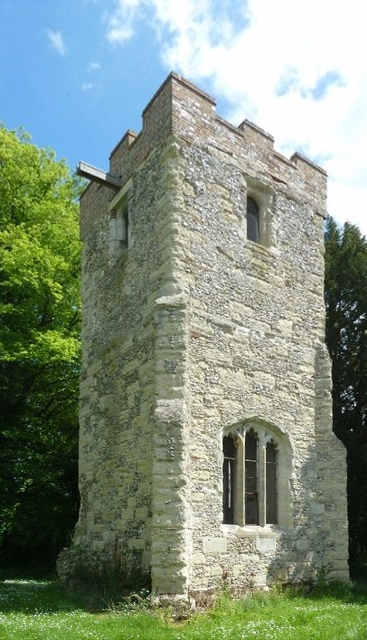 |
|
The remains of the original All Saints’ Church
Long Marston. |
Unlike Puttenham, its near neighbour of Long Marston
has greatly increased in size over the years. A narrow stream, a tributary of
the Thistle Brook, meanders alongside a lane to Church Farm, and a
delightful half-timbered cottage. In the garden stands a Grade
II listed church tower dating from the 14th century. It is the
only part that remains of All Saints’, a chapel-of-ease of Tring
Parish. The old gravestones and surrounding yew trees create
an atmospheric feel. In the past the inhabitants of Long
Marston were obliged to help maintain Tring Church, and their
slender resources could not be stretched to keep their own small
church in good repair. The building deteriorated, became
unsafe and, except from its tower, was demolished in 1883. A
new All Saints’ in the north of the village was built in 1882-83.
The old manor house encircled by a moat (for drainage, not defence)
has long since vanished.
Events of more recent times have affected life at Long Marston. As
the rail network grew, branch lines sprang up linking many remote
parts of the country, and Long Marston benefited from an offshoot of
the newly opened London & Birmingham Railway. In 1839 a branch
line was opened from Cheddington to Aylesbury, its sole intermediate
station being sited at Marston Gate, about 2 km along the road to
Wingrave. The line was important for Aylesbury, securing it a
cheaper means of bringing in essential goods and sending out its
agricultural produce, as well as greatly improving passenger
communications with the rest of the country. However, during
the twentieth century the branch gradually lost business as more
convenient railway routes opened into Aylesbury; London could be
reached directly by either of two other routes, and northward
journeys were convenient by the Great Central Railway.
Passenger traffic on the branch fell away and the line closed to
passengers in 1953. Goods traffic continued until 1963, when
the line was finally closed and taken up, its station at Marston
Gate eventually becoming a tasteful private dwelling named “Beeching
House”.
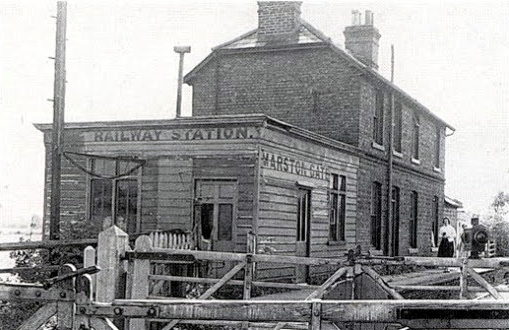
Marston Gate Station.
World War Two disrupted life in the village as everywhere else.
In the late afternoon of 30th January 1941, a stick of bombs fell,
demolishing The Boot public house as well as the village
school. Mercifully, the children had already gone home but
Ruth Whelan, the infants’ school mistress, was killed in the
explosion. Two other bombs fell in open country and did no
damage. It was never established why the bombs were dropped in
such a quiet country area.
In 1942 land in the area was requisitioned from local farmers for
the construction of an airfield to be used by the US Air Force.
Fields were levelled and trees uprooted; 92 tons of concrete were
used to build three runways. During the war the airfield had
many uses, including a base for aircraft dropping propaganda
leaflets over Germany. Also a branch of the CIA were said to
be stationed there. Among the famous names who flew from the
airfield were Eliot Roosevelt (son of the President), James Cagney
and James Stewart. There was accommodation for 2,500 personnel
and Tring and its nearby villages reeled under the impact of this
influx. The district shook off wartime blues and came
alive, especially on Saturday nights when the US forces flocked to
any dance or entertainment on offer. Some local girls married
service men, and at the end of the war sailed for America.
During the course of the conflict, 68 men were lost from this
station and a memorial plaque was erected in the 1990s.
Beyond Long Marston and almost at the northern limit of the area lie
the deserted medieval villages of Alnwick, Boarscroft and
Tiscot,
discovered in the 1920s by aerial photography. The scourge of
the Black Death often takes the entire blame for the disappearance
of established settlements, but the underlying reasons are complex
and more likely to be land exhaustion or climate change. In
former times this locality was known to be a venue for
cock-fighting, a ‘sport’ which became legally liable to penalties in
1849. In some remote country areas, this cruel pastime
continued, and the site was chosen carefully to allow a quick
get-away over the county border when the approach was signalled of
local constabulary.
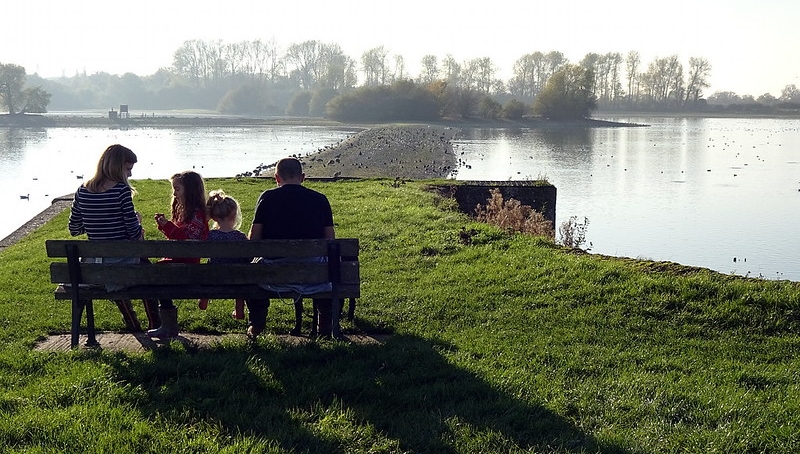
Picnicking on Wilstone Reservoir, the largest of the
four
Grand Union Canal reservoirs in the area.
At the opposite end of the salient is the attractive village of
Wilstone, with its composite village green and larger reservoir.
The nature of the landscape made this the ideal spot in the early
19th century to conserve large areas of water. The Wilstone
reservoir, together with smaller ones at Marsworth, Startopsend and
Tringford, supply an average of two million gallons each day.
This ensures that, at 400 feet above sea level, the summit of the
Grand Union Canal always has a sufficient supply of water, pumped
from the pump-house at Little Tring. Today, as well as their
original purpose, the four reservoirs are a wildfowl reserve and
attract winter migrants, as well as being home to the Great Crested
Grebe, many kinds of ducks, and reed-nesting herons. Walkers
and bird watchers are assured of refreshment at Startopsend from the nearby
Waters Edge cafe, but
the since January 2012 the White Lion public house, which
stands adjacent to lock 39 of the Grand Union Canal, has lain
derelict.
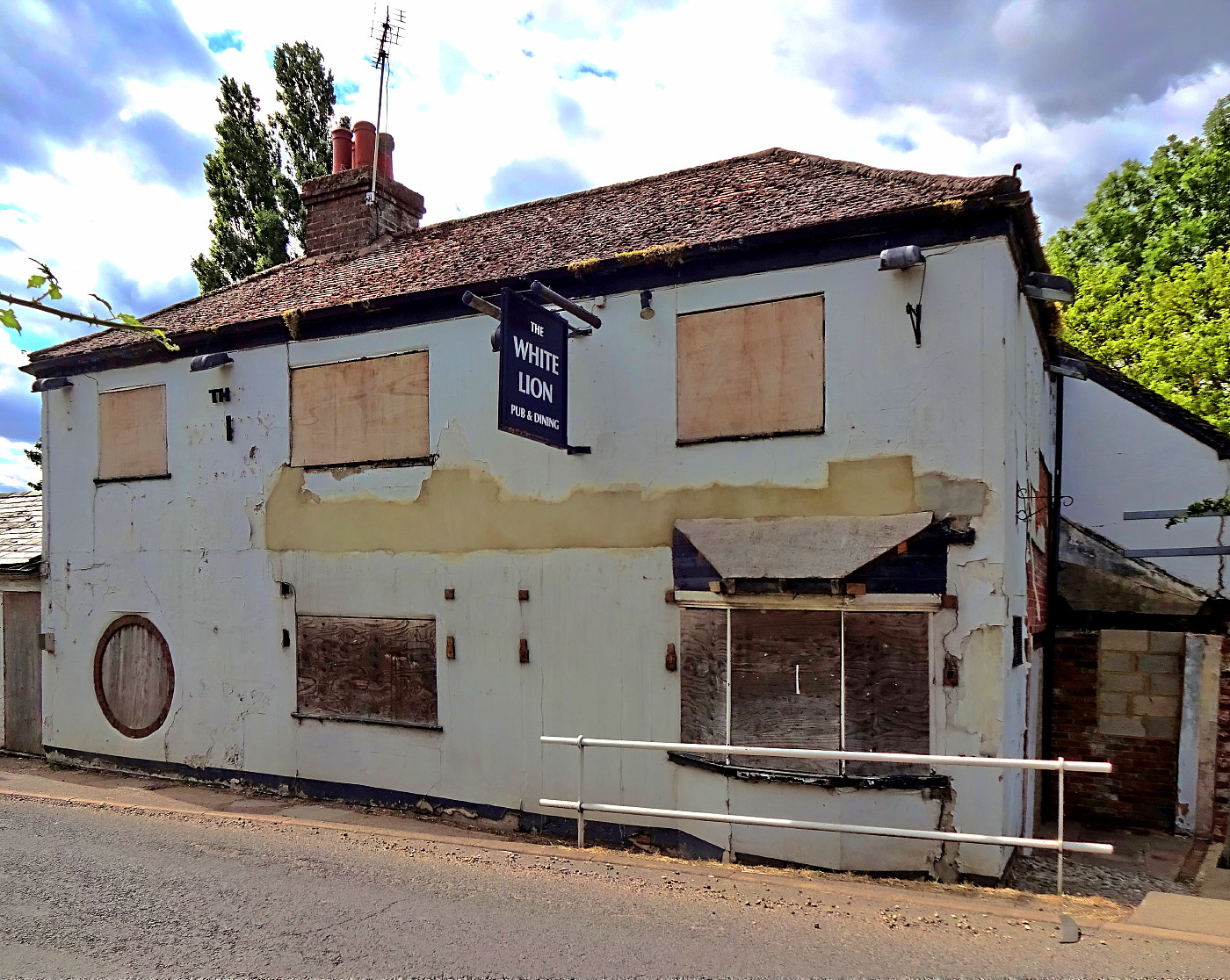
The White Lion, Marsworth.
Although there has been the inevitable increase in traffic, and the
lanes of the area are usually busy, this remote corner of the county
rewards a visit with much hidden charm and interest.
――――♦――――
GRAVELLY FURLONG
Notes written by Joseph Budd (1886-1977) of King Street, c.1950‘s
There was a time when almost all Tring was contained in Akeman
Street, Frogmore Street and High Street, with the numerous Yards,
Courts, Alleys, Places etc. opening off them. Albert Street
did not exist; two old cottages in Akeman Street, between what are
now numbers 63 and 64 were demolished to make the opening.
Fifty years later Albert Street was still ‘New Road’ to the older
inhabitants.
The land which now carries Langdon Street, Charles Street, King
Street, Queen Street etc. was known as the Gravelly Field, or for
legal and documentary purposes ‘the Gravelly Furlong‘. This
had been part of a ‘Strip Field’ during the time of the open field
system, and probably had almost as many owners as ‘strips’ in the
beginning, but with the passage of time (a long time) it got into
fewer hands, and by about 1820 a few people owned quite sizeable
pieces. Among them were the Catos, with their houses and
canvas factories (weaving shops), a trade introduced by refugees
from religious persecution on the Continent of Europe.
A few more houses and cottages followed, and by 1859 they numbered
between twenty and thirty, scattered about the field. Before
this however, in 1828, Mr Elliman, the draper, planted his five
acres with ‘Locust’, 25,000 plants which he bought from William
Cobbett M.P., author of the famous ‘Rural Rides‘. These plants
did so well and pleased Mr Elliman so much that in the following
year he invited Mr Cobbett to visit Tring to see their progress.
This he did, and arrived in September. He described Tring as
“a very pretty and respectable place”, although he thought Mr
Elliman’s field was “very indifferent land”, and so took the more
credit for the Locust doing so well.
While he was here, a dinner was arranged at the Rose & Crown to
which he was invited, together with about forty-five gentlemen and
tradesmen of the district. He had a great time at this party,
and wrote afterwards that he had never found “even in Sussex” a more
hearty, sensible, entertaining, and hospitable company than this!
This is corroborated by the fact that they sat down at 2 o’clock and
rose at 9. The chairman at this dinner was the local
solicitor, Mr Faithfull. What a good name for a lawyer!
Mr Cobbett’s description of “very indifferent land” links up with
the name of Gravelly Field or, more exactly, Gravelly Furlong.
The subsoil hereabouts is not clean chalk, but a dirty stony mess,
which used to be called ‘hurbuck’. The old wooden swing
ploughs would have brought some of this to the surface, hence the
name, Gravelly. About sixty years ago an attempt was made to
dig gravel for use, but the product was too dirty for anything and
it was soon discontinued.
The first twenty or thirty houses and buildings seem to have been
set in the most haphazard places, and the street plan seems to have
been made to fit them. An exception is Park Road, which at
that time was know as Park Street West, or alternatively, West
Street. This extended from the top of Akeman Street to what is
now Chapel Street. From here to the ‘Britannia’ was Dark Lane.
Chapel Street, before the chapel was built, was Windmill Lane -
remember there was no Western Road, so it was one lane right
through.
After about 1860 more and more building took place, and this led to
the layout as we see it today. The rate of growth so impressed
the Rev. Mr Pope (who became Vicar of Tring in 1872), that he had St
Martha’s Church built, and also the big house, The Furlong, which he
intended to be a kind of hostel for Curates and young men training
for the Ministry.
Taken as a whole, the building on the Gravelly Furlong was well
diversified for the period in which it took place. Although
much of the building was cottage properties, many of them built in
blocks of four, there were a number of small shops, including a
couple of bakers, complete with bake houses. Then there were
the various chapels, the church, and later on the Gravelly School,
built on land donated by Mr Pope.
In addition. to the ‘weaving shops’ there were several other
commercial premises. One of these was Hilsdon’s Engineering
Works near the western end of King Street. The machinery here
was driven by a steam engine, and when the works closed down the
boiler was left in position and used as a rainwater tank, a function
it performed for many years.
Down the street, and next to the school, was the house, yard and
workshop of Mr David Osborne, builder and undertaker. In the
latter capacity he carried out many ‘parish funerals‘, the last
rites for persons for whom no money was available to pay for a
funeral. The Parish authorities would pay five or six pounds
which had to cover the digging of a grave, providing a coffin, and
conveying it to the cemetery in a reverent and respectable manner.
In his capacity as a builder he erected quite a few cottages.
A document still exists in which he undertook to build four cottages
at Wigginton for thirty-five pounds each, one hundred and forty
pounds for the four, with a further sixty-five pounds for ground
work and excavation. A paragraph in this document promises
that “all work shall be carried out to specification and
satisfaction”. These cottages are no longer in existence,
having been demolished to make way for a pair of semi-detached
houses. Had they been still standing, it would have been
interesting to ascertain what their present value was supposed to
be.
The property next to Mr Osborne‘s was owned by a Mr Carter, but
about 1879 he sold it to Mr Alfred Fincher, and for the next fifty
years it belonged to him and his family. Mr Fincher was
primarily a coal and wood merchant, but his horses, carts, and men
also did a good deal of cartage work for the Tring Park estate.
A good price for the hire of a horse, cart and man was seven
shillings a day 7 a.m. to 5 p.m. The usual rate for tonnage
work was for many years one and sixpence per ton to any part of the
town, to or from the Station.
The site of the ‘Kings Arms’ public house nearby was obviously
chosen for its strategic position at the junction of three or four
streets, and like the ‘Britannia’ it faces approaching west to east
for travellers. Both these houses were designed by or for Mr
John Brown, the brewer, and their substantial appearance was a great
contrast to the cottage-type beer-houses, of which several had
opened in various parts of the town by paying an Excise Licence of
two pounds.
Mr Brown evidently expected some upper-class customers at his pubs,
as at both he installed mounting stones for equestrians. By
the way, the story of these stones is interesting. When the
London to Birmingham Railway was made, the rails were laid on wood
or steel sleepers as at present, but on pairs of stone blocks.
This system was not at all satisfactory, so the stones were taken
out and sold. When placed one on two they were ideal for
getting into the saddle even after several stirrup cups.
The stable block at the ‘Kings Arms’, with accommodation for six or
more horses, would seem to indicate that they could have been riding
horses for hire, as the coach-house would have accommodated only one
vehicle. The stable part is now used as a corn merchant’s
warehouse, while upstairs the former hay loft is a useful room for
many small functions and meetings. A good walled garden was
included in the tenancy of the ‘Kings Arms’ but a few years ago,
after a takeover by a different brewery combine, the garden was sold
to a speculative builder, as was the one belonging to ‘The
Britannia’. This sale of the K.A. garden was carried through
so quietly that not even the tenant knew anything until it was a
fait accompli.
When this part of the town was built, properties were dependent on
wells for their water supply, but after a time water mains were put
in by the Chiltern Hills Spring Water Company, and gradually houses
were connected and eventually the wells were filled in. A
hydrant was erected near the K.A. to which the Fire Brigade hoses
could be attached in the case of a nearby fire, but its main purpose
was to fill the water cart. The streets being made of flints
and not tarred, they became very dusty in dry weather, and the
watering was necessary to lay the dust.
Before Charles Street and Upper Albert Street were properly built
up, a weaving shop stood on the land between them. This was
the property of Mr ’Scrag’ Cato (why ’Scrag’ we shall never know,
but thus he was usually called). A disastrous fire destroyed
the old place in l907, and a new building replaced it. This is
now a clothing factory.
The Methodist Chapel in Langdon Street was not one of the early
buildings, but even so will attain its centenary in 1970, which is
rather surprising when one looks at the neat and well-preserved
exterior. This chapel has always seemed to have a lively and
faithful congregation. The same could not be said for the
other two chapels in this part of the town. They both came
into existence at a time when ‘Sectarianism’ was a key word among
the Baptist community and for a long time each had its regular
attendants.
In the 1880‘s a new word cropped up which recognised that ‘Union is
Strength’, namely Inter-denominallisation, and in 1889 the new
chapel in the High Street was built under the name of The United
Free Church. In the course of time lack of support caused both
the old chapels, with the strict dogmas, to be closed. The
Western Hall in Western Road became derelict and has now been
demolished, while the Ebenezer in Chapel Street, being in better
structural condition, was sold for £250 pounds freehold. It
was later sold to the present owners, for whom it is a useful
warehouse.
Some of the land below the chapel was the property of Mr Gutteridge,
and he had some small cottages built in Chapel Street and New
Zealand Place. The young man who built them worked in quite a
lot of large flints into the walls. As he explained many years
afterwards “there were plenty of flints laying about, and
every time I used one I saved a brick”. New Zealand Place was
demolished in 1913, and the site made into a garden, but the other
cottages still survive.
――――♦――――
SURREY PLACE IN 1912
Notes written by Joseph Budd (1886-1977) of King Street, c.1950‘s
During the years before the first World War a good deal of slum
clearance took place in Tring. Among the sites cleared were
Saws Alley and the Square in Frogmore Street, the Harrow Yard,
Denmark Place and Willow Court in Akeman Street, and the Eighteen
Row at New Mill. Other properties were in line for the same
treatment, and among the next to be inspected were West Passage and
Surrey Place. These cottages were the main source of income
for their owners, and closure would have been disastrous, as in both
cases they were pronounced “unfit for human habitation”.
After a good deal of persuasion the Sanitary Inspector agreed to
give them a little longer, say, four or five years, provided they
were put in better condition. Much painting and papering was
done, windows and rain water gutters were mended, and odd pieces of
damp course inserted to deal with rising damp. At the next
inspection it was agreed they would do for a few more years.
This was in 1912 and before the period elapsed the Great War
started, which put an end to all these plans, and by the time the
War ended the “sentence” had been forgotten. New people were
in charge, the cottages were not “not too bad”, and so the four or
five years grace has stretched out to more than fifty years.
At the time (1912) when all this took place, one of the residents in
Surrey Place was Mr Harry Taylor. Here was a man who had seen
life in many aspects. As a young lad he went into “private
service” as a pantry boy in a big house. In course of time he
became a “footman”, and moving from one job to another as
opportunities for promotion cropped up, he eventually became a fully
qualified Butler. His last three employers in this capacity
were the Duke of Macclesfield, Lord Howard de Walden, and the
Archbishop of Canterbury (not necessarily in that order).
While working for the last of these, whichever it was, he had an
illness which affected his hearing, and left him partially deaf.
To carry out his duties properly he needed to hear extra well.
He therefore had to leave, and came home to Tring to live with his
sister. The only job he could get was as a Council dustman,
but the drop in status never seemed to worry him. His
philosophy was “it doesn’t matter what job you do, so long as you do
it well.”
Ed. At this point, I regret, Joseph’s account reaches an
abrupt end.
――――♦――――
JOSEPH CAN HEAR THE VOICES OF TIME
From the Hemel Hempstead Evening Post-Echo
28th December, 1970, by James Buxton
A town faced with invasion by 2,000 Greater London Council tenants
is spending one week next year commemorating another invasion - the
Saxon invasion of 571 when the town was founded. The man who
made it all possible, by tracing the town’s history back to that
date has witnessed 84 of those 1,400 years, during which time voices
have provided vital clues to his historical detective work.
For Joseph Budd has lived in Tring all his life and has spent the
last 40 years in the same house without a bathroom in King Street.
A few years ago he wrote an essay [see Notes on the Origin of
Tring, below] on Tring’s history. It was
designed to show why Tring was an integral part of Hertfordshire and
should not be annexed by neighbouring Buckinghamshire. The
essay, which went to the town’s councillors, named 571 as the date
when Tring - and the villages nearby - was settled by the Saxons.
Councillors have long memories and the year 1971 was pencilled in
diaries as the year for celebrations.
.JPG)
Mr & Mrs Budd on their Golden
Wedding, 1961.
Joseph, who married his 80-year-old wife 60 years ago next year, has
more than an eye for the history books. He can feel himself
back into the past and has filled precious school notebooks with his
writings on Tring’s history.
Killed off
His family have been quite a part of it. His grandfather died
140 years ago - 1830. “When I was four, in 1890, I was taken
to see my great grandmother who as born in 1796. She was 94 at
the time and that gives us a span of 174 years,” said Joseph.
He first observed remnants of the town’s origins when he was a small
boy: “I noticed that the people who lived in the hills south-east of
Tring spoke and looked different to the people who lived in Tring,
and the people who lived to the north in the Vale of Aylesbury were
different too. Nowadays, of course, you couldn’t tell the
difference. People move about more and the BBC has almost
killed off the dialects. But in those days a man wouldn’t
marry a girl from a village very far away and when I went down to
Tring market I could hear all those different dialects and tell
where everyone came from.
“And when I went to Sussex once, I noticed that the people on the
coast at Angmering and Bognor and Lancing were like the people on
the hills: they were all Jutes. The men had big elbows and raw
bones and the women were short and stocky. The reason was that
the people in Tring, on the Chilterns and in the Vale, all came from
different tribes,” he said. “Up to AD 570 the Angles, Saxons
and Jutes who lived in England mostly kept south of the Thames.
They were held in place by the Chiltern Hills and the Roman and
British fort at Calleva, or Silchester. But in 570 a tribe of
West Saxons, the Gewissas, moved up from Hampshire where they had
settled on the coast. Led by Cuthwolf, they took Calleva and
crossed the Thames at Wallingford.
“The whole of the South Midlands was opened up to them and they
followed the Icknield Way to the north-east and defeated the British
at Bedford. They settled in the Vale, and each family - like
the Cublingas, Ifingas and Ceadingas - set up separate homesteads at
places like Cublington, lvinghoe and Cheddlngton.”
Occupied
“And a tribe of Jutes from Sussex, who had helped Cuthwolf at
Calleva, moved into the hills south of the Gewissas. They were
led by Cilternsetan and they called the hills the Chilterns.
“Then two more tribes of Saxons moved up from the south. One
settled in Middlesex - the middle Saxons. The other went
farther north into West Hertfordshire. The family which went
farthest to the north-west were Tringas and when they got to the top
of Tring Hill, they could see that the country was occupied by the Gewissas on the plain and the Jutes in the hills. So they
settled in the valley and founded Tring. And that was in 571.
And that explains why the strip of Hertfordshire sticks so far into
Buckinghamshire.”
The chroniclers of the time, said Joseph, told that the area was
virtually unpopulated when the tribes moved in. The families
set up their homesteads and the land they farmed was cut off from
the next homestead by waste land. Each family sent a man to
the local hundred moot, and each hundred moot represented ten
families. Tring was the centre of the Tring hundred.
NOTES ON THE ORIGIN OF TRING
by Joseph Budd (1886-1977)
From time to time someone looking at a map argues that Tring should
be in Bucks. As there has recently been a revival of this
suggestion, the following notes on the origin of Tring may be of
interest.
The origin of many towns is “lost in the mist of antiquity” but we
are able to fix the exact year in which Tring came into existence.
The year was 571 A.D. and it was not as a town or village, but as a
Saxon MERC or MARK. This consisted of ten households, each living on
their own separate small farm. The Mark was the basis of Saxon land
organisation, and as they were occupying country from which the
Britons had been either driven out or extinguished, they were able
to set out the Marks in what they considered the most advantageous
places.
Saxons, Jutes, Engle and Friesians had been making settlements in
Britain for nearly a hundred and fifty years but had not been able
to get very far from the coast. In 520 A.D. a tribe of West Saxons
(called Gewissas) settled in Hampshire but were prevented from
spreading Northward by the great fortress of Calleva Atrebatum,
which stood where Silchester now stands.
After fifty years, by the natural increase of population and
continued immigration from their homeland, they became strong enough
to besiege Calleva and eventually to capture and destroy the city
and kill all the inhabitants. They then advanced to the Thames,
which they crossed at Wallingford, as the Romans had done hundreds
of years earlier. Then, under the command of Cuthwulf they proceeded
to pillage and ravage the “District of the Four Towns”. The four
towns were Eynsham, Bensington, Lenborough, and Aylesbury, and their
“district” comprised most of Bucks. and part of Oxfordshire.
The Britons gathered an army together, and met the Saxons at
Bedford, but in the ensuing battle were defeated, and had to flee,
leaving more than five thousand dead. This left the Saxons free to
spread out and settle on the conquered territory. Among the families
who came eastward were the Cublingas, Billings,,Qeadingas, and
Ifingas, who settled reepecttively at Cublington, Billington,
Cheddihgton, and Ivinghoe.
Just at this time a tribe of new immigrants came up the Thames,
bypassed London, and spread out over west Herts. The family who came
farthest were the “Tringas”, and they might have intended to go even
further, but when they got to the top of the hill (Tring) they would
see that the country to the West and North was already occupied by
the Gewissas, while to the Southward a party of the Cilternsetain
(or Chilternsetna) called Bellinghas had settled at Bellingdon. They
would therefore have marked out an area of land roughly comparable
with the present Parish of Tring or a little larger. Looking at a
map, this appears to be an intrusion into West Saxon country, but
this was not so, as the Marks were deliberately set out with plenty
of “waste” or common land between them.
As time went on, the country became divided into East Saxon and West
Saxon kingdoms, and at all times this bulge in the frontier was
always recognised, and Tring was at all times East Saxon. This
Arrangement continued for more than two hundred years, up to the
time of the “Danelaw”. By this time, counties had been organised,
and assessed for sums of money to buy off the Danish pirates who
were a great nuisance at this time. Definite boundaries were
therefore necessary, so “Hertfordseir” and “Buccenhameseir” got
together and agreed on a line which has survived almost without
alteration to the present day.
One would have thought that after 1394 years Tring could be left
where it is, and to look forward to its fourteenth centenary in
1971.
――――♦――――
THE VICTORIA WORKS, AKEMAN STREET
by Wendy Austin
The ‘Grand Opening Night’ of Tring’s splendid, newly-built Victoria
Hall occurred in January 1887. Designed by local architect William Huckvale
and erected on the site of the old
Assembly Rooms in Akeman Street, it was rather grandly described as
being in “the Italian Renaissance style”. It provided a large upstairs hall suitable for dances, functions,
dinners and amateur dramatics, as well as ground-floor rooms for use
as a reading room and library for the town’s Conservative Working
Men’s Club, together with smaller committee rooms. The entire
cost of the project was met by Thomas Tompkins, a local businessman
whose firm supplied the ornamental ironwork on the staircase
balustrades.
|
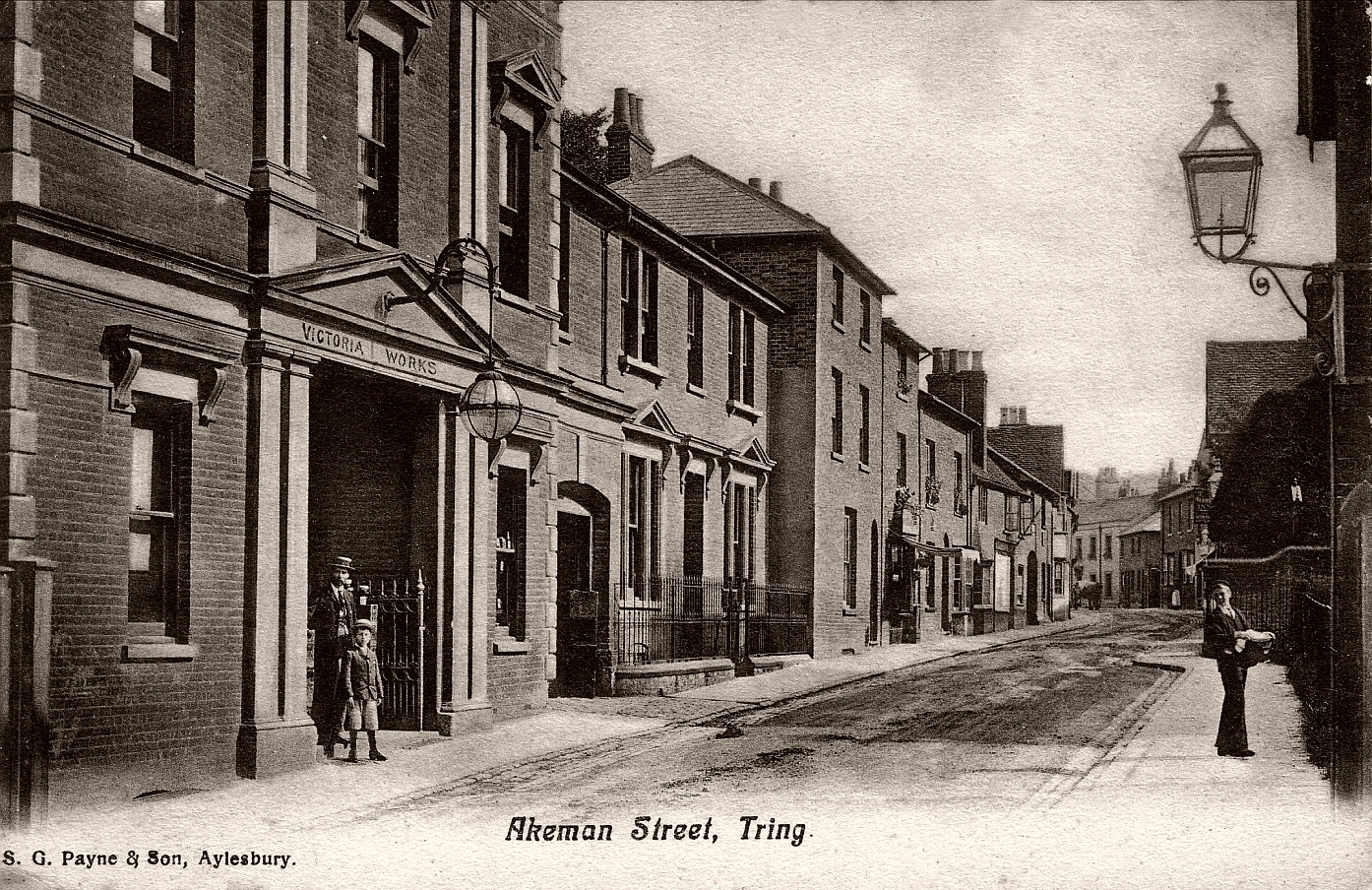
The
Victoria Hall in its pickle factory days
The sign over the doorway reads
‘VICTORIA WORKS’.
|
However, by 1901 the hall was considered to be under-used and a
more practical use was considered necessary. Rather surprisingly
it was given over to the manufacture of mineral waters, cider, jam
and pickles. This measure was intended to provide much-needed
employment as well as adding to the town’s prosperity, following the
demise of some traditional industries such as silk throwing, straw
plaiting and canvas weaving. The opening of the new Victoria
Works was reported in the Bucks Herald of August 1901, the
report explaining clearly what was happening at that time:
“The Hertfordshire Cider
and Preserve Company (the shares in which are held chiefly by local
gentlemen) has rapidly converted the Victoria Hall into a factory,
where the manufacture of cider, mineral waters, pickles and
preserves is carried on under the most healthy conditions.
“On entering the building, a most appetising smell greeted one.
The entrance hall was littered with casks, crates, boxes, and in the
long passage at the back were thousands of bottles and jars.
At the back of the premises are the engine, boiler, mineral water
making, bottling, corking, and bottle-washing machinery…… The
great aim of the Company is absolute purity in all they manufacture.
Water from the Chiltern Hills Spring Water Company is used, but this
is specially filtered before entering the mineral water machine,
which is silver lined throughout….. Bottles are placed in a
frame, which revolves in such a way that each is thoroughly soaked
throughout with boiling water …..”
There follows a lengthy description of the manufacturing process of
mineral waters and the preparation of various syrups which formed
the foundation of the different products. The account continues:
“In the pickling room
several girls were busily engaged and in the store room were the
great copper pans used for jam making. Eleven hands are at
present employed in the works and the directors hope to add to the
number every week………. In the large hall cider presses will
shortly be installed. ……….. Orders from some of the principal
towns in the Midlands come in daily, and local grocers are stocking
the goods.”
An entry for Tring in a trade directory of 1902 lists the company
also producing table jellies, vinegar, liqueurs and preserved
fruits. It is mentioned in the London Gazette of 1911
but then records go silent. Perhaps the venture failed to
prosper, but in any case during World War I the Victoria Hall was
requisitioned by the army to function as a military hospital.
With the arrival of peace it was purchased by the Rothschild family,
and given to the Council for public use, the large downstairs room
being made over to the British Legion.
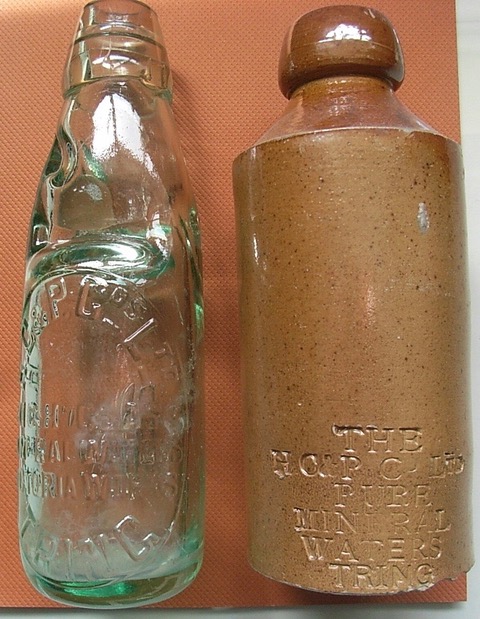
A few glass and stoneware bottles still survive from the company
days, bearing the inscription H.C.& P. Co., Victoria Works, Tring.
――――♦――――
THE OTHER ALBERT HALL
Forget the dominating and magnificent edifice on the south side of
Kensington in London, as many and varied were the structures erected
to the memory of Albert, the Prince Consort. Some people may
not know that one such existed in Tring; unsurprisingly, it could be
found in Albert Street.
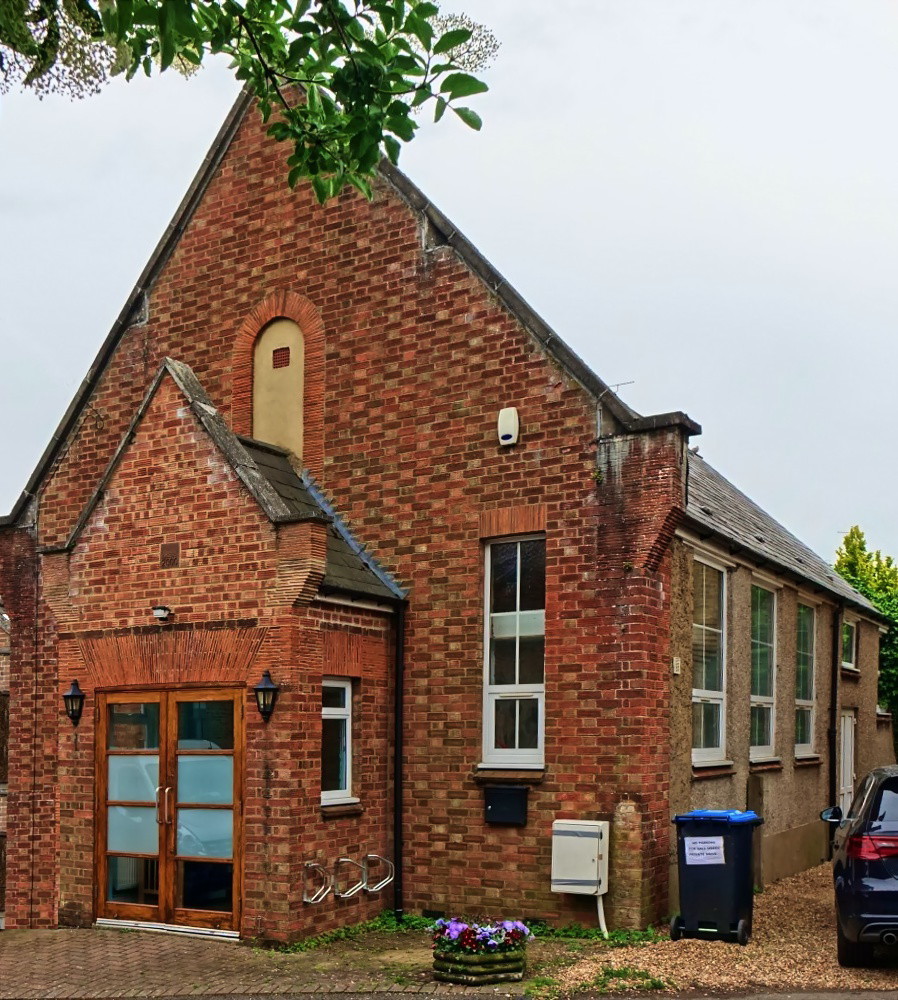
The former Salvation
Army hall in Albert Street, February 2014
Its origins are obscure, but by the 1880s local newspaper accounts
show the hall served a useful purpose as a venue for various events
and meetings. For example, the Mothers’ Union gathered in the
hall; the Church Lads’ Brigade used it for band practice; William
Brown, the land agent and auctioneer, held sales there; technical
classes were run by Dr Spurway, who lectured on sanitation, nursing,
and first-aid, all of which were described as “useful to the wives
and daughters of working men”.
Also it served as a useful space in which to hold
bazaars and rummage sales. At that time, the latter were
obviously a novelty, as one account shows it was necessary to
explain to readers exactly what was a ‘rummage sale’. The
account reads:
“…… on Saturday 25th ult,
the Albert Hall presented a remarkable scene. At the invitation of
the Vicar, the parishioners had ‘rummaged
out’ the contents
of their attics, storerooms, closets and dark corners and had
collected what had been cast aside as worn-out and useless, to be
sent to the Hall, to be sold for the benefit of the fund from which
the little expenses of the Parish Charities are defrayed. On
the previous day, the donkey cart of Cogger, the sexton,
perambulated the town going from house to house collecting the
things that had been turned out for the sale ………………..”
The Albert Hall also became the central point for the
serving of what were known as ‘Penny Dinners’. Organised by
Tring District Visiting, a national C. of E. charity organisation,
cardboard tickets (later metal discs) were distributed to the more
deserving children of the town by their school teachers, these
tokens to be exchanged for a nourishing meal. The food and
money was donated by well-off citizens of the town, the subscription
list being headed, of course, by Lord Rothschild. According to
one Tring historian the meals were plain but sustaining, e.g. pea
soup, Irish stew and rice or jam pudding, and in the first year of
the scheme, 1,307 tokens were issued.
|
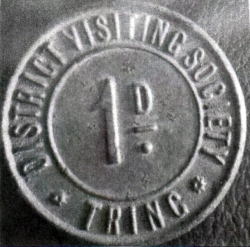 |
|
‘Penny Dinner’
token |
By the end of the century many other general
gathering places had sprung up in Tring, and possibly the hall
became under-used, as the premises were then shared with Henry
Stevens, a town councillor who owned a shoe shop at No.15 High
Street. He set up a small factory in the Albert Hall which he
called ‘The Shoe Mart’ and advertised his wares for sale in The
Tring Gazette; examples of his boots and shoes were also
exhibited with great pride at Tring Agricultural Show and other such
events. This operation was closed down and sold in 1899.
A year later the premises became a meeting place for members of
Tring Salvation Army who, up until then, had worshipped in what was
described as “a draughty uncomfortable little carpenter’s shop”; the
Albert Hall then became known as The Barracks. What happened
over the next 20 years is unclear, as an advertisement of 1924
states that the premises were owned by Messrs. Rodwell & Sons who
offered it for auction citing that it was ‘a good site for a small
factory or similar’, but even so it failed to attract a purchaser.
But a little later the premises were acquired by the Salvation Army,
and approval for erection of a new building, at an estimated cost of
£1,550, on the site of the Albert Hall was granted in July 1926,
with demolition a few months later. The following year The
War Cry was able to report on the opening ceremony of the new
Citadel:
“…… for some years the
comrades of Tring have laboured under the disadvantage of having no
permanent building in which to hold their meetings. This came to an
end last Saturday when, amid scenes of enthusiasm mingled with
praise and gratitude to God, they entered their new Citadel ………
There was good reason for ‘enthusiasm’ as the Tring branch of the
Salvation Army had waited 38 years before attaining its own meeting
place. Major modernisation of the premises were carried out in
2001, but the history of the Salvation Army in the town came to an
end in 2014 and the building then became an arts and education
centre. At the time of writing, it serves as Tring’s Yoga
Studio.
Wendy Austin
――――♦――――

|
|
